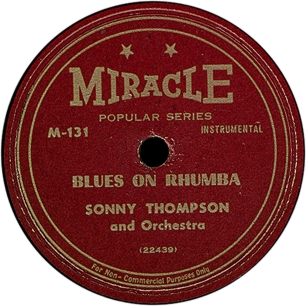
Revision note: A close long at Michel Ruppli's discography of The King Labels has turned up a previously unknown issue of two Miracle masters on Henry Stone's Rockin' label. Rockin' 521, released in 1953, was credited to "Royal Brent," a pseudonym that Thompson occasionally used at King when he was the vocalist on a side. Not having heard this rarity, we don't know which take of "Dreams" or of "Danny Boy" was used, but we do have evidence of a release on each. Prompted by an email from Marv Goldberg (March 28, 2024), we have corrected the dates for Johnny Desmond's TV show (on which the Four Vagabonds appeared). Marv Golberg's research on Gladys Palmer, besides dispelling multiple tall tales that Palmer told about herself, has led us to correct our attributions on takes of "Fool That I Am." It turns out that Miracle released an edited version of the long take 1, whereas take 2 was used on a Federal release after Syd Nathan acquired nearly all of the Miracle masters. Goldberg's research on Bill Samuels has convinced us that the vocal harmonies on several sides from his first session for Miracle could not be the work of the Vagabonds. A brief article by Mike Rowe ("The Miracle/Esquire Mysteries," Bits 'n' Pieces 16/1) corrects a couple of errors we had made about reissues on the British Esquire label, then documents at least two releases that appeared only on Esquire (with artists wrongly identified). We will be adding new information on Browley Guy, also courtesy of Marv Goldberg, who has done extensive research on him (see http://www.uncamarvy.com/BrowleyGuy/browleyguy.html). We can finally report something about Miracle 138, from John Sellers' second session for the label. We've made a few minor corrections to our Sunrise listing. Marv Goldberg also pointed out to us that the guitarist in the Sharps and Flats was Arvid Garrett, not "Arvin." We have concluded that the 6 sides by accordion player Joe Petrak, which appeared on Old Swing-Master in 1949, were not originally recorded for Miracle. We have corrected the recording date for the first two Tommy Dean sides, released on Miracle 135, which were probably cut in Saint Louis. Our thanks to Galen Gart for reminding us that the vocal on "Jump for Joy" is credited on 135 to Pee Wee Matthews, a blues singer then active in Saint Louis. Dean's signing to Miracle was announced on April 30, 1949. We have finally been able to provide a real biography of Lee Egalnick, and to supply further details about Miracle's first year in business. We have added to our coverage of Rudy Richardson, who went to Manor after his two sessions for Miracle, then recorded more extensively for Manor than we'd realized. With help from Mary Unger of Ripon College, we have identified the mysterious S & S Studios. They were located in the back of Lew Simpkins' bookstore.

Chicago-based Miracle Records, in operation from June 1946 to May 1950, was a typical post-World War II independent operation. The company focused its recordings on a particular niche market, the African-American community, and released a variety of rhythm and blues recordings that sounded fresh and new next to the tired "Bluebird Beat" that the majors were putting out. Unlike Aristocrat—a similar Chicago independent that arose a few months later—Miracle did not record the deep Mississippi Delta style blues that was growing in appeal in the city. Instead the company put out balladeers, rhythm instrumentalists, and uptown blues singers. Miracle's recordings represented an era when jazz, rhythm and blues, and pop were not so carefully divided into different musical camps. Jazz musicians were viewed as entertainers as well as artists—as part of the same African American recording world that was producing ballads, blues, jive, and rhythm numbers.
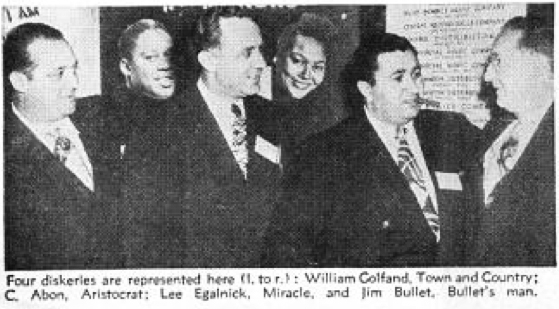
Miracle Records was officially launched in August of 1946. (Recording started in June of that year—see below.) Lee Egalnick served as president of the firm. Lew Simpkins was Egalnick's partner from the beginning.
The Social Security Death Index includes a Lee J. Egalnick who was born June 1, 1921, and was issued his Social Security card in Illinois. Leo L. Egalnick, as he was called in his younger days, was born in Chicago. He was the son of Sam Egalnick (born December 17, 1895) and Celia Turner Egalnick (born July 12, 1899), who lived at 7500 South Phillips Avenue, later at 7719 South Phillips. Leo had an older brother, Charles (born April 12, 1918), and a younger sister, Margaret (who was born October 3, 1929).
He enlisted in the Army Air Force in August 1941, and was sent to Trinidad where he worked as a radio mechanic for an air depot group. Promoted to sergeant, Leo Egalnick transferred to the Brazilian state of Natal, where he was involved in setting up air supply bases for the North African theater. After officer candidate school, he was assigned in April 1943 to the air traffic division in Kansas City and promoted to first lieutenant. On October 3, 1943, the Chicago Tribune (part 7, p. 3) annonced Lt. Lee Egalnick's engagement to Francine Fisher (born November 8, 1922 in Chicago), the daughter of Marvin and Sadye Fisher. But on December 22, Egalnick was court-martialed for padding his travel expenses. At trial he admitted to submitting fraudulent travel vouchers, and on leaving the courtroom he told a reporter, "It was a fair verdict. I had just been trying to live above my incomce." He was sentenced to dismissal from the Army and ordered to pay a $500 fine ("An Army Career Ends in Dismissal," Chillicothe [Missouri] Constitution-Tribune, December 22, 1943, p 7). However, the verdict was subject to review by his commanding officer, at the air service command in Oklahoma City. Apparently the verdict was changed on review, because Lt. Lee L. Egalnick was stationed in Oklahoma City when he and Francine were married, on Valentine's Day (Chicago Tribune, March 19, 1944, part 7, p. 8). In the announcements of his engagement and marriage, he was already being referred to as Lee, as was his preference from then on. His middle initial, in every published reference other than his Social Security information, was given as L. It may have stood for Lawrence.
Miracle's original address was 107 East 47th Street, on the main business strip of the South Side African American community; S&S Recording Studios, with the same address, is mentioned on the labels of the company's earliest releases. Courtesy of Mary Unger, a professor at Ripon College who is researching Black-owned bookstores on the South Side from the 1930s through the 1950s, we have learned that S. & S. was a bookstore—and that Lew Simpkins owned it. Lewis Conrad Simpkins was born in Mississippi on November 7, 1918; he was the son of Lube Simpkins and Lily Jackson Simpkins (see the late Eric LeBlanc's tribute at https://groups.google.com/forum/#!topic/bit.listserv.blues-l/ShkSbJqIdJ0). The family moved to Chicago at an unknown date.
We first catch sight of Lew Simpkins in the business world as the owner S & S Bookstore at 107 East 47th. The store was open by the summer of 1944; in the July-August issue of Negro Story: A Magazine for All Americans, a Chicago-based literary magazine featuring African-American writers (one of the contributors to that issue was Ralph Ellison), S&S Bookstore is listed as one of the magazine's "Agents" or distributors. The magazine closed in 1946, but a 1947 display ad for the store in Scott's Business & Service Directory (p. 124) includes a photo of Lewis Simpkins, Proprietor, "Featuring a Complete Line of Books By and About Negroes plus All Current Best Sellers." In addition, S & S sold the "Latest Records" and boasted of a "New and Modern Recording Studio." Since the ad promoted the use of the studio for "Auditions," we've inferred that it was a small room in the back of the store, rather like Jimmy Davis's studio in the 1950s, and that it was used primarily to make demos. We don't know of commercial releases on Miracle, or on any other label, that were recorded at S & S.
The relationship between Egalnick and Simpkins was something like the relationship between Nathan Rothner and Freddie Williams at Hy-Tone. Operating a store that sold books and records in Bronzeville and inviting performers on the South Side to make demos there, Simpkins had developed the connections that would make him a successful recruiter of talent. Egalnick presumably brought some capital into the company, though we don't know how much—or what business he'd been in for the last year or two. Billboard for November 30, 1946, said he was a "former race record distribber" (p. 36). Who he'd been working for, and in what capacity, we don't know. We also don't know how long, though Egalnick probably remained in the Army Air Force until the war ended. Someone at the new company had a connection with J. Mayo Williams, whose New York distribution operation was handling Miracle early on. Unlike Freddie Williams at Hy-Tone, Simpkins kept his A∓R role for the life of the company, and continued in the record business afterwards.
After just two releases in August, the company went on hiatus for three months.
Then a teaser ad was placed in the November 30 issue of Billboard (p. 46), promising "A Miracle." There was also a one-paragraph article ("Chi Diskery, Agent Teamed," p. 36) on the "opening" of the company; bets were hedged with the announcement that Egalnick and Simpkins were also functioning as booking agents for their artists. On December 7 Billboard ran an ad announcing the launch of the label, "Here It Is! Announcing Miracle The Greatest Label in the Race Field Watch for Sensational New Releases" (by now the trial balloon in August must have been nothing more than a bad memory). Smaller copy on the ad promised "the finest talent" that will make their debut "in the near future."
Over the next few months, the label obviously had done more recording, including a crucial session involving Floyd Hunt and Gladys Palmer, and releases were starting to come out, but there was hardly any attention paid in the trades.
In February 1947, the company's address was still the S. & S. bookstore. It had acquired a New York distributor, Mayo Williams' Ebony operation at 307 Lenox Avenue.
In the Billboard directory of record companies for May 31, 1947, there is a listing for Miracle, at a new address, 500 East 63rd Street, in the heart of a growing nightclub district. Maybe Lew Simpkins had decided to close his bookstore so he could focus on Miracle full-time. Trade ads on the company's acts first appeared in Billboard on August 23, 1947 (indicating enhanced revenue as well as greater marketing ambitions). The occasion for the ad was rising sales for Miracle 104 by Gladys Palmer and Floyd Hunt. Egalnick and Simpkins had built a network of distributors, which was duly sported in the same ad. The single in question, which had been selling for two or three months, and had already been reviewed, was noted as received in the next issue, for August 30.
Ebony would run its own ad (Cash Box, September 22, 1947, p. 24), boasting that it carried Miracle 104. Before the year was out, however, Egalnick and Simpkins thought they could find a New York area distributor with more reach than Ebony had (it's also possible that Mayo Williams was getting ready to leave the distribution business). By the end of November (Cash Box, November 29, 1947, p. 28), the Miracle account had gone to Major Distributing, a New York firm that carried a wide range of independent labels.
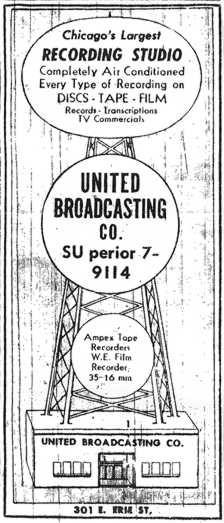
Some early Miracles were made at Myron Bachman's Studio on Carmen Avenue. But the principal recording venue was United Broadcasting Studio, which was owned by Egmont Sonderling. Born in Germany on February 27, 1906, Sonderling immigrated to the US in 1923. After a number of years working as a radio announcer, Sonderling opened United Broadcasting Studio in 1939; the first location was the former RCA Victor studio. In 1945, Sonderling moved his studios to 64 East Lake. Next he opened a pressing plant: a January 5, 1946 ad in Billboard declared Sonderling's readiness to press 2 million platters for delivery during the year. By 1947 Sonderling was calling his operation Master Records, though this seems to have encompassed just the studio and pressing plant; it was not yet being applied to commercial releases. Somewhere between June 1947 and March 1948 (we are using telephone books as our source, so we can't pinpoint the date), Sonderling bought World Broadcasting Studios at 301 East Erie and moved his UB operation there. In January 1949, stuck with a pile of R&B and jazz masters that the defunct Vitacoustic company hadn't paid him for, Sonderling opened a subsidiary called Old Swing-Master in partnership with DJ Al Benson (the label was named after Benson's DJ handle).
Toward the end of the label's history, 6 sides that Miracle recorded appeared on Old Swing-Master; 2 of the Old Swing-Master releases also came out on Master, which by then was an actual record label. In addition, further sides by Memphis Slim were eventually dealt to Master—we know of 2 singles derived from these—and a single by Jack Cooley (from the early days of Miracle's successor, Premium) was also dealt off to Master. Most likely these sides went to Sonderling in compensation for unpaid studio, mastering, or pressing bills. The Old Swing-Master sides and three of the Master issues bear the original UB matrix numbers and are placed with their original sessions below. Two Memphis Slim issues on Master have no UB numbers; since we do not know the sessions that they came from, we have listed them separately beneath the 1947 recordings for Miracle. (The sides originated with as many as 4 different sessions.)

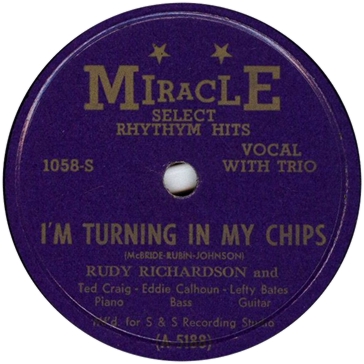
Recording for Miracle began in June 1946 (see below for details). Meanwhile, Lee and Francine's first son, Robert Allen Egalnick, was born on July 13, 1946.
The first singles that the new company released were the work of effeminate male singer Rudy Richardson, who usually accompanied himself on piano in the clubs. He was often plugged as "America's only male torch singer." One caption said, "his piano boogies are really on the ball too." His first session took place in mid to late June 1946. The release party for two Richardson singles was scheduled for August 16, as advertised in a sizable display in the Chicago Defender.
Richardson was born Rudolph Valentina Riles, in Memphis on September 30, 1923. His father was identified as Cyrus Lockett and his mother as Martha Marie Waidlington, so it could be that his birth father was named Riles. When he was three, his family moved to Chicago, where he atended the Douglas School. After graduating from DuSable High, he entered the club scene; "Rudolphe" Richardson first appears in the Local 208 Board minutes as a leader on April 6, 1944, when he filed an indefinite contract with the Chicken Palace. On September 21, 1944, he posted an indefinite contract with The Hurricane Lounge as "Rudy" Richardson. Richardson was close to continuously employed in Chicago clubs during 1945 and 1946; on February 1, 1945 he filed a contract for 13 weeks at Rudy's Chicken Shack (in which he did not have an ownership interest, so far as we know), and on April 5 he posted one for 8 weeks (3 days per) at The Hurricane. On June 21, 1945, he filed a contract for 12 more weeks at the Chicken Shack (no longer Rudy's). In September of that year he moved over to El Casino (indefinite contract filed on September 20); in December he picked up for 2 weeks at Rupneck's (contract filed December 6).
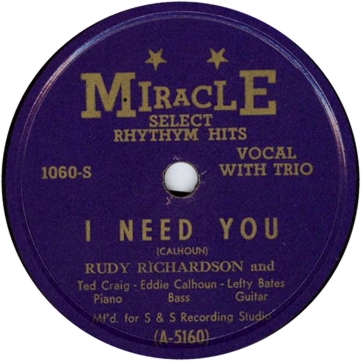
On the four tunes that formed his first two Miracle releases, Richardson turned over the piano chores to Ted Craig; the trio was completed by William "Lefty" Bates on guitar and Eddie Calhoun on bass. These 78s were apparently released under their matrix numbers, in a 1000 series. But they also carry a second set of matrix numbers in an A-5100 series (and three of these, such as A-5158 seem to have been misprinted, as A-5188). The 1000 series numbers are what appear in the trail-off shellac. The first two Miracles bear the further distinction of being issued on dark blue or purple-blue labels.
The recording date was a Swing-oriented outing, with the excellent work by the trio. "Chauffeur" is a torch song with a pleasant tune, rather amateurish lyrics ("I'm broken-hearted, so discarded"), and a monologue in the middle ("Chauffeur, take me home, I'm really gone... Don't think I'm wiggin', man, I'm just gone, you understand"). Richardson sings his weary plea in a high tenor voice, and Lefty Bates gets a little guitar solo. (We wondered whether the take we heard was issued, as it runs to 3:45 or so. However, the issued "Chauffeur" runs to 3:43—on a 10-inch 78, and it's faded at the end!). "Hick-Botham" is an uptempo Swing number featuring lots of scatting from Richardson and interesting solos by Craig, Calhoun (doing his Slam Stewart thing), and Bates. "I Need You" is a droopy ballad and "I'm Turning in My Chips," despite the torch aspect, could pass for a Nat King Cole number.
Despite the optimistic annotation "Select Rhythm Hits," nothing much seems to have happened commercially with the first two releases, which are rare today. Miracle decided to relaunch itself in December, now with a 100 series and a red label. (Richardson was mentioned in the November 30 article in Billboard.) Still, the company was putting more sides in the can during this period: the diversified investments included a second session by Richardson, as well as items by a jazz vocalist (Gladys Palmer with Floyd Hunt's combo), a blues artist (Memphis Slim), a gospel singer (Brother John Sellers), and a swing combo (the Dick Davis Orchestra).
All of the Rudy Richardson sides appear to have been cut at the same studio, a place whose 1000 series matrix numbers also show up on recordings made around this time for Hy-Tone, Sunbeam, Gold Seal, and Rondo. Richardson's last two sides for the label, released on Miracle 100, bear numbers later in the same 1000 series.
From clues provided by pianist Max Miller, who recorded for Gold Seal in August 1946, and John Steiner, who was familiar with the venue, we have concluded that the 1000-series venue was Myron Bachman's studio on Carmen Avenue, and from evidence about the first releases on Rondo, we've identified mid to late June 1946 as the likely time for Richardson's session. The 1057-1060 block immediately precedes the matrix numbers for a long session by the piano and organ duo of Ruth Noller and Evelyn Straub, and advance orders for one of their Rondo records were being taken by July 5, 1946.
By contrast, the first Dick Davis release, on Miracle 101, carries matrix numbers with the UB prefix, for United Broadcasting, which would become the company's studio of choice in October 1946. Tenor saxophonist Dick Davis (birth name Richard Earl Davis) was born in Jackson, Mississippi on April 15, 1917 (according to the Chicago Federation of Musicians Member Death Files 1940 - 1979). His family moved to Chicago in 1924. He graduated from DuSable High School in January 1938 (the Chicago school ran mid-year and June graduations then). And he won an award while in the DuSable band, which means he was trained by Captain Walter Dyett. On graduating he went promptly to work as a professional musician. The first name band he joined was the Sunset Royals (1938). After World War II service in the Army's 869th Engineer Aviation battalion in the Pacific, where he led the unit's dance band, he returned to Chicago and reestablished himself on the local club scene. He rejoined Local 208 on January 23, 1946 and was soon leading his own group at the Tradesmen's Show Lounge (6240 Cottage Grove Avenue). To make something of his time in the military, his outfit was billed as "Richard E. Davis & His Westcoast Swingsters." Davis spent several months at the Tradesmen's, posting a 1-month contract on June 6 and an 8-week contract on July 18. He also worked the Boulevard Lounge (indefinite contract filed on March 21) and Jimmie's Palm Garden (2-week contract filed May 2).
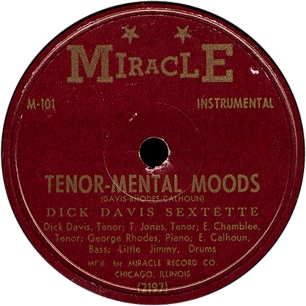
Dick Davis cut his first recordings for Miracle in June 1946, if we are reading the UB matrix numbers correctly; his first session could even have preceded Rudy Richardson's. He made the customary four sides, but only three were used. They were held for release until the label was relaunched (with Dick Davis as a listed artist) at the end of the year, when they appeared on Miracle 101. (Three sides were used because the company came out with two versions of 101, using different B sides. Somebody had second thoughts about the coupling.)
Egalnick and Simpkins got the idea to record Davis with George Rhodes, piano; Eddie Calhoun, bass; and "Little Jimmy" [Hoskins], drums—and an enhanced front line with Tommy "Madman" Jones and Eddie Chamblee also on tenor sax. The three tenors make a massive wall of sound that still excites the listener. According to the contract lists maintained by Musicians Union Local 208 during this period, in early June a group led by George Rhodes took up a residency at the Blue Heaven Lounge for 3 months. On the same date (June 6, 1946), "Edwin" Chamblee posted a contract for 2 weeks at the same venue. And Tommy Jones was a known quantity at the Blue Heaven, having performed there earlier in the year (his 3 week contract was accepted and filed on January 3; a 3-month contract followed on February 21). Around the time of the session he was working at the Band Box (1-week contract filed June 6) and Frank's Caravan (indefinite contract filed on the same day).
One of the vocal sides used on Miracle 101 is "Blues in My Heart," a superior ballad written by Benny Carter. It may have been George Rhodes who sought to evoke Carter's brilliant scoring with a lush arrangement for the three saxes (one of the tenorists—our guess is Eddie Chamblee—makes an unannounced switch to alto). The vocal line is affectingly handled by Savannah Strong. (She was mentioned, her first name mispelled, in the "launch" article in Billboard as being "inked"; the piece mentioned a second singer, Frances Holliday, who never had a release on Miracle.) "Tenor-Mental Moods" is a vigorous late-Swing instrumental based on "I Got Rhythm." There are solos for Dick Davis, Tommy Jones, and Eddie Chamblee (in that order) and the fast tempo leaves room for a little barrelhouse piano by Rhodes and some surprise bowing by Calhoun before the ensemble takes it out. The three tenors make an imposing ensemble whether riffing or playing the theme. A complete alternate take also survives.
Used on some other copies of 101 was "Sorry We Said Goodbye," featuring another vocal by Savannah Strong. This is a better than average lounge ballad, nicely sung, but the arrangement is much looser and the song is just not the equal of "Blues in My Heart." Davis does provide a ballad intro in the Coleman Hawkins tradition. The fourth, unissued side, "Ain't That Just like a Man," is a fast blues sung by Savannah Strong. The riffing is thrilling and Dick Davis provides a booting tenor solo with an uncharacteristic reed bite. It's too bad that they didn't extend the number, which clocks in under 2 1/2 minutes. Miracle would redo the piece, with extra verses and more instrumental interludes, as a vehicle for Gladys Palmer.
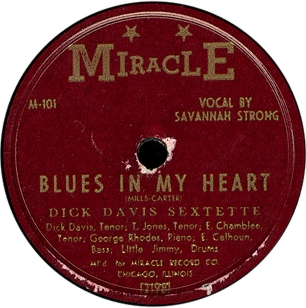
In September, Miracle recorded Rudy Richardson for the second time, but now the company was trying to position him as an R&B artist and the backing was provided by Dick Davis's band. George Rhodes had moved to New York City, where he got steady work in Arnett Cobb's combo. Sonny Thompson was now at the piano, along with Eddie Calhoun on bass, and probably Jimmie Hoskins on drums. "No Meat" is a humorous reaction to rationing that continued after the war (though other interpretations are simultaneously possible). Here Richardson (who exclaims "A steak! Why, man, you must be wiggin'," and makes the unsatisfactory offer of a "meatless stew" during the opening conversation), sings the lead and banters with the other members of the group. "No Meat" required 6 takes, on account of the complicated vocal exchanges; on one take a group member forgets the acronym for the Office of Price Administration. Davis and Thompson get a little solo space. "My Apartment" is a pseudo-Latin novelty number, apparently completed in one take. Vocally, it is mainly noteworthy for the sexual ambiguity of its lyrics; Davis and Calhoun (doing a passable imitation of the bowing and singing Slam Stewart) provide straightahead solos. If other sides were made on this date, they appear to be lost.
Rudy Richardson also recorded for the Manor label, using the standard piano-guitar-bass lineup (and Manor let him play piano on his dates). Of course, he may not have used the same bassist and guitarist as on his first Miracle session. Manor's headquarters were in Newark, New Jersey (later New York City) and its recording was generally done in the city, though in 1946 Manor was also recording another Chicago-based performer, singer June Davis. Manor 1039 coupled a medley of "They Raided the Joint" and "Route 66" with "A Stranger in Town" (we don't know the release date for 1039, but November 1946 is most likely). "Walkie Talkie" was used on Manor 1045 (a new release in Billboard, December 14, 1946, p. 34), with a flip by The Cats & The Fiddle. In addition, Rudy's Trio was credited in a Manor new release advertisement (Billboard, December 7, 1946) for accompanying Savannah Churchill on her big hit record, Manor 1046. Richardson plays celeste on both sides. On Manor 1047 by The Sentimentalists (who in a short while changed their name to the Four Tunes), there is accompaniment by a piano trio. According to Marv Goldberg, who has done detailed work on the Brown Dots and the Four Tunes (see http://www.uncamarvy.com/BrownDots/browndots.html), none of them played piano or bass, so the Rudy Richardson Trio was very likely on that release as well.
The sessions or sessions that produced Manor 1039, 1045, 1046, and 1047 took place in October (maybe also November, if there was more than one). We used to think they'd pre-dated Richardson's Miracles. Now that he had two Miracles and two and a half or three and a half Manors out, Rudy Richardson would sign a contract for 6 months at Kennedy's Honey Dripper Lounge (accepted and filed by Musicians Union Local 208 on January 16, 1947). Nearly a year later, a final Richardson Trio single appeared as Manor 1092 (this is the rarest of his Manors, and we haven't heard it). Trio accompaniment (and another switch to celeste behind Savannah Churchill) lead us to wonder about Manor 1093, which was split between Savannah Churchill on one side and the Four Tunes (the vocal group that she most often recorded with) on the other. Manor 1093 was reviewed in Billboard on November 1, 1947 (p. 116).
Richardson also worked the Flamingo Lounge ("One of 63rd Street's Gay Spots"). Now often spelling his first name "Rudi," Richardson appeared on two singles for the tiny Rim label; these were released in June 1949 and may have been recorded a couple of months earlier. He sang "If You Get It" and "You Made My Heart Cry Out" on Rim 100, and "Write Me a Letter" on Rim 101, to accompaniment by a solid jazz sextet led by one Bob Carter (confusingly, this was not the bass-playing Robert J. Carter who recorded for Specialty, Sunbeam, and Universal during this period). Richardson continued to appear fairly often in Chicago nightspots through the early 50s. He enjoyed a long residency at the Clover Lounge (he was in his 60th week there, according to Ted Watson, "Chicago Night Life Gets Lift from Name Artists," Pittsburgh Courier, September 12, 1953, p. 19) and another long residency at the Kitty Kat Club. In 1956, he participated in the opening of McKie's Disc Jockey Lounge.
1956 was also the year of his last recording. Richardson cut four sides in Nashville, most likely for Joe Johnson, the songwriting partner of Gene Autry, who was looking to start a new label featuring songs controlled by Autry's publishing company. In late 1956 or January 1957, with the new label not yet launched, either Joe Johnson or Troy Martin (the composer of "Why Should I Cry," who plugged songs for Autry in Nashville) pitched the session to Sam Phillips. In April 1957, Phillips put out "Fool's Hall of Fame" (a song he later had Johnny Cash and Roy Orbison record, with little success in either case; Cash's master was actually destroyed) and "Why Should I Cry"; the other two sides remained in the can. Although Sun 271 showed a small effort to update Richardson's sound, "Fool's Hall of Fame" still qualifies as torch material. (See http://www.boija.com for more about the Sun singles.) Rudy Richardson returned to Chicago on May 11, 1957, for the funeral of his (step)father, Cyrus Lockett, but was working primarily in Nashville, where from 1955 through 1958 he had several long runs at the Del Morocco lounge. On June 1, 1958, Richardson's body was found in a rooming house in Nashville, one block south of Fisk University. He had drunk denatured alcohol, very possibly with suicide in mind. (Our thanks to Colin Escott's liner notes to The Sun Rock Box 1954-1959, an 8 CD set on Bear Family 17313, for an updated and expanded bio on Rudolph Richardson, including details about his last recording session.)
On January 25, 1947, "Dick Davis and his swing combo" were still holding the fort at the Tradesmen's Lounge, according to the Defender. The rhythm section consisted of Sonny Thompson, piano; Eddie Calhoun, bass; and Jimmie Hoskins, drums. The caption claimed that the combo had recorded several numbers, including "Tenor-mental Moods." In fact, they had also backed Rudy Richardson, and would soon be cutting Davis's second session for Miracle. But it was Sonny Thompson who would end up selling a ton of records for Miracle; the company would not be recording Dick Davis again as a leader.
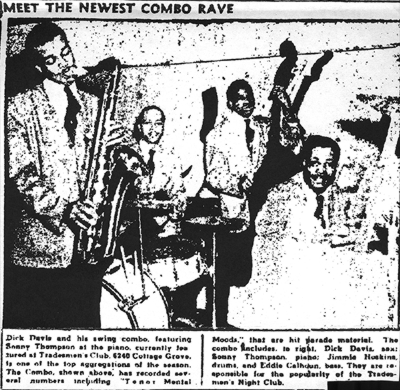
In early April 1947, Dick Davis moved out of the Tradesmen's, where he was replaced by Buster Bennett, and headed to Jimmy's Palm Garden, 808 Oakwood Boulevard. According to the caption on a photo of him that the Defender ran on April 26, his combo was participating in a Saturday battle of the bands series being broadcast over WGES (Al Benson's radio station) and would be up against "Linn's aggregation" (i.e., Claude McLin's group) the next day. In October 1947, Davis and his band were back at the Tradesmen's Lounge. When the band's engagement wound up on November 1, however, Matt Lightfoot, the owner, emptied the cash register and absconded; Davis had to press a claim against Ralph and Harold Lightfoot, who managed the place, with the Musicians Union for one week plus 3 days' pay (see Board meeting minutes to Local 208, November 20, 1947, p. 3).
Davis did get at least one more opportunity to record as a leader (see http://crownpropeller.wordpress.com/2011/12/26/dick-davis-combo-on-gateway-john-young-singing/). On April 16, 1949, Billboard announced (p. 51) that Ivan Ballen, the Philadelphia-based proprietor of 20th Century, Gotham, and other imprints, had been on a "Southern trip," leading to several artist signings to his Gotham label. A Defender ad from July 2, 1949 had Dick Davis and His Combo headlining at the "Q" Lounge, 114 East 43rd Street. The rhythm section consisted of Johnny Young, piano; Eddie Calhoun, bass; and Buddy Smith, drums. This was the same lineup that appeared on Gotham 182, a single most likely released in July or August 1949 with vocals by the leader on both sides. John Young later recalled that he had also done some singing during the gig at the "Q" (in later years, he would beg off requests for vocals, claiming to have laryngitis).
Possibly in 1952, another single by the same Dick Davis quartet (featuring blues singing by John Young on one side, and a composer credit to all four band members on the others) would appear on Gateway 5001. This was almost certainly derived from the Gotham session, though the chain of transactions (more than one could have been shady) that brought it to Gateway remains to be established. Gateway was a Cincinnati-based label, specializing in 49-cent singles, that also released a couple of other "race" items, including 5002 by Jump Jackson. It put out a lot of other material, but was best known for its Country sides. In April 1950, the Dick Davis Combo was holding forth at the Corner Lounge (1900 West Lake), in a variety show format that included Grant "Mr. Blues" Jones (see the Chicago Defender, April 29, 1950, p. 34).
From September 1951 until he became ill at the beginning of 1954 Dick Davis was a regular member of the King Kolax combo, which brought him a few more recording opportunities. On January 19, 1954 he died after a three-day battle with lobar pneumonia. (His obituary ran in the Chicago Defender on January 30, unfortunately with an incorrect date of death). Dick Davis was only 36.
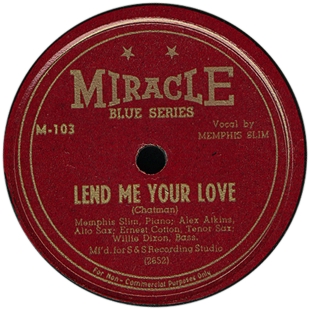
Blues pianist Memphis Slim was among the most prolifically recorded of Miracle's artists. He was born John L. Chatman (not Peter Chapman Jr. as many sources say) on September 3, 1915, in Memphis. In 1939 he moved to Chicago, and in 1940 made his first recordings, for OKeh, under the name Peter Chapman. (Meanwhile, the Musicians Union local knew him as Peter Chatman.) He recorded for Bluebird in 1940 and 1941 as Memphis Slim. From 1940 to 1944, and occasionally in 1945 and 1946, he was teamed up with Big Bill Broonzy. After several years away from the studios, he recorded with two different trios for Hy-Tone in late 1945 or early 1946. He also made a non-commercial recording (as much talk as music) with Big Bill and John Lee "Sonny Boy" Williamson in New York City, probably in the summer of 1946; it was released years later on a United Artists LP. He joined Miracle in the fall, cutting his first session for the label in October. During this period he was a mainstay at the South Side's preeminent blues club, the Flame Lounge (3020 Indiana Avenue). For instance, on November 7, 1946 Slim's contract for another 3 months at the Flame was accepted and filed by Musicians Union Local 208. Miracle had the happy idea of recording him with two saxes and string bass, in an ensemble that was eventually dubbed the House Rockers. Slim's piano style included elements of boogie-woogie and traditional blues, and the House Rockers, driven by fervent riffing from the alto and tenor sax, helped to transform his music into rhythm and blues.
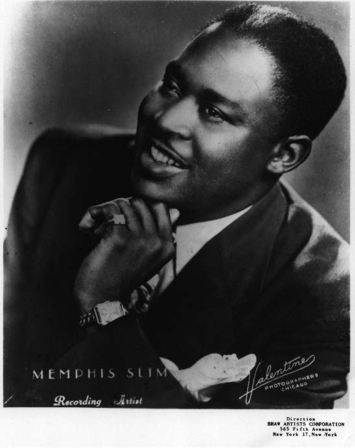
Slim's quartet on his first session for Miracle included Alex Atkins on alto saxophone, Ernest Cotton (1926 - ) on tenor—both had come to Chicago from Memphis—and Willie Dixon (1915 - 1991) on string bass.
Dixon, whose usual gig at the time was with the Big Three Trio, contributes to the conversation that opens "Kilroy Has Been Here." (On the first two takes, Slim actually addresses him as "Big Three.") It took five attempts to properly coordinate Slim and Dixon's alternating shouts of "Kilroy!" with the continuation "have been here and gone." The rousing boogie "Rockin' the House," which ended up giving Slim's group its name, achieved takeoff after one false start. At this point in the group's evolution, Alex Atkins was the major soloist after the leader—he can be heard to advantage on "Kilroy" and "Rockin'." Ernest Cotton also gets a solo on "Rockin'." The two vigorous numbers are counterbalanced by the pensive "Lend Me Your Love" and the brooding "Darling I Miss You," each of which needed just one take. All four numbers from this classic session were promptly released, selling well enough to bring Slim and his ensemble back for no fewer than five follow-up sessions in 1947.
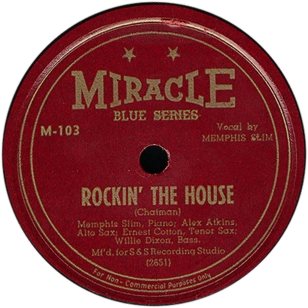
Jazz singer Gladys Palmer was profiled in Sharon A. Pease's column in Down Beat, July 14, 1947. She told Pease that she was born in Kingston, Jamaica (misrendered by Down Beat as "Kensington"), and came to America at the age of seven to attend boarding school in Atlanta. Her mother was a talented vocalist and pianist and taught young Gladys piano. In the States, she continued to develop her pianistic skills, and cited her influences as Duke Ellington and Fats Waller. (Accompanying the Pease profile was her boogie woogie composition, "Palmer's Boogie," which formed the flip of her second Miracle release.) She began performing professionally while still in high school. She was enjoying a long run at Atlanta's Biltmore Hotel when she was discovered by J. Mayo Williams and Dave Kapp of Decca Records. They brought her to Chicago to record a solo session in 1935, followed by a legendary appearance with Roy Eldridge in 1937. Palmer made her home in Chicago, and played a long run at the Three Deuces. From 1937 to 1940, she worked the clubs in New York, then returned to Chicago. (Recent research by Marv Goldberg shows that much of what Palmer told Pease was a complete fabrication. When his bio is completed, we will make the necessary corrections here.)
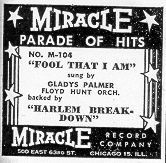
From 1942 to 1946, Palmer was based in Hollywood (also unlikely to be true), though she made trips to Chicago from time to time (for instance, on October 7, 1943, her contract for 1 week at the Latin Quarter was accepted and filed by Musicians Union Local 208). She returned to the Windy City in time to produce Miracle's first national hit.
Palmer recorded "Fool That I Am" (Miracle 104) as the vocalist on the Floyd Hunt Quartet session in October 1946. With slender resources, Miracle didn't release it until May 1947. By August, it was starting to move, and the ballad standard went to the lofty #3 position on Billboard's Race Jukebox chart in the fall of 1947. Her other vocal side, "Ain't That Just like a Man," was eventually released, but only after Miracle had gone out of business.
A classic torch song, "Fool That I Am" was initially done so slowly the first completed take ran to 3 minutes and 58 seconds. This made it a poor candidate for uncut release on a 10-inch 78. After a brief introduction, the first take went straight into Palmer's vocal. She sang the entire song, there was a long guitar solo, and then Palmer reprised the song at "Fool that I am, I thought you would understand." Despite the availability of the shorter take 2, Egalnick and Simpkins obviously preferred take 1. It underwent surgery. Palmer's complete rendition of the song was cut starting at "Fool that I am, I thought you would understand"; so was the ensuing guitar solo. Instead the remastered side picked up with her vocal reprise and ended as take 1 had originally done. To our knowledge all releases of take 1 have been as edited.
The second completed take, which featured a 45-second solo on the vibes before the vocal, was just a hair faster, but it ended with the vocal chorus. At 3:05 or so, take 2 was easily mastered uncut for a 10-inch 78. It was eventually released, on a Federal 78 after Miracle closed down. Federal had both takes in its possession, so there must have been a deliberate decision somewhere.
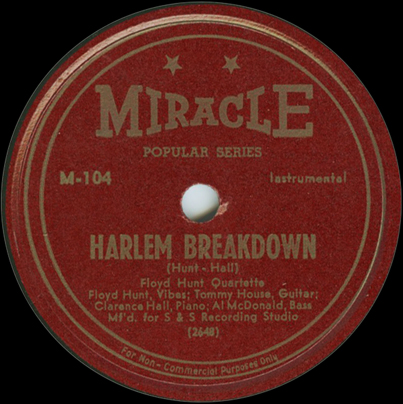
The Floyd Hunt group consisted of Hunt (vibes), Tommy House (guitar), Clarence Hall (piano), and Al McDonald (bass). The release was credited to the "Floyd Hunt Quartette" with Gladys Palmer indicated as the vocalist. The flip side, "Harlem Breakdown," was a moderate boogie instrumental that prominently featured Hall's two-fisted piano, House's rocking guitar, a Hamptonesque solo by Hunt, even an interlude for McDonald. Two sides were left unissued. "Ain't That Just like a Man" (the same piece previously recorded by Savannah Strong with Dick Davis) was an uptempo blues feature for Gladys Palmer, with plentiful solo space for Hunt and House. But the success of "Fool That I Am" apparently ruled out further efforts at R&B from the singer. Meanwhile, "I'll Get By" was a Swing performance by an older male vocalist with some ensemble vocal accompaniment. The vibes fall silent after the Hamp-style solo that precedes the vocal, so the singer was Floyd Hunt himself.
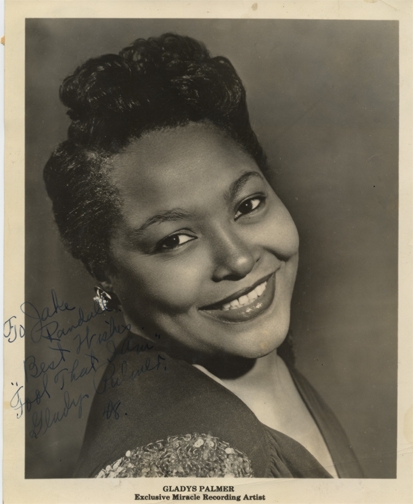
Meanwhile, Palmer was also generating considerable notice during 1947 at the Monte Carlo, playing a 24-week engagement. Said the Chicago Defender in April, "Miss Palmer who handles the spot's entertainment program was grabbed from the Loop several months ago and has become a fixture at the hot spot. Her singing and fine piano plucking attracts large crowds from the Loop district nightly and is the reason for the lounge being the gathering place for musicians from theatres and other places on the southside and the Loop."
Although Gladys Palmer landed Miracle a hit, her style of singing did not have lasting appeal with the record-buying public. The company brought her back into the studio on several occasions as 1947 wound down, probably recording much of her active repertoire, but her later singles did not sell well and much of her work for Miracle has never seen release.
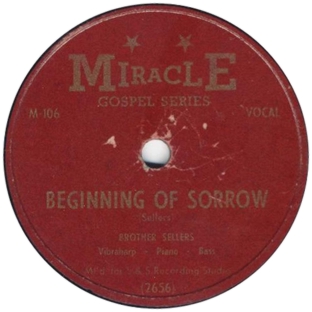
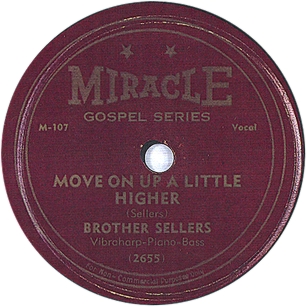
When Miracle signed Brother John Sellers in 1946 he had already built careers in both blues and gospel singing. He was born May 27, 1924 in Clarksville, Mississippi, and moved to Chicago as a youngster. In the early 1940s he was mentored by Mahalia Jackson. He recorded both blues and gospel for Mayo Williams' Chicago label during 1945. His first session for Miracle consisted of 4 gospel numbers, including Mahalia's signature song, "Move On Up a Little Higher."
On Miracle 106 and 107 the accompaniment on vibes, piano, and bass were provided by Floyd Hunt and two of his musicians, Clarence Hall and Al McDonald. Hunt adapted to the gospel setting by cranking the motor on his vibes way up (as he had already done on "Fool That I Am") and playing sweetly to approximate the sound of an organ, while Hall provided rather stiff elementary accompaniment on the piano. (The sweetness and the clunky pianistics can be heard on "Precious Lord," which McDonald joins only on the final chord. Hunt does work jazzy runs into "Move On Up.") On "Beginning of Sorrow," a remarkably jaunty tune considering its references to "the last days," which also gives Hunt ample solo space, Sellers can be heard using the folk pronunciation "Norah" for Noah. The more reverential "Just Wait a Little While" cuts back to just Hunt and McDonald in accompaniment. The unorthodox backing was reasonably effective, and Sellers sang soulfully in a pleading tenor voice, but one wonders how the sides did in the marketplace.
The unusual instrumentation behind Sellers, the consecutive matrix numbers—and the fact that Floyd Hunt's last and Memphis Slim's first track sit next to each other on the same 16 inch acetate—indicate a ganged session for Hunt's group, Memphis Slim, and Brother Sellers on the same day.
In 1947 Sellers recorded a blues session for RCA Victor. In late 1948, as Rev. John Sellers, he returned to Miracle for another gospel session. After two Chance blues sessions in 1952 (he was billed as "Johnny" Sellers for these), Sellers moved to New York and became involved in the folk club scene, recording albums that included blues, gospel, and folk stylings. Sellers died on March 27, 1999.
For Miracle, 1946 was a year of dipping toes into the water. Total output was 26 sides. Just 4 singles were released before the end of the year: the two blue-label Miracles by Rudy Richardson, and red-label Miracle 100 and 101.
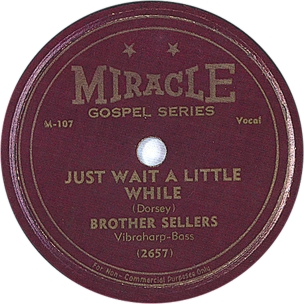
| Matrix | Artist | Title | Release # | Recording date | Release date |
| UB 2196 [tk. 2] | Dick Davis Sextette | Vocal by Savannah Strong | Ain't That Just like a Man | unissued | 6/1946 | |
| UB 2197 [tk. 1] | Dick Davis Sextette | Dick Davis, Tenor; T. Jones, Tenor; E. Chamblee, Tenor; George Rhodes, Piano; E. Calhoun, Bass; Little Jimmy, Drums | Tenor-mental Moods | Miracle 101 | 6/1946 | 12/1946 |
| UB 2197 [tk. 2] | Dick Davis Sextette | Tenor-mental Moods | unissued | 6/1946 | |
| UB 2197 [tk. 3 - inc] | Dick Davis Sextette | Tenor-mental Moods | unissued | 6/1946 | |
| UB 2198 [tk. 1 - fs] | Dick Davis Sextette | Vocal by Savannah Strong | Blues in My Heart | unissued | 6/1946 | |
| UB 2198 [tk. 2] | Dick Davis Sextette | Dick Davis, Tenor; T. Jones, Tenor; E. Chamblee, Tenor; George Rhodes, Piano; E. Calhoun, Bass; Little Jimmy, Drums | Vocal by Savannah Strong | Blues in My Heart | Miracle 101 [some copies] | 6/1946 | 12/1946 |
| UB 2199 | Dick Davis Sextette | Vocal by Savannah Strong | Sorry We Said Goodbye | Miracle 101 [some copies] | 6/1946 | 12/1946 |
| 1057-S (A-5187) | Rudy Richardson and Ted Craig Piano - Eddie Calhoun Bass - Lefty Bates Guitar | Hick-Botham | Miracle 1057/1059 | 6/1946 | 8/1946 |
| 1058-S (A-5188) | Rudy Richardson and Ted Craig Piano - Eddie Calhoun Bass - Lefty Bates Guitar | I'm Turning in My Chips | Miracle 1058/1060 | 6/1946 | 8/1946 |
| 1059-S (A-5189) | Rudy Richardson and Ted Craig Piano - Eddie Calhoun Bass - Lefty Bates Guitar | Chauffeur | Miracle 1057/1059 | 6/1946 | 8/1946 |
| 1060-S (A-5160) | Rudy Richardson and Ted Craig Piano - Eddie Calhoun Bass - Lefty Bates Guitar | I Need You | Miracle 1058/1060 | 6/1946 | 8/1946 |
| 1152SS [alt tk. 1] | Rudy Richardson | No Meat | unissued | 10/1946 | |
| 1152SS [alt tk. 2] | Rudy Richardson | No Meat | unissued | 9/1946 | |
| 1152SS [alt tk. 3] | Rudy Richardson | No Meat | unissued | 9/1946 | |
| 1152SS [alt tk. 4] | Rudy Richardson | No Meat | unissued | 9/1946 | |
| 1152SS | Rudy Richardson | No Meat | Miracle 100 | 9/1946 | 12/1946 |
| 1152SS [alt tk. 5] | Rudy Richardson | No Meat | unissued | 9/1946 | |
| 1154SS | Rudy Richardson | My Apartment | Miracle 100 | 9/1946 | 12/1946 |
| UB2646 [tk. 1] |
Floyd Hunt Quartettte (vocals: Gladys Palmer) | Ain't That Just like a Man | unissued | c. 10/46 | |
| UB2646[tk. 2] [F1012] |
Floyd Hunt Quartette (vocals: Gladys Palmer) | Ain't That Just like a Man | [Federal 12006] | c. 10/46 | [c. 3/1951] |
| UB2646 [tk. 3 - inc] |
Floyd Hunt Quartette (vocals: Gladys Palmer) | Ain't That Just like a Man | unissued | c. 10/46 | |
| 2647 [tk. 1] (UB2647SS-1 in wax) |
Floyd Hunt Quartette (vocals: Gladys Palmer) | Fool That I Am | Miracle 104 [edited] | c. 10/46 | 5/1947 |
| 2647 [tk. 2] [F-1030] |
Gladys Palmer | Vocal: Gladys Palmer | Fool That I Am | [Federal 12018-AA] | c. 10/46 | |
| 2648 [tk. 1] | Floyd Hunt Quartette | Harlem Breakdown | unissued | c. 10/46 | |
| 2648 [tk. 2] (UB2648SS in wax) |
Floyd Hunt Quartette | Harlem Breakdown | Miracle 104 | c. 10/46 | 5/1947 |
| 2649 [tk. 1] | Floyd Hunt Quartette (vocal: Floyd Hunt) | I'll Get By | unissued | c. 10/46 | |
| 2649 [tk. 2] | Floyd Hunt Quartette (vocal: Floyd Hunt) | I'll Get By | unissued | c. 10/46 | |
| UB2650 [tk. 1 - inc] | Memphis Slim Quartette | Kilroy Has Been Here | unissued | c. 10/46 | |
| UB2650 [tk. 2 - inc] | Memphis Slim Quartette | Kilroy Has Been Here | unissued | c. 10/46 | |
| UB2650 [tk. 3 - inc] | Memphis Slim Quartette | Kilroy Has Been Here | unissued | c. 10/46 | |
| UB2650 [tk. 4 - inc] | Memphis Slim Quartette | Kilroy Has Been Here | unissued | c. 10/46 | |
| UB2650 [tk. 5] | Memphis Slim Quartette | Kilroy Has Been Here | Miracle 102 | c. 10/46 | c. 1/1947 |
| UB2651 [tk. 1 - fs] | Memphis Slim, Piano; Alex Atkins, Alto Sax; Ernest Cotton, Tenor Sax; Willie Dixon, Bass. | Rockin' the House | unissued | c. 10/46 | |
| UB2651 [tk. 2] (some copies have 2651 on label, 2651SS in wax) |
Memphis Slim, Piano; Alex Atkins, Alto Sax; Ernest Cotton, Tenor Sax; Willie Dixon, Bass. | Rockin' the House | Miracle 103 | c. 10/46 | 5/1947 |
| UB2652 (some copies have 2652 on label, 2652SS in wax) [F1047] |
Memphis Slim, Piano; Alex Atkins, Alto Sax; Ernest Cotton, Tenor Sax; Willie Dixon, Bass. | Lend Me Your Love | Miracle 103 [Federal 12033] |
c. 10/46 | 5/1947 |
| UB2653 [F1046-1] |
Memphis Slim Quartette | Darling I Miss You | Miracle 102 [Federal 12033] |
c. 10/46 | c. 1/1947 |
| 2654 [tk. 1] | Brother Sellers | Vibraharp - Piano - Bass | Precious Lord | unissued | c. 10/46 | |
| 2654 [tk. 2] | Brother Sellers | Vibraharp - Piano - Bass | Precious Lord | unissued | c. 10/46 | |
| 2654 [tk. 3] | Brother Sellers | Vibraharp - Piano - Bass | Precious Lord | Miracle 106 | c. 10/46 | prob. 5/1947 |
| 2655 [tk. 1] |
Brother Sellers | Vibraharp-Piano-Bass | Move On Up a Little Higher | unissued | c. 10/46 | |
| 2655 [prob. tk. 2] (UB2655 SS in wax) |
Brother Sellers | Vibraharp-Piano-Bass | Move On Up a Little Higher | Miracle 107 | c. 10/46 | prob. 5/1947 |
| 2656 [tk. 1 - fs] | Brother Sellers | Vibraharp - Piano - Bass | Beginning of Sorrow | unissued | c. 10/46 | |
| 2656 [tk. 2] | Brother Sellers | Vibraharp - Piano - Bass | Beginning of Sorrow | unissued | c. 10/46 | |
| 2656 [tk. 3 - inc] | Brother Sellers | Vibraharp - Piano - Bass | Beginning of Sorrow | unissued | c. 10/46 | |
| 2656 [tk. 4 - inc] | Brother Sellers | Vibraharp - Piano - Bass | Beginning of Sorrow | unissued | c. 10/46 | |
| 2656 [tk. 5] | Brother Sellers | Vibraharp - Piano - Bass | Beginning of Sorrow | Miracle 106 | c. 10/46 | 1947 |
| 2657 (UB2657 SS in wax) |
Brother Sellers | Vibraharp-Bass | Just Wait a Little While | Miracle 107 | c. 10/46 | 1947 |
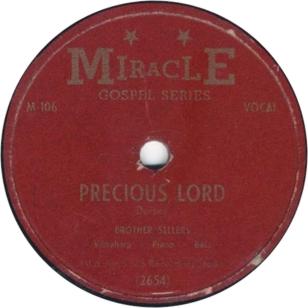
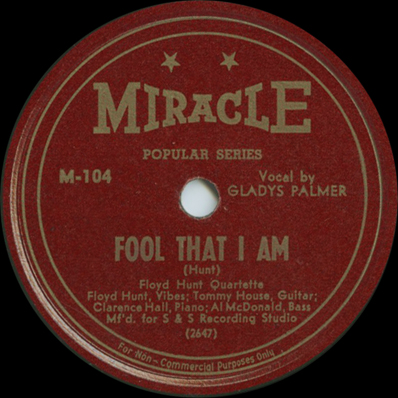

The first sides recorded in 1947, probably in January, were by the Dick Davis Orchestra featuring Sonny Thompson. The personnel as listed by Walter Bruyninckx were Dick Davis on tenor sax; Eddie Chamblee on tenor sax and vocals; Tommy "Mad Man" Jones on tenor sax and vocals; Sonny Thompson on piano; Lefty Bates on electric guitar; Eddie Calhoun on bass; and Buddy Rich on drums. (The Dave Penny story on Sonny Thompson, "Screaming Boogie," published in Blues & Rhythm, gives Buddy Smith on drums, which rather strongly suggests that "Buddy Rich" is a mistype, and says that Bates is inaudible.)
Bruyninckx and subsequent disocgraphers were way off. There was only one tenor saxophonist on Miracle 108 and 109: Dick Davis himself (thanks to Tom Kelly and Daniel Gugolz for confirming this). Jones and Chamblee were incorrectly carried over from the June 1946 session. And the rhythm section was misidentified as well. The band that was playing the Tradesmen's Show Lounge in late January of 1947 featured Davis on tenor sax, Thompson on piano, Jimmie Hoskins on drums, and Eddie Calhoun on bass. The caption to a wonderful photo of the group in action says, "The combo, shown above, has recorded several numbers, including 'Tenor-Mental Moods' that are hit parade material." ("Tenor-Mental" had been recorded the previous year, with George Rhodes at the piano.) In February the outfit was billed as "Dick Davis Combo, featuring Sonny Thompson, Savannah Strong on vocals." Meanwhile, on March 12, 1949, the Defender stated that Dick Davis and his combo had just come back from a three-month stand in Cincinnati at the Sportsman Club, and was opening March 14 for a long engagement at the Congo Club. The personnel for that group was John Young on piano, Eddie Calhoun on bass, and Buddy Smith on drums. Clearly, Jimmie Hoskins and not Buddy Smith was the drummer on the January 1947 session.
For the second session, Miracle kept on with the trend set by the second Rudy Richardson session, pushing the Davis ensemble away from Swing and into R&B. A copy of Miracle 109 in the late Otto Flückiger's collection reveals an ensemble vocal (a common device on Miracle releases). Typical of the period, Miracle 109 was a recording designed to get the powerful deejay Al Benson to play the company's records. On "Benson Jump" an ensemble vocal (three males, including Sonny Thompson who sings the bridge by himself, with obbligato by Dick Davis) sing about the joys of jivin' to the music played by Al Benson; the flip is a dramatization of two travelers, a porter, and a lady on the train from Chicago to Memphis.
According to Dave Penny, Sonny Thompson was the featured vocalist on "Sonny's Blues" from this session. Aside from some bantering on Rudy Richardson's "No Meat," and contributions to the ensemble vocals on "Benson Jump" and "Memphis Train" from this session, it would be the first time his voice was heard on a record. However, Miracle would make only sparing use of Thompson's vocal talents during his residency with the company; when one of his vocal sides saw release, Thompson wasn't creditd on the label.
A May issue of Billboard reported that "Miracle Records, independent race label, has started sponsoring a 15-minute disk jock spot by Al Benson weekly over WGES." The item also discussed how the firm was building up its distribution net, adding distributors in Dallas, Houston, Birmingham, Jackson. Miss., and Cleveland.
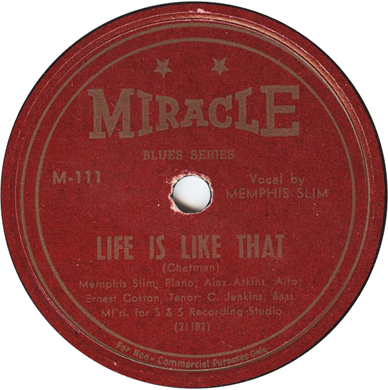
Memphis Slim continued his work for Miracle with four more sessions in 1947 (his band backed Lillie Mae Kirkman on a fifth). His quartet continued to feature Alex Atkins (alto sax) and Ernest Cotton (tenor sax). Charles Jenkins played the string bass on the first session; after that the chair was occupied by Ernest "Big" Crawford, whose trademark string-snapping could also be heard on more down-home sessions by Sunnyland Slim and Muddy Waters. Slim took up residence at the Hollywood Lounge in January 1947 (indefinite contract accepted and filed by Local 208 on January 16). Around the end of April he moved his group into the Timber Tap (indefinite contract posted on May 1).
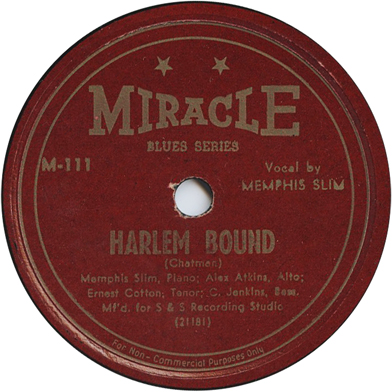
The first session (which included the invigorating "Pacemaker Boogie" and the reflective "Life Is like That") took place around March 1947, in time for the third and final launch of Miracle Records that took place in May. After that the band didn't return to the studio until October. By then, though, the "recording ban" had been announced for January 1, 1948, and the company was eager to stockpile Memphis Slim slides. So several further visits followed before the end of the year.
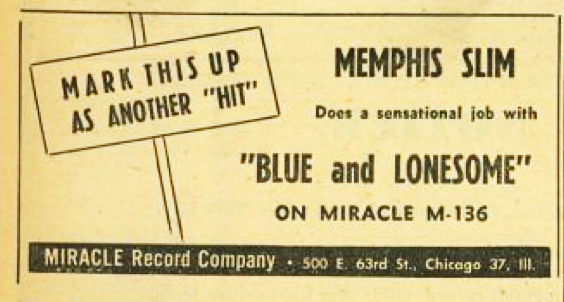
Memphis Slim gave Miracle a #1 national hit in the spring of 1948 with the reflective "Messin' Around" (Miracle 125), which was recorded in December of 1947. Interestingly, the composition was credited to another Miracle artist, pianist and vibraphonist Floyd Hunt, whose work would occasionally surface on Slim's later sessions. The flip of Miracle 125, "Midnight Jump" is, unusually for Slim, a late Swing number with strong solos by Alex Atkins and Ernest Cotton. Slim has no trouble with the idiom; it's just not what Miracle's customers most wanted to hear. Miracle 125 was on the regional Cash Box charts for several months in 1948; the company apparently didn't submit the single for review because it started selling right away. Recorded at the end of October 1947 were "Blue and Lonesome" (Miracle 136) and "Angel Child" (Miracle 145), both of which made the national R&B charts in 1949. Miracle was able to mine a deep Memphis Slim catalog throughout the history of the label.
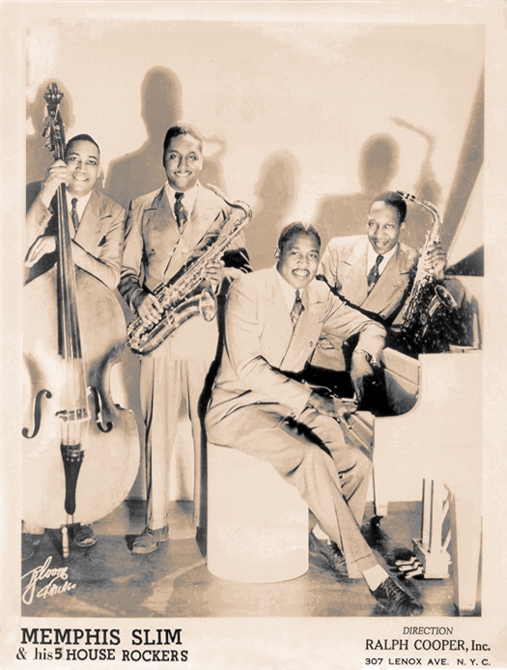
The flip side of "Angel Child" deserves some notice as well. Under the title "Nobody Loves Me," it was Memphis Slim's first recording of "Every Day I Have the Blues." (A second take of "Nobody Loves Me," also apparently cut in October 1947, has survived and can be heard on Memphis Slim: The Complete Recordings Vol. 2 1946-1948 on Blues Collection CD 159862. Vol. 3 1948-1950 in this most valuable series, Blues Collection CD 160142, includes Slim's Miracle recordings from "Midnight Jump" onward, includes the four sides that were taken over by Master, and continues through his first session for Premium.) Slim claimed writing credit (and often got it on subsequent releases) but in fact the tune was first recorded, under its usual title, back in 1935 by Aaron "Pinetop" Sparks for Bluebird. The celebrated 1952 version by Joe Williams with King Kolax could have been inspired by either Slim's "Nobody Loves Me" or Lowell Fulson's 1950 hit version under the "Every Day" title.
Miracle also recorded local blues singer Lillie Mae Kirkman, who appeared as plain old "Lillie Mae" on two sides with Memphis Slim's House Rockers, "Lovin' Man Blues" and "Lonesome." Each was apparently cut in one take during a session around December 20. (Another couple of Memphis Slim tracks that have lost their original UB numbers could have been done at this same session.) Released on Miracle 129 in November 1948, the two sides retained too much of the old "Bluebird beat" to attract buyer interest. The slow "Lovin' Man" features a thoughtfully lyrical tenor sax solo by Ernest Cotton. The perkier "Lonesome" makes good use of the House Rockers' sax riffing and Big Crawford's string slapping.
A singer out of the Victoria Spivey school, Lillie Mae had previously recorded twice in 1939. Her first session was made for Bluebird in May 1939 under the pseudonym of Ramona Hicks. It featured Buster Bennett on alto sax, and full details can be found on his page. (An item in the Chicago Defender for June 17, 1939 refers to one Ramona Hicks, originally from St. Louis, "who is also known as Lillie Mae Kirk.") In July 1939 she made a session for Vocalion, with accompaniment by pianist Curtis Jones and guitar Hobson "Hot Box" Johnson. Now billed as Lillie Mae Kirkman, she had two discs released (these featured such family-values titles as "Hop Head Blues"; another titled "He's Just My Size" has been featured on several latter-day packages of blues with bawdy lyrics). Kirkman spent much of the 1940s singing at Martin's Corner (1500 West Lake) on the West Side, often backed by the Jump Jackson band. She was variously called Kirkman, Kirkmond, Kerkmond and Kirkland in Defender ads and items. Maybe Egalnick threw up his hands and avoided the quandary by leaving her last name off the label. Though often billed as "Queen of the Blues," Kirkman obviously built her reputation as a local club performer. These were in fact her last performances on record.
One of the sides on Lillie Mae's Miracle release is credited to John E. Coppage, a songwriter and record producer who had some kind of association with United Broadcasting Studios. Coppage's relationship with Miracle may have been casual, but we know that he freelanced at the studio (for instance, when he recorded two sessions with guitarist Floyd Smith at UB in 1949, later selling one of them to Aristocrat.)
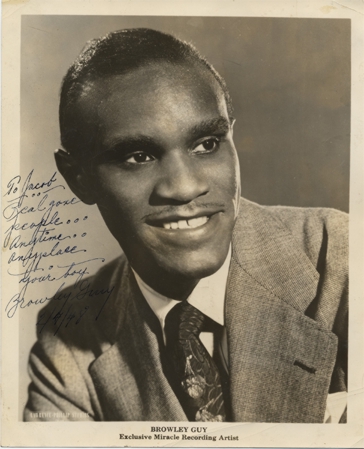
In August 1947, Miracle recorded the first of six sessions featuring a singer named Browley Guy. Possessed of a smooth baritone instrument, Browley Guy graduated from Wendell Phillips High School in June 1936, which means he was probably born in 1918 or 1919 (we will be upgrading our bio to take advantage of Marv Goldberg's reseearch on the singer). Guy served in the Army during World War II, posted to Fort Huachuca in southern Arizona. Browley Guy and his Fort Huachuca Quartet were among the performers when an army chaplain was honored for his service ("Chaplain Hodge To Be Honored: Being Given Certificate Today in Recognition of Services," Arizona Daily Star [Tucson], March 19, 1944, p. 12). Some months later, Private Browley Guy was part of a vocal sextet that appeared in several Arizona towns as the 5th War Bond Cavalcade ("Huachuca Personnel Participates in Bond Selling Cavalcade," New York Age, August 12, 1944, p. 7). One of the other members was "Call Cobb, jr." In other words, Harvey Call Cobbs, Jr., the pianist from Ohio who resurfaced many years later with Albert Ayler. In May 1946, Guy was in the Swingaroo revue at Smalls' Paradise in Harlem (New York Age, May 11, 1946, p. 11). The Pittsburgh Courier ventured to declare that Guy, whose next booking was at Bali in Washington, "has one of the best male voices this side of Billy Eckstine" (June 1, 1946, p. 16). Not quite. We are not sure where in Chicago Guy was working when Lee Egalnick and Lew Simpkins picked him up. Much was expected from him, but his first session, which featured Sonny Thompson at the piano with an otherwise unknown band, was held back.
The company would record Guy again in October, with his vocal group The Skyscrapers and a band led by Eddie Chamblee. Miracle was much happier with these items, releasing "Certain Other Someone" and "Last Call" (an instrumental) in December 1947 and bringing out "Knock Me a Zombie" at some point during the next year and a half.
Before 1947 was out, Guy appeared on two more sessions with Sonny Thompson and the Sharps and Flats; one of his vocal sides from the first session would see release. "That Gal of Mine" is partly redeemed by Thompson's Wilsonian piano and a few splashes of vibes from Floyd Hunt. But "For the First Time," a solo vocal from the early December session, is pretty dire, and "Just Can't Fool Myself," which exists in at least four takes (two from around November 27 and two from early December) didn't get any better with practice. Guy's faithful clientele in the clubs never translated into record sales, so most of his tracks were left unissued.
There is little prospect of reviving them now. For today's listener, the lounge ballads of the late 1940s are what has badly dated, and lounge ballads, crooned sweetly, were what Guy most often recorded. He didn't treat slow standards much better. But when Miracle let him do a jump, he and his mates in the Skyscrapers took care of business. "Knock Me a Zombie" is a hip late Swing number (complete with a little Swing scatting, and a reference to Duke Ellington on the jukebox). Unfortunately it is one of just two such pieces that Miracle recorded. The other jump, which celebrates the "Man from Timbuktu" (who, despite his exotic origins and large shoe size, wears a "zoot suit with a reet pleat"), was left in the vault. There is further evidence, from their February and August 1952 session for States, that Guy (who got some help on States from his brother Slim) could sing blues and jumps respectably.
Guy and group would get two further opportunities to record, for Al Benson in June 1953 (leading to one single on Checker), and for Mercury, for a release in January 1956. By the time of their Mercury session, which was meant to compete with the work of much younger doowop groups, the Skyscrapers sounded extremely dated. Browley Guy kept going as a solo artist; he snagged a session with Vee-Jay in 1963. So far as we know, Vee-Jay 541, an extremely rare 45-rpm single, was his last release. In fact, the only photo we've been able to find is of a DJ copy.
In October 1947, the company brought the great tenor saxophonist Eddie Chamblee, who had appeared on the first Dick Davis session, back into the studio as a leader. Edwin Leon Chamblee was born in Atlanta, Georgia, on February 24, 1920. He attended Wendell Phillips High in Chicago, where he was a classmate of Ruth Jones (1924 - 1963, better known to posterity as Dinah Washington). While in the Army during World War II he became deeply involved in music, and after the war he joined the Lionel Hampton Orchestra, touring with the band for two years.
The October 1947 session uses accompaniment by a piano, guitar, and bass trio. Chamblee makes the most of his limited opportunities on the two vocal ballads from the date and shines on the jump ("Knock Me a Zombie"). And "Last Call" is a booting instrumental that should have encouraged Miracle to bring Chamblee right back into the studio without a vocalist. Miracle 119, a December 1947 release which coupled one of the vocal group ballads with the instrumental, did not sell well. (Another drippy ballad, titled "On the Blue Side," was never released.) Chamblee's big break would come just a little later, out of his work as a sideman on several of Sonny Thompson's sessions.
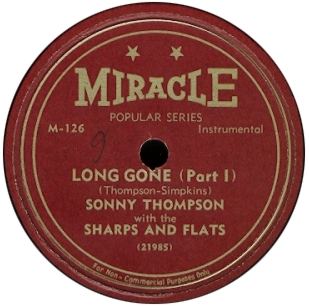
Miracle scored its biggest hit in the spring of 1948 with keyboardist Sonny Thompson's great rolling instrumental, "Long Gone." Like so many other things, it was recorded during the last quarter of 1947 while the company was feverishly stockpiling sides in anticipation of "B-Day." (B-Day was the Petrillo-led "recording ban" that went into effect on January 1, 1948.) On Part 1, the record featured Thompson on piano and Arvid Garrett of the Sharps and Flats on guitar; tenor sax player Eddie Chamblee took over for Part 2. The two parts actually came from different sessions. Part 1 was done at Thompson's second session, in early November, while part 2 had to wait for his third session toward the end of the same month). The relaxed rhythm behind the pair was maintained by the Sharps and Flats, namely Arvid Garrett (guitar), Leroy Morrison (bass), and Thurman "Red" Cooper (drums). The Sharps and Flats had been working the clubs for some time on their own when Miracle teamed them up with Thompson (who at this point in his career often worked as a solo pianist). The Sharps and Flats did a lot of harmony singing on their club gigs; however, Miracle was not initially interested in this aspect of their work. (Sharps and Flats vocals would be featured on a session with Sonny Thompson around December 22, 1947 and, at greater length on a session they shared with Eddie Chamblee around July of 1948, but the company never released any of them.)
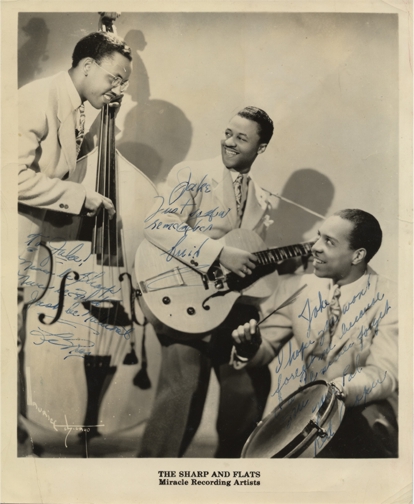
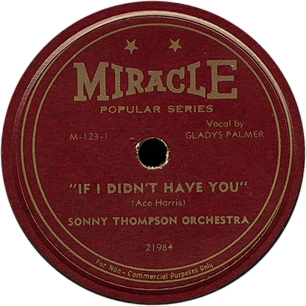

The company brought Sonny Thompson into the studio in August, primarily to back Browley Guy on two ballads. Nothing from the session was ever released. Thompson brought in a guitarist and a bass player; a violinist can also be heard on "I Live to Worship You." Despite some interesting solo work by the pianist, the performance is lugubrious and syrupy and the instruments sound as though they're being played in somebody's living room. "Out of Nowhere" is a far better song, the violinist is now approximately in balance with the other musicians, and Sonny Thompson pulls out all of his Teddy Wilson and Art Tatum tricks—but Guy's drippy vocal, marred by tasteless scoops and slides, is hard to bear. After the two vocal tracks were completed, the violinist was sent packing and Thompson turned in a Tatumesque performance of "Just You, Just Me" that cries out for reissue.
Undaunted by this false start, Miracle began to get the results that it wanted when Thompson and the Sharps and Flats came into the studio in October to back Gladys Palmer. A vibraphonist, probably Floyd Hunt, was added on the two of the numbers. "Strangest Feeling," "I Understand We're Through," and "If It's Love" were strong ballad performances. "I'm Pullling Through" is Palmer's tribute to Billie Holiday. Palmer and Thompson brought a lighter touch to "S'posin'," which seems to have been too much of a Swing number to interest Miracle's management.
In November, Thompson and company made "Long Gone Part 1" in a session that mostly featured the vocalist once again. Gladys Palmer's ballad performance on "If I Didn't Have You," which was issued in December 1947, before "Long Gone," adds vibes, again by Floyd Hunt; the flip, "Palmer's Boogie," credits Palmer for playing piano.
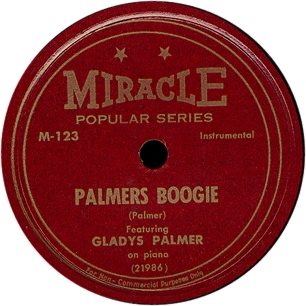
Around a week later, Gladys Palmer returned to the studio to lay down more ballads. "In the Rain," credited on the label to freelance producer John Coppage, is one of her better ballad vehicles, with Tatumesque accompaniment by Sonny Thompson and splashes of vibes from Floyd Hunt. "Forget It" picks up the tempo a little and gives Thompson and the Sharps and Flats some interesting things to do (check out Sonny's introduction to the second take), but the song is nothing special. Nor is "You're Getting Me Down," another fairly slow ballad, despite Thompson's Wilsonesque accompaniment. A real curiosity, worked in at the end of the session, is "Heartaches"—the first item that Miracle chose to record with just the Sharps and Flats. It features whistling by one member of the trio.
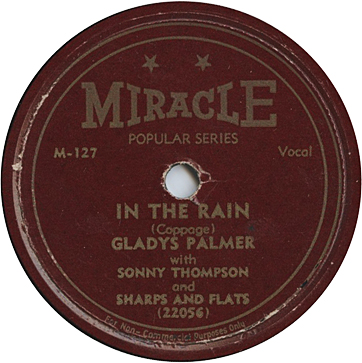
Providing further evidence that Egalnick and Simpkins needed time to discover what Sonny Thompson could do for them, "Long Gone Part 2" was made around November 27, at the tail end of a session on which Thompson's group backed Browley Guy and his vocal group. The combo's ebullient contributions to "Man from Timbuktu" suggested that something special might be in the offing, but Guy and company's two ballads called for nothing more than calm professionalism. "Long Gone Part 2," however, proves that the decision to add Eddie Chamblee's tenor sax to Thompson and the Sharps and Flats gave Part 2 the precise touch that it needed.
Miracle was now seeing a lot of commercial potential in Sonny Thompson, for the company brought him back into the studio seven times during the stockpiling period in December. The first, around December 7, consisted mostly of solid instrumentals with Eddie Chamblee and the Sharps and Flats. "Walkin'" and "Late Freight" were blues, while "Bounce" and "Devil Grape" were Swing numbers out of Hines, Wilson, Tatum, and Basie. Only "Late Freight" would see release while Miracle was in business.
Particularly noteworthy is the session from around December 16, when Sonny, Eddie Chamblee, and the Sharps and Flats got to lay down four instrumentals without any vocal distractions. They obliged with two tasty Swing originals, "Sonny's Special" and "Tip Lightly," and a Jacquet-style romp on "Sweet Georgia Brown" featuring Chamblee. Miracle used nothing but the eloquent "Blue Dreams," whose genre is obvious from the title: Chamblee, Garrett, and Thompson are the soloists. It required two complete runthroughs only because of some cutting faults on take 2.

The session of December 19, or thereabouts, caught Gladys Palmer apparently suffering from laryngitis. She turned in two affecting takes of "Once You Were Mine," on which her hoarseness was already audible. But after that she either had to quit singing—or she should have, and her sides were rejected by the company. On "I Really Did," a pretty good male vocalist took over—Sonny Thompson, doing his first ballad for Miracle. At the end of the session, Palmer essayed a runthrough of "Don't Be That Way" (a lounge ballad unrelated to the Swing instrumental by that name); she finished the song, hoarser than ever. Nothing from the session was released, and the company had to try again with Palmer less than two weeks later.
A session around December 22 finally gave the Sharps and Flats a chance to show off their group vocals. "Turn It Over" is a slickly swinging R&B number featuring strong guitar and piano solos. One member of the group takes a solo turn at "Rash Trash," a number in the mold of "You Rascal You," but less creative. The company left these items in the can. "In a Little Spanish Town" is an instrumental feature for Sonny Thompson and the Sharps and Flats; the guitar-piano unison in the theme statement is on the precious side, but Thompson gets to do his Wilson-Tatum thing (becoming more extravagant on the unissued second take), and Garrett takes a swinging solo. (Maybe Egalnick and Simpkins shared our opinion, because the acetate of the master take carries a notation to fade the piece around 2:45, before the out chorus.) "Dreams" is an instrumental ballad on which Thompson pulls several runs out his bag of tricks, but in the end the tune drags him and Garrett down; it was done in two takes only because the band couldn't decide how to end the first). Nothing from the session ended up being released on Miracle, but "In a Little Spanish Town" eventually came out on the British Esquire label in the early 1950s.
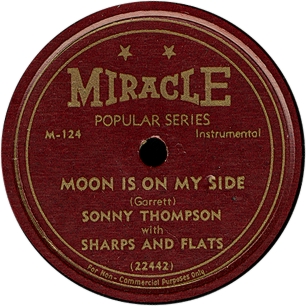
During a session a couple of days later, Thompson and the Sharps and Flats without Eddie Chamblee backed Browley Guy on one plodding old schmaltzy ballad ("Tears Follow My Dreams"). They also recorded an instrumental version of the sentimental pop tune, "Moon Is on My Side," in a style akin to King Cole's (and in a better performance than "Dreams" from the previous session). This pairing was promptly released on Miracle 124. Obviously Thompson and the Sharps and Flats could handle material like "Moon Is on My Side," and Thompson was probably doing so regularly during his nightclub sets, but once the bluesy stuff caught on with record buyers, Miracle stopped asking for such performances. Among the instrumental sides from the session, "Blues on Rhumba" and "Just Boogie" (which were used on Miracle 131 and 127, respectively) were better suited to Miracle's intended market. And the laid-back blues "Sonny's Return" was the second item to see release from the session, on Miracle 128. The session stands out among Miracle's from December 1947, because five out of the six sides recorded were released. Just "Swing Alley," a superior performance in a genre that Miracle felt it had no buyers for, was held back.
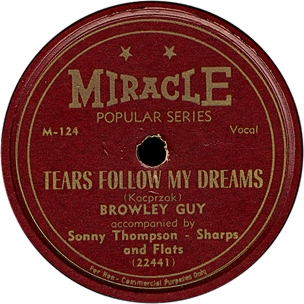
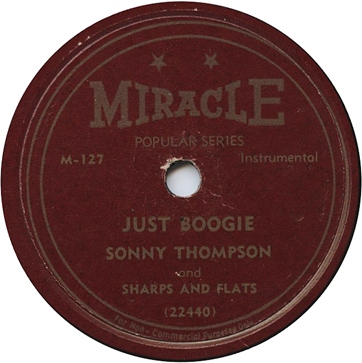
Sonny Thompson and the Sharps and Flats' final session of the year, which may well have taken place on December 31, brought Gladys Palmer back to redo "Once You Were Mine." Just one take was needed to get a satisfactory result, but the company sat on the song. Palmer completed four others on the date, which would be her last for Miracle. Floyd Hunt was again added on vibes; he can be heard on the first take of the moody ballad "Caress Me," with the motor on his instrument turned up. The other two takes were done without Hunt. "I'll Say It Again" is a run-of-the-mill ballad, lent some interest by Sonny Thompson's piano intro à la Wilson and his Tatumesque runs behind the vocal; "My Heart Cries" is a somewhat better ballad, again with good accompaniment by Thompson et al. With some studio time left over, the late-1920s classic, "If I Could Be with You One Hour Tonight," was given a loose, impromptu performance; unusually for her, Palmer gets into an Ella Fitzgerald groove. "Not on a Xmas Tree" is an impromptu New Orleans-flavored blues featuring Sonny Thompson himself (thanks to Dani Gugolz and Big Joe Louis for verifying this, because Miracle never credited Thompson's vocals on the label). Because Miracle lost interest in Gladys Palmer, only "Not on a Xmas Tree" would see release—and it had to wait for nearly two years.
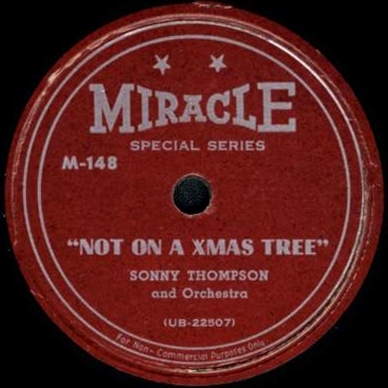
Egalnick's investment in Sonny Thompson paid off hansomely when Miracle 126, a two-part release of "Long Gone," sold some 200,000 copies and went to the top of the charts. It lasted more than 30 weeks on the Billboard R&B charts, and was still logging non-trivial sales into the first half of 1949. On July 3, 1948, Cash Box announced that "Sonny Thompson and Memphis Slim, setting the pace on Miracle Records, [are] planning a joint nationwide tour in the next few weeks." "Long Gone" even nosed briefly into the pop charts (where it hit #29 for the week of July 10, 1948). The record was so popular that Egalnick had to fight bootleggers in Saint Louis, who were selling counterfeit copies of the record.
Thompson was born Alphonso Thompson in Memphis on August 22, 1916. While he was a preschooler, his family moved to Chicago. He attended Wendell Phillips High School, and studied at the Chicago Conservatory of Music. In the clubs he learned his craft from Art Tatum and Earl Hines. He began working regularly in 1940. After a short time in the Army (he was given a medical discharge after being injured in a cave-in accident), Thompson returned to Chicago to recuperate, resuming work in the clubs as a soloist in early 1944. He continued to work as a solo pianist, except for a period of 7 months (May through December 1945) when he led a big band at El Grotto, the basement club in the Pershing Hotel.
Thompson made his first two sides under his own name as a solo pianist for the Detroit-based Sultan label in May of 1946. Morton Sultan, who owned the label, was a pianist who had studied in Chicago himself; he was no longer performing in public himself but probably admired Thompson's playing. Sultan's gimmick was "double-headed hits," which meant that Thompson, billed for the occasion as the "Prince of the Ivories," split one 78 with an Eddie Wiggins combo and another with Red Saunders. The gimmick wasn't successful, and Sultan quit recording jazz after its first 3 releases, with material from a fourth session never issued. After several months in the Dick Davis combo, which included recording twice for Miracle with them, Sonny Thompson went back out on his own (on August 21, 1947, he posted an indefinite contract to play solo piano at the Bar o' Music). Thompson reached the peak of his performing career with his Miracle sides. After Miracle folded, he recorded extensively for King Records, then handled A&R for the label until 1964, when King closed its Chicago office. Thereafter he produced recordings on an occasional basis for Chess and other labels. Thompson died on August 11, 1989.
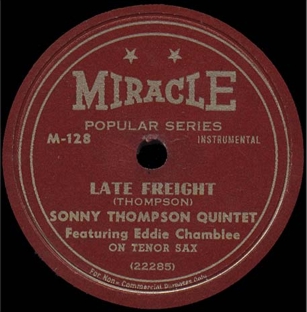
A new artist inked by Miracle in 1947 was blues shouter Piney Brown. The singer was born was born Columbus Perry on January 20, 1922, in Birmingham, Alabama. (He has kept his birth name under wraps; we got this information from Brian Baumgartner.) Piney Brown's first music experience was in a family gospel group. In 1940 he moved to Baltimore and there broke into show business. His October 1947 session for Miracle was his recording debut.
Although Piney Brown was described in the February 7, 1948 Chicago Defender as a "Miracle recording artist," just one side was ever released: "That's Right Little Girl," which came out only in Great Britain, on an Esquire release during the early 1950s. We know now that Piney Brown recorded 4 sides with Sonny Thompson and the Sharps and Flats, plus significant contributions by Eddie Chamblee. "That's Right" and "Return of Piney Brown" are declamatory blues showing a strong Kansas City influence; "Return of Piney Brown" even refers to 18th and Vine. "A New Kind of Lovin'" is closer vocally to Wynonie Harris; the number features strong solos by Chamblee, guitarist Arvid Garrett, and Thompson. "Vi," on the other hand, celebrates "a little girl in Chicago."
The Defender item said that Piney Brown was beginning a tour on March 13, and added, "The idea is to keep Brown before his record public and put a shot in the arm to a fast dying show business. Plan is to make [a] small compact package and offer to promoters at [a] price enabling them to make a profit. Package will feature Piney Brown, and include Randy Sherman Orchestra, Gip Roberts, comic; Toni Palmer, song thrush; Fred and Sledge, dancers; and Ann Butler, novelty dancer." The rest of the lineup indicates that Miracle wasn't sponsoring the tour. Piney Brown moved on pretty quickly after Miracle failed to use his material; he made a series of recordings in New York City for different labels, starting with Apollo in 1949, then Jubilee (1951), Sittin' in With (1952), Par (1952), and Atlas (1954). After a successful run at the Club DeLisa in a duo with Billy Brooks, Brooks and Brown recorded in Chicago for Duke in 1957 (see the King Kolax discography). In 1959 Piney Brown recorded for Tommy Jones' Mad label. Brown subsequently moved to Kansas City, and then to Dayton, Ohio, recording for several other small companies.
See the outstanding article by Brian Baumgartner, "Piney Brown: Now and Then," Juke Blues No. 48 (2000), pp. 28-37.
1947 was the make-or-break year for Miracle. Egalnick and Simpkins invested in 100 recorded sides that year, most of them during the frantic last quarter. Some of these items (the Memphis Slim numbers, and the Sonny Thompson R&B instrumentals) would keep bringing in revenue as long as the company was still in operation. Too many others lost their salability before 1948 was out, if they had any to begin with.
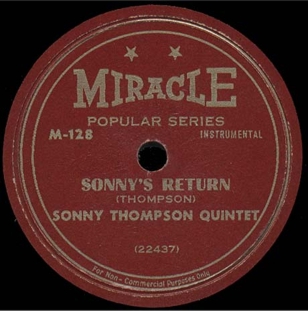
| Matrix | Artist | Title | Release # | Recording date | Release date |
| UB21046 [M-536] |
Dick Davis Orchestra featuring Sonny Thompson | Memphis Train | Miracle 109 | c. 1/47 | 6/1948? |
| UB21047 | Dick Davis Orchestra featuring Sonny Thompson | Benson Jump | Miracle 109 | c. 1/47 | 6/1948? |
| UB 21048 SS | Dick Davis and Orchestra featuring Sonny Thompson | Sonny's Blues | Miracle 108 | c. 1/47 | 6/1948 |
| UB 21049 SS [M-531] |
Dick Davis and Orchestra featuring Sonny Thompson | Screamin' Boogie | Miracle 108 | c. 1/47 | 6/1948 |
| UB21179 [F-1029] |
Memphis Slim, Piano; Alex Atkins, Alto; Ernest Cotton, Tenor; C. Jenkins, Bass | Pacemaker Boogie | Miracle 110 [Federal 12015] |
c. 3/47 | 5/1947 |
| UB21180 [F-1028] |
Memphis Slim, Piano; Alex Atkins, Alto; Ernest Cotton, Tenor; C. Jenkins, Bass | Motherless Child | Miracle 110 [Federal 12015] |
c. 3/47 | 5/1947 |
| UB21181 | Memphis Slim, Piano; Alex Atkins, Alto; Ernest Cotton, Tenor; C. Jenkins, Bass | Vocal by Memphis Slim | Harlem Bound | Miracle 111 | c. 3/47 | 6/1948 |
| UB21182 [F-1014] |
Memphis Slim, Piano; Alex Atkins, Alto; Ernest Cotton, Tenor; C. Jenkins, Bass | Vocal by Memphis Slim | Life Is like That | Miracle 111 [Federal 12007] |
c. 3/47 | 6/1948 |
| UB21498 | Browley Guy | Out of Nowhere | unissued | c. 8/47 | |
| UB21499 | Browley Guy | I Live to Worship You | unissued | c. 8/47 | |
| UB21500 | Browley Guy? | unidentified title? | rejected | c. 8/47 | |
| UB21501 | Sonny Thompson | Just You, Just Me | unissued | c. 8/47 | |
| UB21744 [alt.] | Memphis Slim and The House Rockers | Nobody Loves Me | (Blues Collection [Fr] 159862) | c. 10/10/47 | |
| UB21744 SS-2 [F-1015] |
Memphis Slim and The House Rockers | Nobody Loves Me | Miracle 145 [Federal 12007] |
c. 10/10/47 | 10/1949 |
| UB 21745-SS | Memphis Slim and The House Rockers | Believe I'll Settle Down | Master 1010 Old Swing-Master 1010 |
c. 10/10/47 | 12/1949 |
| UB21746 | Memphis Slim? | unidentified title | unissued? | ||
| UB21747 | Memphis Slim and The House Rockers | Throw This Poor Dog a Bone | Miracle 153-1 | c. 10/10/47 | late 1949 |
| 21748SS (UB21748SS in wax) [tk. 2] |
Memphis Slim and The House Rockers | Help Me Some | Miracle 136 | c. 10/10/47 | 7/1949 |
| UB21857 | Eddie Chamblee Orchestra feat. Browley Guy & The Skyscrapers | Certain Other Someone | Miracle 119 | c. 10/23/47 | 12/1947 |
| UB21857 [alt.] | Eddie Chamblee Orchestra feat. Browley Guy & The Skyscrapers | Certain Other Someone | unissued | c. 10/23/47 | |
| UB21858 | Eddie Chamblee Orchestra | Last Call | Miracle 119 | c. 10/23/47 | 12/1947 |
| UB21859 | Eddie Chamblee Orchestra feat. Browley Guy & The Skyscrapers | On the Blue Side | unissued | c. 10/23/47 | |
| UB21859[alt.] | Eddie Chamblee Orchestra feat. Browley Guy & The Skyscrapers | On the Blue Side | unissued | c. 10/23/47 | |
| UB21860 | Browley Guy & The Skyscrapers | Knock Me a Zombie | Miracle 137 | c. 10/23/47 | before 7/1949 |
| UB21860 [alt.] | Browley Guy & The Skyscrapers | Knock Me a Zombie | unissued | c. 10/23/47 | |
| UB21870 | Piney Brown with Sonny Thompson Orch. | Vi | unissued | c. 10/25/47 | |
| UB21870 [alt.] | Piney Brown with Sonny Thompson Orch. | Vi | unissued | c. 10/25/47 | |
| UB21871 | Piney Brown with Sonny Thompson Orch. | A New Kind of Lovin' | unissued | c. 10/25/47 | |
| UB21872 | Piney Brown with Sonny Thompson Orch. | Return of Piney Brown | unissued | c. 10/25/47 | |
| UB21873 [M-539-1] |
Piney Brown | That's Right Little Girl | (Esquire 10-330) | c. 10/25/47 | (early 1950s) |
| UB21873 [alt.] | Piney Brown | That's Right Little Girl | unissued | c. 10/25/47 | |
| UB21883 [F1013] |
Gladys Palmer | I Understand We're Through | [Federal 12006] | c. 10/26/47 | [c. 3/1951] |
| UB21883 [fs] | Gladys Palmer | I Understand We're Through | unissued | c. 10/26/47 | |
| UB21883[alt.] | Gladys Palmer | I Understand We're Through | unissued | c. 10/26/47 | |
| UB21884 | Gladys Palmer | S'posin' | unissued | c.10/26/47 | |
| UB21884 [inc] | Gladys Palmer | S'posin' | unissued | c.10/26/47 | |
| UB21885 | Gladys Palmer | Strangest Feeling | Miracle 130 | c. 10/26/47 | 10/1948 |
| UB21885 [alt.] | Gladys Palmer | Strangest Feeling | unissued | c. 10/26/47 | |
| UB21886 [F-1031] |
Gladys Palmer [with Sonny Thompson Orchestra] |
Song Man | Miracle M-507 [Federal 12018-A] |
c. 10/26/47 | 5/1949 |
| UB21887 | Gladys Palmer | I'm Pulling Through | Miracle 149 | c. 10/26/47 | after 7/1949 |
| UB21887 [alt.] | Gladys Palmer | I'm Pulling Through | unissued | c. 10/26/47 | |
| UB21888 | Gladys Palmer | If It's Love | unissued | c. 10/26/47 | |
| UB21938-SS | Memphis Slim and The House Rockers | Country Girl | Master 1010 Old Swing-Master 1010 |
c. 10/31/47 | 12/1949 |
| UB21939 | |||||
| 21940SS[tk. 5] (UB21940SS in wax) |
Memphis Slim and The House Rockers | Blue and Lonesome | Miracle 136 | c. 10/31/47 | 7/1949 |
| UB21941 SS-1 | Memphis Slim and The House Rockers | Angel Child | Miracle 145 | c. 10/31/47 | 10/1949 |
| 21981 [alt.] | Gladys Palmer | Later On | unissued | c. 11/5/47 | |
| 21981 | Gladys Palmer | Later On | Miracle M-507 | c. 11/5/47 | 5/1949 |
| UB21982 | Gladys Palmer | Tonight You Belong to Me | Miracle 149 | c. 11/5/47 | prob. late 1949 |
| UB21983 | Gladys Palmer | You Alone | Miracle 130 | c. 11/5/47 | 10/1948 |
| UB21984[alt.] | Gladys Palmer | If I Didn't Have You | unissued | c. 11/5/47 | |
| UB21984SS-2 | Sonny Thompson Orchestra (Vocal by Gladys Palmer) | If I Didn't Have You | Miracle 123-1 | c. 11/5/47 | 12/1947 |
| UB21985 SS [K9012] [M-527] |
Sonny Thompson with the Sharps and Flats [Sonny Thompson] |
Long Gone Pt. 1 [Long Gone (Part 1)] |
Miracle 126 [King 4438] |
c. 11/5/47 | 3/1948 |
| UB21986 (UB21986SS-1 in wax) [M-537] |
Featuring Gladys Palmer on piano | Palmers Boogie | Miracle 123-2 | c. 11/5/47 | 12/1947 |
| UB22055 [tk. 1] | Gladys Palmer | Forget It | unissued | c. 11/13/47 | |
| UB22055 [tk. 2] | Gladys Palmer | Forget It | unissued | c. 11/13/47 | |
| UB22056[tk. 1] | Gladys Palmer with Sonny Thompson and Sharps and Flats | In the Rain | unissued | c. 11/13/47 | |
| UB22056[prob. tk. 2] | Gladys Palmer with Sonny Thompson and Sharps and Flats | In the Rain | Miracle 127 | c. 11/13/47 | 1948 |
| UB22056[tk. 3] | Gladys Palmer with Sonny Thompson and Sharps and Flats | In the Rain | unissued | c. 11/13/47 | |
| UB22057 | Gladys Palmer? | unidentified title? | rejected | c. 11/13/47 | |
| UB22058 [tk. 1 - fs] | Gladys Palmer | Do I Thrill You | unissued | c. 11/13/47 | |
| UB22058 [tk. 2] | Gladys Palmer | Do I Thrill You | unissued | c. 11/13/47 | |
| UB22059 [tk. 1] | Gladys Palmer | You're Getting Me Down | unissued | c. 11/13/47 | |
| UB22059 [tk. 2] | Gladys Palmer | You're Getting Me Down | unissued | c. 11/13/47 | |
| UB22059 [tk. 3] | Gladys Palmer | You're Getting Me Down | unissued | c. 11/13/47 | |
| UB22059 [tk. 4] | Gladys Palmer | You're Getting Me Down | unissued | c. 11/13/47 | |
| UB22060 | Sharps & Flats | Heartaches | unissued | c. 11/13/47 | |
| UB22184 [tk. 1] | Browley Guy & The Skyscrapers | Man from Timbuktu | unissued | c. 11/27/47 | |
| UB22184 [tk. 2] | Browley Guy & The Skyscrapers | Man from Timbuktu | unissued | c. 11/27/47 | |
| UB22185 [inc] | Browley Guy & The Skyscrapers | Just Can't Fool Myself | unissued | c. 11/27/47 | |
| UB22185 | Browley Guy & The Skyscrapers | Just Can't Fool Myself | unissued | c. 11/27/47 | |
| UB22186 | Browley Guy & The Skyscrapers | That Gal of Mine | Miracle 137 | c. 11/27/47 | before 7/1949 |
| UB22186 [alt.] | Browley Guy & The Skyscrapers | That Gal of Mine | unissued | c. 11/27/47 | |
| UB22187 SS [K9013] [M-528] |
Sonny Thompson with the Sharps and Flats Starring Eddie Chamblee (Tenor Sax) [Sonny Thompson] |
Long Gone, Part 2 [Long Gone (Part 2)] |
Miracle 126 [King 4438] |
c. 11/27/47 | 3/1948 |
| UB22283 | Sonny Thompson | Bounce | unissued | c. 12/7/47 | |
| UB22284 [alt.] | Sonny Thompson | Walkin' | unissued | c. 12/7/47 | |
| UB22284 [M534] |
Sonny Thompson & Sharps & Flats feat. Eddie Chamblee | Walkin' | (Sequel CD900) | c. 12/7/47 | (1996) |
| UB 22285 SS-S1 [M533-1] |
Sonny Thompson Quintet featuring Eddie Chamblee on Tenor Sax | Late Freight [Creepin'] |
Miracle 128 [Esquire (Br) 10-320] |
c. 12/7/47 | 8/1948 |
| UB22285 [alt.] | Sonny Thompson | Late Freight | unissued | c. 12/7/47 | |
| UB22285 [alt. 2] | Sonny Thompson | Late Freight | unissued | c. 12/7/47 | |
| UB22286 [alt.] | Sonny Thompson | Devil Grape | unissued | c. 12/7/47 | |
| UB22286 [alt. 2] | Sonny Thompson | Devil Grape | unissued | c. 12/7/47 | |
| UB22286 | Sonny Thompson | Devil Grape | unissued | c. 12/7/47 | |
| UB22287 [tk. 1] | Browley Guy and the Skyscrapers | Just Can't Fool Myself | unissued | c. 12/7/47 | |
| UB22287 [tk. 2] | Browley Guy and the Skyscrapers | Just Can't Fool Myself | unissued | c. 12/7/47 | |
| UB22287 [alt.] | Browley Guy and the Skyscrapers | Just Can't Fool Myself | unissued | c. 12/7/47 | |
| UB22288 [alt.] | Browley Guy | For the First Time | unissued | c. 12/7/47 | |
| UB22288 | Browley Guy | For the First Time | unissued | c. 12/7/47 | |
| UB22322-A [K-9023] |
Memphis Slim and His Houserockers | Midnight Jump | Miracle 125 [Federal 12021] |
c. 12/12/47 | 10/1948 |
| UB22323 | |||||
| UB22324 | |||||
| UB22325-SS [K-9022] |
Memphis Slim and His Houserockers | Messin' Around | Miracle 125 [Federal 12021] [King 6301] |
c. 12/12/47 | 10/1948 |
| UB22367 | Sonny Thompson and Orchestra | Sonny's Special | unissued | c. 12/16/47 | |
| UB22368 [tk. 1 - fs] | Sonny Thompson and Orchestra Featuring Eddie Chamblee | Blue Dreams | unissued | c. 12/16/47 | |
| UB22368 [tk. 2] | Sonny Thompson and Orchestra Featuring Eddie Chamblee | Blue Dreams | unissued | c. 12/16/47 | |
| 22368 (UB22368 in wax) [tk. 3] |
Sonny Thompson and Orchestra Featuring Eddie Chamblee | Blue Dreams | Miracle 131 | c. 12/16/47 | 2/1949 |
| UB22369 [tk. 1 - fs] | Sonny Thompson and Orchestra | Tip Lightly | unissued | c. 12/16/47 | |
| UB22369 [tk. 2] | Sonny Thompson and Orchestra | Tip Lightly | unissued | c. 12/16/47 | |
| UB22370 | Sonny Thompson and Orchestra | Sweet Georgia Brown | unissued | c. 12/16/47 | |
| UB22398 | Gladys Palmer with Sonny Thompson and the Sharps and Flats | Once You Were Mine | unissued | c. 12/19/47 | |
| UB22398[alt.] | Gladys Palmer with Sonny Thompson and the Sharps and Flats | Once You Were Mine | unissued | c. 12/19/47 | |
| UB22399 | Gladys Palmer? | unidentified title? | rejected | c. 12/19/47 | |
| UB22400 | Sonny Thompson and the Sharps and Flats (Sonny Thompson, vocal) | I Really Did | unissued | c. 12/19/47 | |
| UB22401 | Gladys Palmer? | unidentified title? | rejected | c. 12/19/47 | |
| UB22402 | Gladys Palmer? | unidentified title? | rejected | c. 12/19/47 | |
| UB22403 | Gladys Palmer with Sonny Thompson and the Sharps and Flats | Don't Be That Way | unissued | c. 12/19/47 | |
| UB 22407 SS | Lillie Mae [Kirkman] and The House Rockers | Lovin' Man Blues | Miracle 129 | c. 12/20/47 | 10/1948 |
| UB 22408 SS | Lillie Mae and The House Rockers | Lonesome | Miracle 129 | c. 12/20/47 | 10/1948 |
| UB22415 (M-510) [tk. 1] |
Sonny Thompson | In a Little Spanish Town | (Esquire [Br] 10-320) | c. 12/22/47 | (early 1950s) |
| UB22415 [tk. 2] |
Sonny Thompson | In a Little Spanish Town | unissued | c. 12/22/47 | |
| UB22416 [tk. 1 - inc] | Sonny Thompson | Dreams | unissued | c. 12/22/47 | |
| UB22416 [tk. 2 - inc] | Sonny Thompson | Dreams | unissued | c. 12/22/47 | GR 15128 22416 |
Royal Brent [Sonny Thompson] | Sugar Bun | Rockin' 521 | c. 12/22/47 | 1953 |
| UB22417 | Sonny Thompson | Rash Trash | unissued | c. 12/22/47 | |
| UB22418 [tk. 1] | Sharps and Flats with Sonny Thompson | Turn It Over | unissued | c. 12/22/47 | |
| UB22418 [tk. 2] | Sharps and Flats with Sonny Thompson | Turn It Over | unissued | c. 12/22/47 | |
| UB 22437 SS S1[tk. 1] (M-506-1) [M-511] |
Sonny Thompson Quintet [sic] | Sonny's Return (House Full of Blues) [Blues] |
Miracle 128 (Esquire [Br] 10-320) [Sequel CD 900] |
c. 12/24/47 | 8/1948 (early 1950s) [1996] |
| UB 22437[tk. 2] | Sonny Thompson Quintet [sic] | Sonny's Return (Blues) | unissued | c. 12/24/47 | |
| UB22438 [tk. 1 - fs] | Sonny Thompson & Sharps & Flats | Swing Alley | unissued | c. 12/24/47 | |
| UB22438 [tk. 2 - inc] | Sonny Thompson & Sharps & Flats | Swing Alley | unissued | c. 12/24/47 | |
| UB22438 [tk. 3] [M-512] |
Sonny Thompson & Sharps & Flats | Swing Alley | (Blue Moon BMCD 6024) | c. 12/24/47 | (2000) |
| UB22439SS [M-520] |
Sonny Thompson and Orchestra | Blues on Rhumba | Miracle 131 | c. 12/24/47 | 2/1949 |
| UB22440 [M-540] |
Sonny Thompson and Sharps and Flats | Just Boogie [Deadline Boogie] |
Miracle 127 | c. 12/24/47 | 1948 |
| UB22441 [tk. 1 - fs] | Browley Guy accompanied by Sonny Thompson - Sharps and Flats | Tears Follow My Dreams | unissued | c. 12/24/47 | |
| UB22441 SS [tk. 2] | Browley Guy accompanied by Sonny Thompson - Sharps and Flats | Tears Follow My Dreams | Miracle 124 | c. 12/24/47 | 6/1948 |
| UB22442 SS | Sonny Thompson with Sharps and Flats | Moon Is on My Side | Miracle 124 | c. 12/24/47 | 6/1948 |
| UB 22503 | Gladys Palmer with Sonny Thompson and Sharps and Flats | I'll Say It Again | unissued | c. 12/31/47 | |
| UB 22504 | Gladys Palmer with Sonny Thompson and Sharps and Flats | Once You Were Mine | unissued | c. 12/31/47 | |
| UB 22505 | Gladys Palmer with Sonny Thompson and Sharps and Flats | My Heart Cries | unissued | c. 12/31/47 | |
| UB 22506[tk. 1] | Gladys Palmer with Sonny Thompson and Sharps and Flats | Caress Me | unissued | c. 12/31/47 | |
| UB 22506[tk. 2 - fs] | Gladys Palmer with Sonny Thompson and Sharps and Flats | Caress Me | unissued | c. 12/31/47 | |
| UB 22506 [tk. 3] | Gladys Palmer with Sonny Thompson and Sharps and Flats | Caress Me | unissued | c. 12/31/47 | |
| UB 22507 SS | Sonny Thompson and Orchestra | Not on a Xmas Tree | Miracle 148 | c. 12/31/47 | c. 11/1949 |
| UB 22508 | Gladys Palmer with Sonny Thompson | (I'm Guessin') If I Could Be with You One Hour Tonight | unissued | c. 12/31/47 |
Since we have never seen a Miracle master book with recording dates in it (we don't know whether the company bothered to keep documents at that level of detail in 1947), the reader may be curious how we arrived at the estimated recording dates during the last quarter of the year.
Completely by accident, we set an anchor point on October 13, 1947, when Hy-Tone recorded a session with gospel singer R. L. Knowles and his pianist James Miller that included matrix numbers UB 21765 through 21767. (We know this date because Miller complained to Local 208 of the Musicians Union about not being paid half an hour overtime for the session.) The highest number in the UB2000 series that we have encountered is UB 22508, from the year-ending session by Sonny Thompson and Gladys Palmer. So between October 13 and December 31, 1947, United Broadcasting was cranking out the sides at the rate of 9.4 per day, not counting alternate takes. Egmont Sonderling must have thought that was good business—but one wonders just how many record companies ended up significantly in the hole, and owing him money afterward...
Bernd Kratochwil notes (in his article, whose title, in full Germanic splendor, is Die Geschichte des Entrepreneur Al Benson aus Chicago oder die labels "Old Swingmaster", "Parrot", und "Blue Lake": Teil 2 Old Swingmaster Discography, Rockin' Fifties,1997, 45-49) that Egmont Sonderling bought 10 Memphis Slim masters from Old Swing-Master in March 1950. These originally derived from Miracle and were first dealt off to Old Swing-Master. Old Swing-Master did issue a 1010 and a 1011, probably both in December 1949, from Miracle masters, but by March 1950 Old Swing-Master was inactive (it would close its doors in June of that year). The Master issues were presumably done by Sonderling alone and came in March 1950. We know of a Master 1020 and a Master 1030; these obviously were intended to come after Old Swing-Master / Master 1010 and 1011, but were issued only on Master. Sonderling had already consolidated his pressing plant with Art Sheridan's Armour Plastics in March 1950. By the end of the year Master Records was no longer putting out any commercial releases; some limited editions of material recorded at United Broadcasting
The provenance of the Master items is less clear than we would like, because the original UB matrix numbers were stripped off after the sale.
Close listening indicates that "Restless Nights" is the work of a quartet with Big Crawford on bass, so it was done in 1947. The same applies to "Love at Sight," on which Slim says "Blow It, Mr. Cotton." "Jumping Bean," which unusually for Slim features New Orleans rhythms, has a drummer on it and a different bassist, so it can't have been done before 1948. "If You Live That Life" is a boogie that appears to have Alfred Elkins on bass, as well as a fairly discreet drummer—Slim's October 1949 session is most likely.
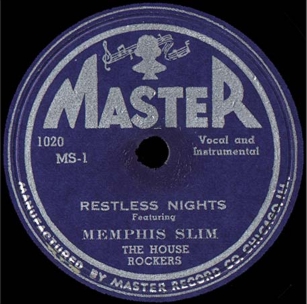
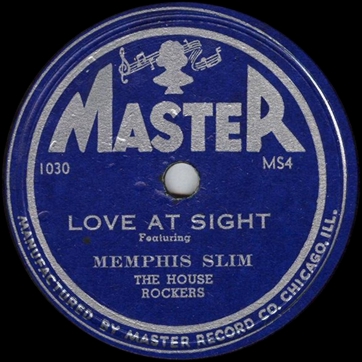
| Matrix | Artist | Title | Release # | Recording date | Release date |
| MS-1 | Memphis Slim | The House Rockers | Restless Nights | Master 1020 | 1947 | 3/1950 |
| MS-2 | Memphis Slim | The House Rockers | If You Live That Life | Master 1020 | prob. 10/49 | 3/1950 |
| MS 3 | |||||
| MS 4 | Memphis Slim | The House Rockers | Love at Sight | Master 1030 | 1947 | 3/1950 |
| MS 5 | |||||
| MS 6 | |||||
| MS 7 | Memphis Slim | The House Rockers | Jumping Bean | Master 1030 | 1948 or 1949 | 3/1950 |
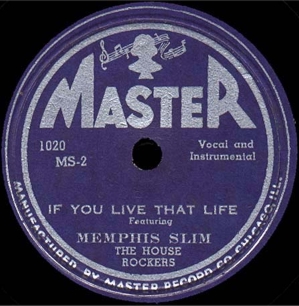
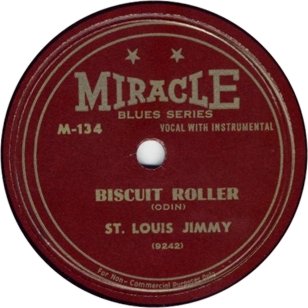
As the Petrillo-ordered recording ban ran out of steam, Miracle resumed studio sessions in the summer, though like other record companies that had overspent and overstocked in 1947, it did so at a much reduced pace. And because of the Musicians Union's strength in Chicago, it kept its activities quiet. Meanwhile, Sonny Thompson came through again for the label. From one of his December 1947 sessions came "Late Freight" (Miracle 128), which prominently featured Eddie Chamblee. (The piece was called "Creepin'" when it was issued in Britain.) It entered the charts in August 1948 and went to #1 on the Billboard national R&B chart.
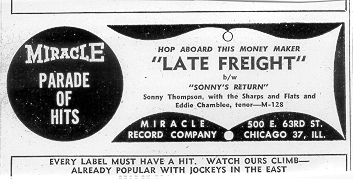
In June 1948 Sonny Thompson undertook a month-long string of dates with Memphis Slim. In August, Thompson actually took over for a while as intermission bandleader at the Savoy Ballroom in New York. In the fall, Thompson and Memphis Slim undertook another tour, throughout the Midwest.
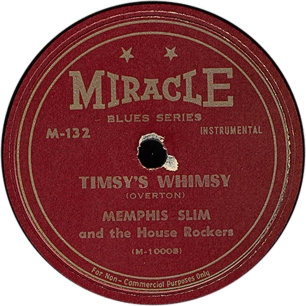
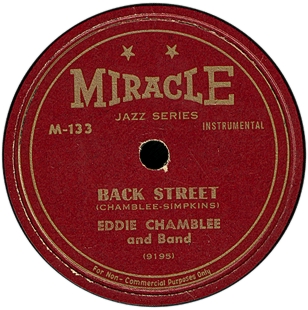
The massive success of "Long Gone," which featured his long solo on Part 2, landed Eddie Chamblee another studio date as a leader, which we estimate took place around July of 1948. This produced a hit in "Back Street" (Miracle 133), which was released in the spring of 1949.
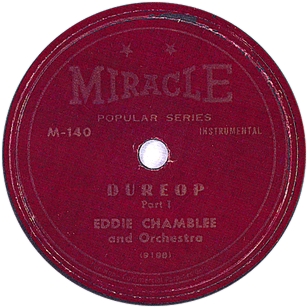
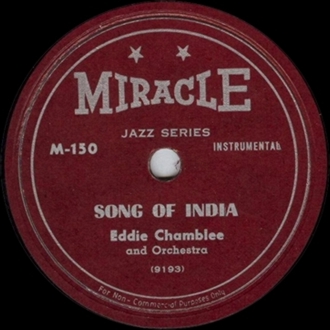
To the July 1948 session, Chamblee brought a group including John "Streamline" Ewing (trombone), Andrew "Goon" Gardner (baritone sax), and James Craig (piano). The bassist and drummer have been identified as Ernie Shepard and Chuck Williams, but judging from the overall sound it seems more likely that Chamblee used the Sharps and Flats as his rhythm section. Note, in particular, the prominent but uncredited guitar parts on "Back Street" and "Dureop," which sound like the work of Arvid Garrett. Gardner, who became a Charlie Parker disciple all the way back in 1939 when they played side by side in a King Kolax band, delivered several bop solos on the big horn. "Song of India" is a passionate, guttural tenor sax showpiece. Back Street," announced by a band member as "Back Street Boogie" on all takes except the one that Miracle issued, is what the adjective "bootin'" was invented to describe. Gardner's long solo in the Leo Parker manner is particularly impressive. "Dureop" is a relaxed blues jam with a bop riff periodically sung by band members, spread over both sides of a 78. Part II is mostly given over to guitar and piano solos. On "Cradle Rock" Chamblee used the Sharps and Flats as his rhythm section without the extra horns.
The long session was quite productive, leading to 7 issued sides on Miracle, and 3 more left unissued. "I Shouldn't Care" is an unannounced ballad feature for Browley Guy accompanied by the entire Chamblee group; through the 5 takes that the piece required, Guy is dreadfully unctuous, but Streamline Ewing gets a rare opportunity to do his Bill Harris ballad thing. The Sharps and Flats did several vocal numbers of their own; instrumentation on their sides is guitar, bass, and drums. "When Will I See You Again" provides more slick and sappy balladeering, somewhat easier on the ears than Browley Guy's (though on take 3 the lead vocal slides out of tune); the added piano on this one is presumably by James Craig.
"Hawaiian War Chant" is a novelty number (the language appears to be double-talk Polynesian) that gives Red Cooper a good excuse to bring out his mallets. "I Knew He Would" is a mock-tragic spoken dialogue rather loosely inspired by the story of Little Red Riding Hood; the pianist returns for this one. We had thought neither of these oddities was released, but a Miracle 151 has turned up at archive.org with both of them on it. Was the 151 by the Sharps and Flats released before or after the Miracle 151 by Robert Anderson? And in what quantities? The best ensemble vocal that the Sharps and Flats did for Miracle is the laid-back, bluesy "See Me Go Baby," still unreleased after all this time, which also features a good piano solo by Craig and a reflective guitar solo by Garrett.
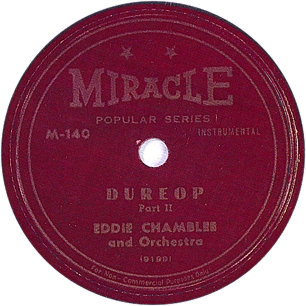
The next month Chamblee cut one instrumental track, "Lazy Mood," to fill out the studio time on a session that featured St. Louis Jimmy Oden, the blues singer, who was accompanied by Roosevelt Sykes (piano); the remainder of the rhythm section has previously been identified as an unidentified guitarist, Andrew Harris (bass), and Osie Johnson (drums). However, Dani Gugolz has noted that the rhythm section sounds like our old friends The Sharps and Flats; i.e., Arvid Garrett (guitar), Leroy Morrison (bass), and Red Cooper (drums). The two issued St. Louis Jimmy sides are both slow blues (if additional tracks were cut at the session they appear to have been lost). Chamblee gets a solo on "Biscuit Roller"; Garrett is featured on "I'm Sorry Now."
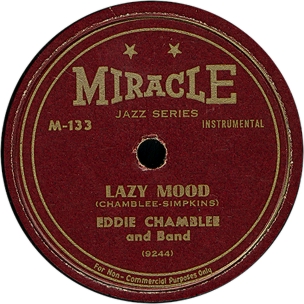
For reasons that are no longer clear, Miracle brought Eddie Chamblee and a rhythm section of piano, guitar, bass, and drums back into the studio again, probably just a few days after the St. Louis Jimmy outing. (The other participants sound like James Craig and the Sharps and Flats once again.) Three takes of a remake of "Dureop" survive; if anything else was done at the session, it is now lost. The remake takes up just one side of a 78; it features guitar and piano solos with accompaniment by the tenor sax; the riff is sung just on take 3, and then only at the end of the piece. The exercise turned out to be for nought; Miracle ended up going with the original 2-sided recording by the larger ensemble.
Toward the end of this relatively quiet year came a return engagement for gospel singer John Sellers, now promoted from Brother to Reverend. (It could even be that the session took place in early 1949; United Broadcasting played all kinds of games with its UB9000 series.) Miracle 138 was the only release from it, and it must have gotten no commercial reception whatsoever when it came out in July 1949. After more than 20 years of maintaining this page, we finally saw a picture of each side in April 2020. Thomas A. Dorsey had more than a little to do with the session; "Coming Back Home" and "Day Is Passed" are both credited to him, and so are the arrangements. Although the company retained an interest in gospel, it would be Sellers' last release for Miracle.
The only date that Miracle publicly acknowledged making in 1948 took place between December 18 and 25, after the recording ban had been officially resolved. United Broadcasting appears to have created a UB10000 series just for this purpose; otherwise, the UB9000s, which had been going for several months by the time 1949 rolled around, would continue through the new year, with blocks of numbers purposely assigned out of order in case the Union ever came around with too many questions. As he told Billboard (December 25, 1948, p. 18), Lee Egalnick had a publicly acknowledged session scheduled forMemphis Slim and His House Rockers. This was well timed; "Frisco Bay" (Miracle 132) would hit in March of 1949. The flip side, "Timsy's Whimsy," is credited to Timothy Overton, who had replaced Ernest Cotton on tenor sax. Alex Atkins continued on alto sax. The new bassist didn't snap strings à la Big Crawford; either Alfred Elkins or Timothy's wife Betty Dupree Overton are possibilities here. And for the first time, the group added a drummer (probably Leon Hooper). We're reasonably sure that four usable sides were made on this occasion, but two of them never appeared on Miracle with their original matrix numbers.
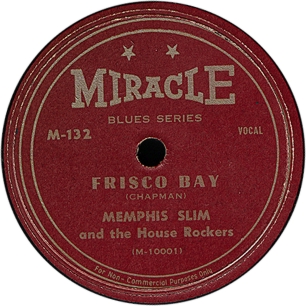
| Matrix | Artist | Title | Release # | Recording date | Release date |
| UB 9193[tk. 1 - damaged] | Eddie Chamblee and Orchestra | Song of India | unissued | c. 7/48 | |
| UB 9193[tk. 2 - inc] | Eddie Chamblee and Orchestra | Song of India | unissued | c. 7/48 | |
| UB 9193[tk. 3] | Eddie Chamblee and Orchestra | Song of India | Miracle 150 | c. 7/48 | 1949 |
| UB 9193[tk. 4?] | Eddie Chamblee and Orchestra | Song of India | unissued | c. 7/48 | |
| UB9194 [tk 1 - inc] | Browley Guy with Eddie Chamblee and Orchestra | I Shouldn't Care | unissued | c. 7/48 | |
| UB9194 [tk. 2] | Browley Guy with Eddie Chamblee and Orchestra | I Shouldn't Care | unissued | c. 7/48 | |
| UB9194 [tk. 3] | Browley Guy with Eddie Chamblee and Orchestra | I Shouldn't Care | unissued | c. 7/48 | |
| UB9194 [tk. 4 - fs] | Browley Guy with Eddie Chamblee and Orchestra | I Shouldn't Care | unissued | c. 7/48 | |
| UB9194 [tk. 5] | Browley Guy with Eddie Chamblee and Orchestra | I Shouldn't Care | unissued | c. 7/48 | |
| UB 9195 [tk. 1] | Eddie Chamblee and Band | Back Street | unissued | c. 7/48 | |
| UB 9195 [tk. 2 - fs] | Eddie Chamblee and Band | Back Street | unissued | c. 7/48 | |
| UB 9195 [tk. 3] | Eddie Chamblee and Band | Back Street | unissued | c. 7/48 | |
| UB 9195 SS [tk. 4] | Eddie Chamblee and Band | Back Street | Miracle 133 | c. 7/48 | 5/1949 |
| UB9196 [tk. 1] | Sharps and a Flat | See Me Go Baby | unissued | c. 7/48 | |
| UB9196 [tk. 2] | Sharps and a Flat | See Me Go Baby | unissued | c. 7/48 | |
| UB9196 [tk. 3] | Sharps and a Flat | See Me Go Baby | unissued | c. 7/48 | |
| UB9197 [tk. 1] | Sharps and a Flat | When Will I See You Again | unissued | c. 7/48 | |
| UB9197 [tk. 2 - fs] | Sharps and a Flat | When Will I See You Again | unissued | c. 7/48 | |
| UB9197 [tk. 3] | Sharps and a Flat | When Will I See You Again | unissued | c. 7/48 | |
| 9198 (UB 9198 SS in wax) [F-1010] |
Eddie Chamblee and Orchestra | Dureop Part I | Miracle 140 [Federal 12005] |
c. 7/48 | 10/1949 |
| 9199 [tk. 1 - inc] | Eddie Chamblee and Orchestra | Dureop Part II | unissued | c. 7/48 | |
| 9199 [tk. 2] | Eddie Chamblee and Orchestra | Dureop Part II | unissued | c. 7/48 | |
| 9199 [tk. 3] (UB 9199 SS in wax) [F-1011] |
Eddie Chamblee and Orchestra | Dureop Part II | Miracle 140 [Federal 12005] |
c. 7/48 | 10/1949 |
| UB 9200 | Eddie Chamblee and Orchestra | Cradle Rock | Miracle 150 | c. 7/48 | 1949 |
| UB 9201 | Sharps and a Flat | Hawaiian War Chant | unissued | c. 7/48 | |
| UB 9202 | Sharps and a Flat | I Knew He Would | unissued | c. 7/48 | |
| 9242 (UB9242SS in wax) |
St Louis Jimmy | Biscuit Roller | Miracle 134 | c. 8/48 | 1949 |
| 9243 (UB9243SS in wax) |
St Louis Jimmy | I'm Sorry Now | Miracle 134 | c. 8/48 | 1949 |
| UB 9244 SS [F1027] |
Eddie Chamblee and Band | Lazy Mood | Miracle 133 [Federal #] |
c. 8/48 | 5/1949 |
| UB 9264 [tk. 1] | Eddie Chamblee and Band | Dureop #2 | unissued | 8 or 9/48 | |
| UB 9264 [tk. 2] | Eddie Chamblee and Band | Dureop #2 | unissued | 8 or 9/48 | |
| UB 9264 [tk. 3] | Eddie Chamblee and Band | Dureop #2 | unissued | 8 or 9/48 | |
| UB9514SS | Rev. John Sellers | Evangelist Singer | Coming Back Home | Miracle 138 | c. 12/48 | 7/1949 |
| UB9515 | |||||
| UB9516 | |||||
| UB9517SS | Rev. John Sellers | Evangelist Singer | Day Is Passed | Miracle 138 | c. 12/48 | 7/1949 |
| UB10001 SS [M-10003 on label] |
Memphis Slim and The House Rockers | Timsy's Whimsy | Miracle 132 | 12/18-25/48 | 3/1949 |
| UB 10002 | |||||
| UB10003 SS [M-10001 on label] |
Memphis Slim and The House Rockers | Frisco Bay | Miracle 132 | 12/18-25/48 | 3/1949 |
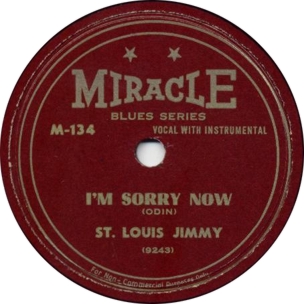
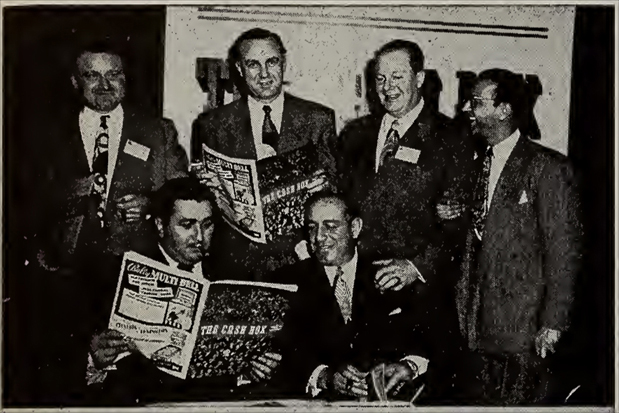
Miracle wasn't happy with its distributors in certain cities. In January 1949, it made a strong statement to this effect. Central Record Sales of Michigan opened in Detroit. It was a cooperative effort by Lee Egalnick at Miracle and two West Coast executives, Art Rupe of Specialty and Leo Mesner of Aladdin. According to Cash Box ("Three Indie Diskers Create First Cooperative Distributing Organization," January 15, 1949, p. 11), the Detroit operation was "only the first in a chain which these firms intend to open in territories where they have not been getting the distribution they believe their records deserve." The plan extended to Central Record Sales in Saint Louis, Chicago, and Los Angeles. Saint Louis, of course, was where Miracle had been ripped off by counterfeiters, who could not get their product into stores without help from crooked pressing plants and crooked distributors. On March 12, Billboard ("Combo Distrib Plan Expanded," p. 22; story dated March 5) reported that the Los Angeles Central Sales had opened, the Chicago Central Sales was about to open, and Egalnick was negotiating a buyout of Harry Ojile's HO Record Distributing in Saint Louis. The address for Central Sales of Chicago was 500 East 63rd Street.
In June, Art Spiegel, a one-time partner in Aristocrat, took over as manager (Billboard, June 18, 1949, p. 22) of the Chicago Central Sales, which was now at a different address.
In the end, the Central Record Sales experiment (the last branch to open was in New York City, and Miracle may not have participated) didn't move the quantities of product that Miracle wanted. But it served as a model for a later effort in Chicago, Monroe Passis' Record Distributors, Inc.
The tremendous success of the Sonny Thompson hits, "Long Gone" and "Late Freight," both of which crucially depended on Eddie Chamblee's sax work, produced huge dividends for the tenorist. In January 1949, he formed a combo of his own consisting of Jimmy Craig (piano), Eugene Wright (bass), and Chuck Williams (drums), and began a lengthy engagement at the Blue Heaven Lounge, 742 East 63rd street. The Chicago Defender gushed, "'Rockin' Rhythm' is what Eddie (Long Gone) Chamblee and his combo call it... It combines blues, bop, and swing in a manner fit for the most severe critic of present day music. A favorite on the juke box, Eddie has hit the top with his sax solos on 'Long Gone' and 'Late Freight.'"
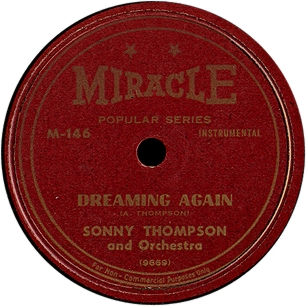
Meanwhile, Sonny Thompson cut his last two sessions for the label. By now he had put together his own touring group, featuring two tenor saxes and a trumpet in the front line, and the Sharps and Flats' contract with Miracle had run out.
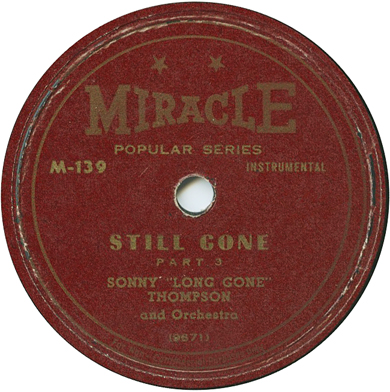
Thompson's April session was done with Floyd Jones (trumpet), Eddie Chamblee (back on tenor sax by popular demand), Leo Blevins (guitar), Curtis Ferguson (bass), and Sonny Cole (drums). (This was the Floyd Jones who played trumpet and sang, changing his name to Floyd Valentine when he recorded for Vee-Jay in 1954. He made the name change to avoid confusion with the Floyd Jones who played guitar and sang the blues for Marvel, Tempo-Tone, JOB, Chess—and Vee-Jay.) Not credited in the existing discographies is a second tenor saxophonist, who sounds to us like Thompson's one-time bandleader Dick Davis. The slow blues called "Dreaming Again" (featuring solos by Jones, Davis, and the leader) and the two-sided "Still Gone" were drawn entirely from the April session. "Still Gone Part 3" continues "Long Gone" with a featured solos by Chamblee and riffing by the horn section; "Part 4" picks up with Blevins' guitar and the leader's piano prestidigitation.
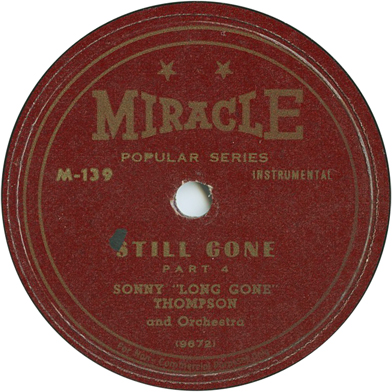
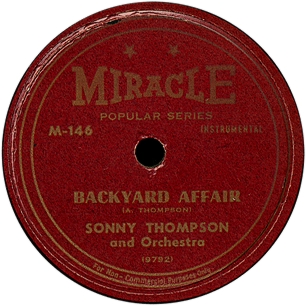
Meanwhile, "The Fish" (released by Old Swing-Master in March 1950) took one side from this session and its mate from the next one, with no discernible ill effects. Also known as "Jam, Sonny, Jam," Part I is a bop-flavored blues instrumental with a whomping backbeat: solos are by Davis, Blevins, Jones, Chamblee, and Thompson. Because the instrumental was initially titled "Jam, Sonny, Jam" on the acetates that were acquired by King, one take has been issued under this title. Additional work will be needed to sort out which of the 3 complete takes was originally issued as "The Fish-I" and which showed up years later as "Jam, Sonny, Jam."
In June, Thompson returned to the studio with Dick Davis on tenor sax, along with Floyd Jones on trumpet, a second tenor sax, guitar, bass, and drums; they quickly cut five sides. The lineup appears to be the same as on the April session, except for the guitarist. On "Backyard Affair," Floyd Jones gets some exposure. Apparently the company was sufficiently encouraged by "I Really Did" that it allowed Thompson to try two ballad vocals on this session. The first was a decent performance of "Danny Boy." Dick Davis takes a lengthy opening solo rather reminiscent of Don Byas's famous rendition. The leader continued with "I'll Get Along Somehow," one of the better lounge ballads that Miracle recorded. But the ballads were left in the can. "The Fish-II" is an R∓B riff-based instrumental that carries over the backbeat from Part I; it includes solo spots for Thompson and Davis. "Sonny Claus Blues" features Davis (who throws in a reed bite or two) over riffing horns, Thompson's blues vocal, and a sparkling piano solo over a different riff. Miracle was sufficiently interested in Thompson's efforts as a blues singer to put "Sonny Claus Blues" b/w "Not on a Xmas Tree" on Miracle 148, around November 1949. But the release was a bit of a stealth operation. There were no vocal credits—and "Sonny Claus" was identified on the label as an instrumental!
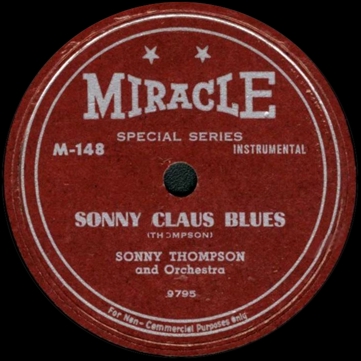
Sales must have been going well for Miracle through April of 1949. Still pulling in coin from Eddie Chamblee's Miracle 133, "Lee Egalnick, prexy of Miracle Records, recently announced that the firm plans to release new records every ten days, so keep your eyes on Miracle" (Cash Box, May 21, 1949, p. 9). He didn't make good on that promise. A single every ten days would have brought his releases up to Miracle 156 by the end of December. All the same, several new artists were signed and recorded by the company in 1949: pianist Tommy Dean, gospel singer Cleophus Robinson, the popular radio vocal group, the Four Vagabonds, the Bill Samuels Trio, and gospel singer Robert Anderson.
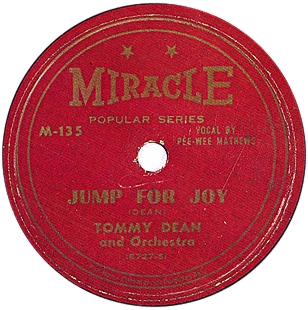
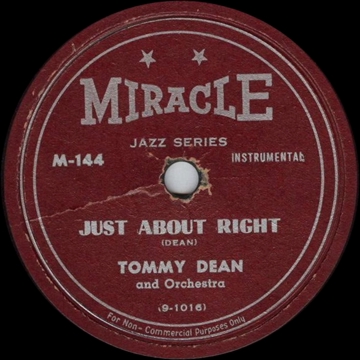
R&B pianist Tommy Dean was a veteran club performer when he recorded for Miracle in 1949. Dean was born on September 6, 1909, in Franklin, Louisiana and raised in Beaumont, Texas; he got his early experience performing in carnivals and circuses. While playing at an outdoor road show in St. Louis, probably in 1937, he came to the attention of bandleader Eddie Randle who hired him as a sideman for his band, the Seven Blue Devils. In the late 1930s, Dean went out on his own and played throughout the Midwest, the Southwest, and even Mexico for the next decade. In 1945 and 1947, he held down several South Side engagements under the banner "Tommy Dean and His St. Louisians," working such clubs as the Hurricane Show Lounge (349 East Garfield) and Blue Heaven Theatre Lounge (742 East 63rd). He made his recording debut in 1947 for a small St. Louis label, Town & Country, with a band that included Gene Easton, Chris Woods, and Pee Wee Jernigan. Dean's combos were known for the easy swing that they generated, and the first-rate saxophone soloists that the leader employed.
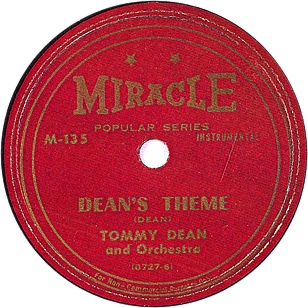
Dean's signing was announced in Billboard for April 30, 1949: in the same issue in the same item that revealed that Sunrise and Miracle were splitting. "Miracle has inked Connie [sic!] Dean's ork to a pact at the suggestion of Spider Burke, St. Louis Negro d. j." (p. 42). Miracle and Tommy Dean were not off to a good start. Spider Burke obviously knew Egalnick and Simpkins; a Tab Smith title on Premium would be dedicated to him.

The combo that recorded for Miracle included—besides Dean at the piano—Chris Woods on alto sax, Edgar Hayes on tenor sax, Gene Easton on baritone sax, an unidentified bass player, and Nathaniel "Pee Wee" Jernigan on drums. The matrix numbers on Miracle 135 are outside any of the Miracle series. One Pee-Wee Matthews is identified as the singer on "Jump for Joy." Two Pee Wees in one band? According to Harry Webber's "St. Louis Nights" column in the Pittsburgh Courier:
Melvin Matthews, better known as "Pee Wee," boss of the blues, did some fine numbers Wednesday night with Tommy Deans [sic] Combo at the Glass Bar (December 6, 1947, p. 12)
The implication was that Matthews sometimes performed with Dean but wasn't a member of the band.
Both sides of Miracle 135 look like recordings made in Saint Louis, probably a little before Dean's signing was announced.
Egalnick and Simpkins went ahead with a Chicago recording session for Dean, at United Broadcasting Studio during July or August 1949. The other Pee Wee, Jernigan, sang on "Sweet and Lovely" (Miracle 144), and "Scamon Boogie" (Miracle 157). Instrumentals were "Just about Right" (Miracle 144), and "Hour Past Midnight" (Miracle 157). Except for the recording date, our information is derived from Tom Lord's Jazz Discography, with help from collector Dieter Hartmann. Hartmann's copy of Miracle 144 has UB9-1011 on it for "Sweet and Lovely," but this is a typo; previous discographies and the actual masters agree on 9-1017 as the correct number.
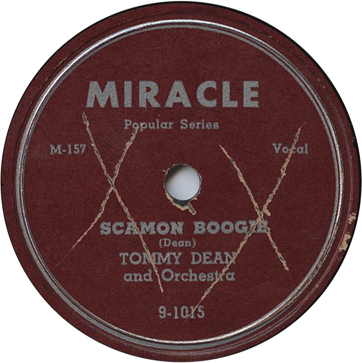
There are complete alternate takes of three of the Dean sides that were freshly recorded for Miracle. "Sweet and Lovely," featuring an outstanding introduction by Chris Woods and a decent ballad vocal by Jernigan, was finished in one take, after a false start.
Now that back issues of the trades are widely available online, we can sadly report that the Tommy Dean Miracles were never mentioned at all in Cash Box, and the company placed no ads for them there. Miracle 135 and 144 were advertised in Billboard.
Reverend Cleophus Robinson was born on March 18, 1932, in Canton, Mississippi, and moved to Chicago in 1948. His four-tune session led to one release. Miracle 142, featuring a stirring rendition of "Now Lord" and an extremely slow recital of "I Love the Name Jesus," came out in September 1949 under the name Brother Cleophus Robinson (it was advertised well before that, but the schedule may have slipped). Since the singer was 17 years old (Miracle ads said 16), Brother was a more appropriate honorific than Reverend. The other two titles have never been issued. Robinson went through 13 takes of "Eternal Home," but after approving take 12, Miracle decided to release Robert Anderson's rendition instead. After all that travail, "I Love the Name Jesus" and "My Prayer" were done in a single take. Robinson sang affectingly in a grainily wistful tenor, to the customary gospel accompaniment of organ and piano. His outing with Miracle failed to launch his recording career, which was not firmly established until 1953 when he began an extensive series of releases for Houston-based Peacock. He died on July 2, 1998.
The Four Vagabonds—John Jordan (lead), Norval Taborn (baritone), Robert O'Neal (first tenor), and Ray Grant (guitar/bass vocals)—were formed at Vashon High School in St. Louis in 1933. In 1936 they came to Chicago, and began a decade-long stay, performing three times a week on the famed Don McNeil Breakfast Club network radio show. In 1938 they began performing on Club Matinee, hosted by Garry Moore, Durward Kirby, and Ransom Sherman. The Vagabonds developed a vast repertoire and became know for their work on radio. They recorded once in 1941 and twice in 1943 (not being subject to the first Petrillo ban, at least not when Roy Grant switched to ukulele) for Bluebird. They also made at least 50 Standard Transcriptions in 1943. Their Victor contract expired early in 1945 and the Vagabonds made one session for Atlas before making another one-off, around end of the year with the brand-new Mercury operation. Signing with Apollo, they recorded sessions in November 1946, March 1947, and July 1947, but were disappointed with the label's lack of promotion for their records. Without a recording deal, hampered by Roy Grant's blindness (his eyesight had been gone since late 1945), the group broke up around February 1948.
When Grant recovered his vision, the Vagabonds reformed in early 1949. Probably in Feburary, they did a session with singer Gloria Van for the super-obscure VRT label, recording two songs written by Rose Mary Trabucco and Bill Walker. In April, they appeared on the Happy Pappy show on WENR-TV. In May, Ray Grant started a new group called the Swanee Larks (which will make its own appearance later in this story) and arranger Bill Sanford replaced him as guitarist and bass singer. With Sanford in for Grant, the Vagabonds cut four sides for Miracle during the first half of June 1949. Two were supposed to be released on July 25. It appears they stumbled out instead in November.
Cash Box ran one of those "just signed" notices on the Vagabonds on June 18, 1949 (p. 9; Billboard ran one on the same day, p. 22). A release was then said to be imminent. The recordings were mentioned in the Chicago Defender of June 25, 1949, which also stated that "When Will I See You Again" featured an accompaniment on the celeste. Really, the session pianist plays an arpeggio on the celeste to introduce the song. (A session bassist can also be heard, alongside Bill Sanford's rhythm guitar.) Then their first Miracle was advertised (without a relase number) and an anticipated date of July 25 (Cash Box, July 30, 1949, p. 25). Nope, not yet. The Vagabonds' sides feature immensely polished harmony singing in a Swing idiom; John Jordan's relaxed lead completely avoids the lugubriousness that too often afflicted Browley Guy's performances. The group imparts a bounce to "Sorry That We Said Goodbye" (the same tune that Savannah Strong recorded with Dick Davis on the first session for the label, in June 1946). While talking to researcher Marv Goldberg, Jordan's only recollection of Miracle was how "dumpy" their studio was (not a compliment to United Broadcasting!).
The Miracle sides were the group's last recordings under their own name. With bass Frank Houston replacing Sanford (by the time Miracle 141 finally hit the stores, Sanford had become the Ravens' arranger), the group continued to tour. From November 1951 through April 1952, the Vagabonds were featured on the NBC radio show, Johnny Desmond Goes to College. They broke up shortly after the radio program finished its run. (See the thorough biography of the group by Rick Whitesell, Pete Grendysa, George Moonoogian, and Marv Goldberg, The 4 Vagabonds, at http://www.uncamarvy.com/4Vagabonds/4vagabonds.html).
The unsettling trend toward publicizing but not releasing continued with Browley Guy's session, on which the lounge singer was backed by a group led by veteran violinist Leon Abbey. The recordings were reported in Down Beat on May 20, 1949 (p. 4). The Down Beat article supplies the titles; our thanks to jazz violin expert Anthony Barnett for turning up this reference. The Ace Records list confirms the four titles but the matrix numbers it supplies are in the UB9300s. The UB9000 series is a much more complicated beast than the UB2000, because deliberate misdirection was involved. On their face these numbers suggest a recording date some months earlier, even in the fall of 1948. But the assignments were scrambled, and on the strength of the mention in Down Beat, we have left the sides on the 1949 list. Abbey used his regular pianist, Barrington Perry, and bassist, Rail Wilson; John Goodloe's guitar was added for the date.
Guy sings solo on the session—no Skyscrapers in evidence. Though still drippy, his remake of "Out of Nowhere" is a good deal more tasteful than his first attempt from August 1947. "I've Got My Love to Keep Me Warm" swings nicely; had he done more things like it, Guy could have persuaded his audience that he was a jazz singer. "Marie" is a sappier song, but it also swings. Only "You Will Remain in My Heart" remains mired in lugubriousness. Abbey and his trio provide effective backing, nudging Guy into more of a jazz groove than Sonny Thompson could, and Abbey's accompaniments and solos are a significant addition to his fairly slim discography. Perry's brief piano solos and Goodloe's brief guitar solos are also effective.
Although Lee Egalnick had high hopes for Browley Guy, who had 5 previous outings under his belt, this would be his last session for the company. Meanwhile, during a much longer career, Leon Abbey had made a few unreleased sides of his own.
Although Miracle had not recorded the group since 1947, Egalnick and Simpkins were presumably not pleased when Mercury signed the Floyd Hunt Quintet, as announced in Billboard on May 7, 1949 (p. 20).
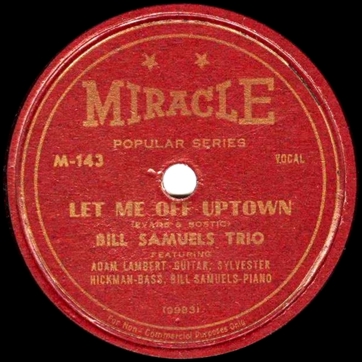
The company returned the favor when it picked up a former Mercury act. The first recording session took place in July, but as was customary, news of the signing was delayed (Billboard, September 10, 1949, p. 42; Cash Box, September 24, 1949, p. 10). By the time the Bill Samuels Trio—featuring pianist/lead vocalist Bill Samuels, bassist Sylvester Hickman, and guitarist Adam Lambert—recorded for Miracle in the summer of 1949, the trio had already made a name for themselves as major recording stars (some of those earlier recordings had also included drummer Hillard Brown). Bill Samuels and the Cats 'n Jammer Three came together in the spring of 1945, and shortly thereafter became the second act to be signed by the fledging major, Mercury Records. Their first record, a smooth ballad presentation of "I Cover the Waterfront" (b/w "Jockey Blues," Mercury 2003) was a national hit, going through many pressing runs and selling some 250,000 copies. (For some reason, the group remade both sides in December 1945, though the remakes were not released till several years later.) Today the first Bill Samuels record is easy to find, nearly always in heavily played condition. Peter Grendysa in his ground-breaking article on the group, "Blues and Jazz Collide in Chicago: Cats 'n' Jammers; Four Shades of Rhythm" (Record Collector's Monthly, April 1983) said the group represented the coming together of jazz, blues and pop, and that this fusion "was the direct ancestor of rhythm-and-blues and rock-and-roll." Mercury recorded the group regularly through the big rush of recording activity at the end of 1947 (one session in 1947 featured Bill Samuels with the Ram Ramirez Orchestra instead of the trio). The company put out no fewer than 28 sides by the Cats 'n' Jammers before releasing them from their contract in early 1949.
"So Tired" put the focus on Samuels' ballad singing and Adam Lambert's solo work on the guitar; it is one of several from this session to employ two or three extra voices behind Samuels. The singers got a little more to do on the blue ballad "Delta Bound." The session featured no fewer than 9 takes of the standard "That Old Black Magic," done to a rhumba beat. The company wasn't happy with the results, however; Samuels, who sang this version solo, comes across as enervated (would listeners have thought he was "aflame with such burning desire"?), and his diction is curiously slack. A second standard, "How Deep Is the Ocean," posed no problems for the group; a strong performance was done in a single take. "Say It Isn't So" also came out well; the extra singers could have been left out without anyone noticing, and the guitar solo by Lambert is a bonus. It was selected for release on Miracle 143. Samuels' rather overripe bass-baritone will not be to everyone's taste, however. The other side of 143, "Let Me Off Uptown" is short and bouncy (we didn't hear it till recently, because the master went missing at some point and was not on Ace Records' list in 2005).
The four sides that Miracle released on the Samuels group, out of a total of 12 recorded under their new name, were their last. The trio broke up in 1950, when Bill Samuels moved to Minneapolis. Lambert then joined the Four Shades of Rhythm (he was in the edition of the group that recorded for Chance in 1952) and Hickman continued to play in various local combos in Chicago throughout the 1950s.
By July, Egalnick had lost his bravado and started inserting delays into his release schedule. In a letter that he mailed to Miracle's distributors (we hope it's preserved somewhere in its entirety), he wrote:
It has been some time now, since I have written you to give you some of my sage advice on "Why The Record Business Is So Great" (If you get a chance to go into the grocery business, don't be a Schmoe, grab it!)…
In the past couple of weeks we have sent you some new samples. If you don't have anything to do in the next six to eight months, would you be kind enough to listen to them…
While I have your attention for a moment, may I say that Memphis Slim's new number [Miracle 136] is really going great guns. Those of you who are enjoying its success and ordering it accordingly may now step out for a short beer. Those of you who are ordering it like it had B.O., may I ask what it takes to have you consider it a good number… ("Chides Disk Biz — Sales Zoom Upward," Cash Box, July 16, 1949, p. 10)
Cash Box ran excerpts because Egalnick had given the recipients permission to quote it anywhere they liked. "You can also give it to anyone writing a psychiatric study of record manufacturers." Most of his distributors reponded in the near term with new orders. Then the effect wore off.
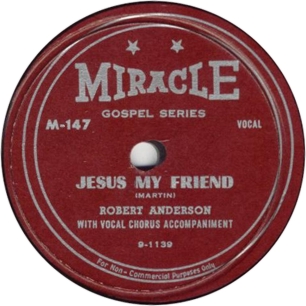
In August, Miracle began recording the great gospel singer, Robert Anderson. He was born March 21, 1919, in Anguila, Mississippi. In Chicago by 1935, he was already making a name for himself as a 16-year-old member of the famed Roberta Martin Singers. He left Roberta Martin in 1939 to go solo. His electrifying performance of "Something Within" at the National Baptist Convention in 1943 established his national reputation. According to Horace Clarence Boyer, in How Sweet the Sound, Anderson was "a true baritone singing in a style similar to such then-popular singers as Billy Eckstine and Bing Crosby. His style was marked by fullness of tune, few embellishments, and little physical activity while singing" (p. 71). Boyer uses Anderson as an example of a gospel singer who could move audiences without histrionics or "hard gospel" vocal techniques.
Anderson was accompanied on his initial session by an organist and a pianist. "My Home over There" is taken at an extremely slow tempo by Anderson singing solo with just organ accompaniment. However, by this time he was already working with a female backup group—his Gospel Caravan—and they appear on at least two of the four sides from the session. (The Miracle labels just credit "Vocal Chorus Accompaniment," and on "King Jesus" the Gospel Caravan seems to be reinforced by a couple of male singers.)
Miracle had a major star in Anderson, and quickly released four sides on him (we have put Miracle 147 and Anderson's 151 in September 1949; however, "Miracle has inked Robert Anderson, Baptist singer, and his choir to a long term pact" appeared on October 29 (Billboard, p. 48). Evidently the response was not what the company had hoped, because in November Miracle took out an ad in the Chicago Defender asking readers to suggest gospel songs for Anderson to record.
Distribution was still a sore point. In September, Egalnick and Simpkins pulled out of the Chicago Central Record Sales, after first leaving the St. Louis branch and then the branch in Detroit. What was left of Chicago Central Sales was soldiering on (it lasted another couple of months with Aladdin and Specialty) but Art Spiegel was being replaced as manager. "For the time being, Egalnick is working this area for Miracle from his hom office here" ("Miracle Ankles Co-Op Distrib," Billboard, October 1, 1949, p. 40; bylined Chicago, September 24).
Memphis Slim was continuing to sell records for the company (a couple of his releases were the last from Miracle to chart regionally). However, Egalnick had plenty of back catalog that he could move, and Slim and combo were spending most of their time on the road. They recorded for King in Cincinnati in January (a clandestine session to remake four of Slim's Hy-Tone sides, which were purposely given the same matrix numbers as before). The remake session was divulged to Cash Box , in a story that nearly gave Egalnick and Simpkins each a heart attack: supposedly King had signed Memphis Slim ("King Records Pact Three Artists," Cash Box, March 5, 1949, p. 16). The trade had to publish a quick retraction ("Memphis Slim Not Signed to King Pact," March 19, 1949, p. 14a). Slim and House Rockers went on to record for Peacock in Houston (an 8-title session, which took place at some point later in the year). Obviously made in violation of Slim's Miracle contract, six of the Peacock sides were never issued and two were held for release till 1951. In October, Miracle did manage to work in one last session with Slim and the gang. But just one of the tracks made that day, a Charles Brown-influenced blues ballad called "You and I," was issued on Miracle. By this time Memphis Slim's group consisted of Alex Atkins, alto sax; Timothy Overton, tenor sax; probably Alfred Elkins, bass; and Leon Hooper, drums. We believe the missing tracks from this session were dealt to Egmont Sonderling in March 1950 to cover some of the label's debts for recording and pressing; any not released on Master are presumably lost.
After the Slim session, Miracle took a hiatus from recording. Lee and Francine's second son, Kenneth, was born on October 14, 1949. The company was having more trouble with distribution. The New York branch of Central Record Sales, which ended up taking a different name, AMS, may have been restricted to Aladdin, its Score subsidiary, and Specialty. When Cash Box (February 12, 1949, p. 7) announced its formation, Jim Warren of Central Record Sales was in the city to set up the branch, only Aladdin and Specialty were said to be participating. By the end of November, AMS had closed, and Portem took over its lines ("Portem to Distrib Specialty & Aladdin, Billboard, December 3, 1949, p. 14; story dated November 26). In Chicago, Evelyn Aron and Art Sheridan's American Record Distributors, which opened in mid-December, would inherit Aladdin and Specialty from Central Sales there.
The company could not afford further sessions. The hits had stopped coming. Egalnick and Simpkins milked Memphis Slim's Miracle 136 for sales as long as they could, then got a little out of Slim's Miracle 145. By February 1950 Cash Box was listing King 4312 by Memphis Slim, then doing modest regional action, as though it was a Miracle release. That had to hurt.
Total output for 1949 adds up to 38 masters. However, UB9-1280 from Memphis Slim's last session for Miracle would normally have had three mates, and we think one of them was released on the Master label early the next year. So we'll bump the estimate up to 41.
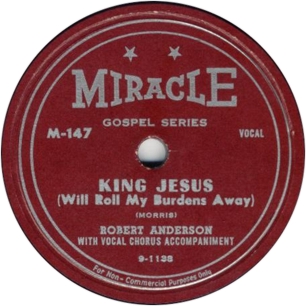
| Matrix | Artist | Title | Release # | Recording date | Release date |
| UB9669 [tk. 1] | Sonny Thompson and Orchestra | Dreaming Again | unissued | c. 4/49 | |
| UB9669 [tk. 2] | Sonny Thompson and Orchestra | Dreaming Again | unissued | c. 4/49 | |
| UB9669SS [tk. 3?] | Sonny Thompson and Orchestra | Dreaming Again | Miracle 146 | c. 4/49 | 10/1949 |
| UB9669 [tk. 4 - fs] | Sonny Thompson and Orchestra | Dreaming Again | unissued | c. 4/49 | |
| UB9669 [tk. 5] | Sonny Thompson and Orchestra | Dreaming Again | unissued | c. 4/49 | |
| UB 9670 (M523-1) [tk. 1?] |
Sonny Thompson and Orchestra | Jam, Sonny, Jam | (Omega [Br] 78635) (Sequel CD900) |
c. 4/49 | (1996) |
| UB 9670 (M523-1) [tk. 2 - fs] |
Sonny Thompson & his Orchestra | Jam, Sonny, Jam | unissued | c. 4/49 | |
| UB9670 M1 [M509-1] [tk. 3?] |
Sonny Thompson and His Orchestra | The Fish-I | Old Swing-Master 1011 Master 1011 (Esquire [Br] 10-339) Omega [Br] 78635) |
c. 4/49 | prob. 12/1949 |
| UB 9670 (M523-1) [tk. 4] |
Sonny Thompson & his Orchestra | Jam, Sonny, Jam | unissued | c. 4/49 | |
| UB9671 [tk. 1] | Sonny "Long Gone" Thompson and Orchestra | Still Gone Part 3 | unissued | c. 4/49 | |
| UB9671 [prob. tk. 2] | Sonny "Long Gone" Thompson and Orchestra | Still Gone Part 3 | Miracle 139 | c. 4/49 | 7/1949 |
| UB9672 [tk. 1 - fs] | Sonny "Long Gone" Thompson and Orchestra | Still Gone Part 4 | unissued | c. 4/49 | |
| UB9672 [tk. 2] | Sonny "Long Gone" Thompson and Orchestra | Still Gone Part 4 | unissued | c. 4/49 | |
| UB9672 [prob. tk. 3] | Sonny "Long Gone" Thompson and Orchestra | Still Gone Part 4 | Miracle 139 | c. 4/49 | 7/1949 |
| 8727-5 | Tommy Dean and Orchestra | Vocal by Pee-Wee Mathews [sic] | Jump for Joy | Miracle 135 | 4/49 [St. Louis] |
7/1949 |
| 8727-6 | Tommy Dean and Orchestra | Dean's Theme | Miracle 135 | 4/49 [St. Louis] |
7/1949 |
| UB 9306 [tk. 1] | Browley Guy with Leon Abbey and his Orchestra | Oh Marie | unissued | c. 5/49 | |
| UB 9306 [tk. 2] | Browley Guy with Leon Abbey and his Orchestra | Oh Marie | rejected | c. 5/49 | |
| UB 9306 [tk. 3] | Browley Guy with Leon Abbey and his Orchestra | Oh Marie | unissued | c. 5/49 | |
| UB 9306 [tk. 4] | Browley Guy with Leon Abbey and his Orchestra | Oh Marie | unissued | c. 5/49 | |
| UB 9306 [tk. 5] | Browley Guy with Leon Abbey and his Orchestra | Oh Marie | unissued | c. 5/49 | |
| UB 9306 [tk. 6] | Browley Guy with Leon Abbey and his Orchestra | Oh Marie | unissued | c. 5/49 | |
| UB 9307 [tk. 1 - inc] | Browley Guy with Leon Abbey and his Orchestra | You Will Remain in My Heart | unissued | c. 5/49 | |
| UB 9307 [tk. 2 - fs] | Browley Guy with Leon Abbey and his Orchestra | You Will Remain in My Heart | unissued | c. 5/49 | |
| UB 9307 [tk. 3] | Browley Guy with Leon Abbey and his Orchestra | You Will Remain in My Heart | unissued | c. 5/49 | |
| UB 9308 [tk. 1 - inc] | Browley Guy with Leon Abbey and his Orchestra | Out of Nowhere | unissued | c. 5/49 | |
| UB 9308 [tk. 2 - fs] | Browley Guy with Leon Abbey and his Orchestra | Out of Nowhere | unissued | c. 5/49 | |
| UB 9308 [tk. 3 - fs] | Browley Guy with Leon Abbey and his Orchestra | Out of Nowhere | unissued | c. 5/49 | |
| UB 9308 [tk. 4 - inc] | Browley Guy with Leon Abbey and his Orchestra | Out of Nowhere | unissued | c. 5/49 | |
| UB 9308 [tk. 5] | Browley Guy with Leon Abbey and his Orchestra | Out of Nowhere | unissued | c. 5/49 | |
| UB 9308 [tk. 6] | Browley Guy with Leon Abbey and his Orchestra | Out of Nowhere | unissued | c. 5/49 | |
| UB 9308 [tk. 7] | Browley Guy with Leon Abbey and his Orchestra | Out of Nowhere | unissued | c. 5/49 | |
| UB 9309 [tk. 1 - fs] | Browley Guy with Leon Abbey and his Orchestra | I've Got My Love to Keep Me Warm | unissued | c. 5/49 | |
| UB 9309 [tk. 2 - inc] | Browley Guy with Leon Abbey and his Orchestra | I've Got My Love to Keep Me Warm | unissued | c. 5/49 | |
| UB 9309 [tk. 3 - inc] | Browley Guy with Leon Abbey and his Orchestra | I've Got My Love to Keep Me Warm | unissued | c. 5/49 | |
| UB 9309 [tk. 4 - inc] | Browley Guy with Leon Abbey and his Orchestra | I've Got My Love to Keep Me Warm | unissued | c. 5/49 | |
| UB 9309 [tk. 5 - inc] | Browley Guy with Leon Abbey and his Orchestra | I've Got My Love to Keep Me Warm | unissued | c. 5/49 | |
| UB 9309 [tk. 6] | Browley Guy with Leon Abbey and his Orchestra | I've Got My Love to Keep Me Warm | unissued | c. 5/49 | |
| UB 9309 [tk. 7] | Browley Guy with Leon Abbey and his Orchestra | I've Got My Love to Keep Me Warm | unissued | c. 5/49 | |
| UB9728 [tk. 1 - fs] | Brother Cleophus Robinson | Eternal Home | unissued | 6/49 | |
| UB9728 [tk. 2 - fs] | Brother Cleophus Robinson | Eternal Home | unissued | 6/49 | |
| UB9728 [tk. 3 - inc] | Brother Cleophus Robinson | Eternal Home | unissued | 6/49 | |
| UB9728 [tk. 4 - inc] | Brother Cleophus Robinson | Eternal Home | unissued | 6/49 | |
| UB9728 [tk. 5] | Brother Cleophus Robinson | Eternal Home | unissued | 6/49 | |
| UB9728 [tk. 6 - inc] | Brother Cleophus Robinson | Eternal Home | unissued | 6/49 | |
| UB9728 [tk. 7] | Brother Cleophus Robinson | Eternal Home | unissued | 6/49 | |
| UB9728 [tk. 8] | Brother Cleophus Robinson | Eternal Home | unissued | 6/49 | |
| UB9728 [tk. 9 - inc] | Brother Cleophus Robinson | Eternal Home | unissued | 6/49 | |
| UB9728 [tk. 10] | Brother Cleophus Robinson | Eternal Home | unissued | 6/49 | |
| UB9728 [tk. 11] | Brother Cleophus Robinson | Eternal Home | unissued | 6/49 | |
| UB9728 [tk. 12] | Brother Cleophus Robinson | Eternal Home | unissued | 6/49 | |
| UB9728 [tk. 13] | Brother Cleophus Robinson | Eternal Home | unissued | 6/49 | |
| UB9729 [tk. 1] | Brother Cleophus Robinson | Now Lord | unissued | 6/49 | |
| UB9729 [tk. 2?] | Brother Cleophus Robinson | Now Lord | Miracle 142 | 6/49 | 7/1949 |
| UB9730 | Brother Cleophus Robinson | I Love the Name Jesus | Miracle 142 | 6/49 | 7/1949 |
| UB9731 | Brother Cleophus Robinson | My Prayer | unissued | 6/49 | |
| UB9741 [tk. 1] | Four Vagabonds | Mighty Hard to Go thru Life Alone | unissued | 6/49 | |
| UB9741 [tk. 2] | Four Vagabonds | Mighty Hard to Go thru Life Alone | unissued | 6/49 | |
| UB9741 [tk. 3 - fs] | Four Vagabonds | Mighty Hard to Go thru Life Alone | unissued | 6/49 | |
| UB9741 [tk. 4] | Four Vagabonds | Mighty Hard to Go thru Life Alone | unissued | 6/49 | |
| UB9741 [tk. 5?] | Four Vagabonds | Mighty Hard to Go thru Life Alone | Miracle 141 | 6/49 | 11/1949 |
| UB9742 [tk. 1 - inc] | Four Vagabonds | Sorry That We Said Goodbye | unissued | 6/49 | |
| UB9742 [tk. 2 - fs] | Four Vagabonds | Sorry That We Said Goodbye | unissued | 6/49 | |
| UB9742 [tk. 3] | Four Vagabonds | Sorry That We Said Goodbye | unissued | 6/49 | |
| UB9742 [tk. 4] | Four Vagabonds | Sorry That We Said Goodbye | unissued | 6/49 | |
| UB9743 [tk. 1] | Four Vagabonds | When Will I See You Again | unissued | 6/49 | |
| UB9743 [tk. 2 - inc] | Four Vagabonds | When Will I See You Again | unissued | 6/49 | |
| UB9743 [tk. 3 - fs] | Four Vagabonds | When Will I See You Again | unissued | 6/49 | |
| UB9743 [tk. 4 - inc] | Four Vagabonds | When Will I See You Again | unissued | 6/49 | |
| UB9743 [tk. 5] | Four Vagabonds | When Will I See You Again | unissued | 6/49 | |
| UB9744 | Four Vagabonds | My Heart Cries | Miracle 141 | 6/49 | 11/1949 |
| UB9792SS | Sonny Thompson and Orchestra | Backyard Affair | Miracle 146 | 6/49 | 10/1949 |
| UB9793 [tk. 1] | Sonny Thompson and His Orchestra | The Fish-II | unissued | 6/49 | |
| UB9793 [tk. 2 - inc] | Sonny Thompson and His Orchestra | The Fish-II | unissued | 6/49 | |
| UB9793 [tk. 3 - fs] | Sonny Thompson and His Orchestra | The Fish-II | unissued | 6/49 | |
| UB9793 [tk. 4 - inc] | Sonny Thompson and His Orchestra | The Fish-II | unissued | 6/49 | |
| UB9793 [tk. 5] | Sonny Thompson and His Orchestra | The Fish-II | unissued | 6/49 | |
| UB9793 M-2 [prob. tk. 6] | Sonny Thompson and His Orchestra | The Fish-II | Master 1011 Old Swing-Master 1011 |
6/49 | prob. 12/1949 |
| UB9794 [tk. 1] | Sonny Thompson and His Orchestra | I'll Get Along Somehow | unissued | 6/49 | |
| UB9794 [tk. 2] | Sonny Thompson and His Orchestra | I'll Get Along Somehow | unissued | 6/49 | |
| UB9795 [tk. 1] | Sonny Thompson and His Orchestra | Danny Boy | unissued | 6/49 | |
| UB9795 [tk. 2 - inc] | Sonny Thompson and His Orchestra | Danny Boy | unissued | 6/49 | |
| UB9795 [tk. 3] | Sonny Thompson and His Orchestra | Danny Boy | unissued | 6/49 | |
| UB9795 [tk. 4] | Sonny Thompson and His Orchestra | Danny Boy | unissued | 6/49 | |
| UB9795 [tk. 5 - inc] | Sonny Thompson and His Orchestra | Danny Boy | unissued | 6/49 | |
| UB9795 [tk. 6 - inc] | Sonny Thompson and His Orchestra | Danny Boy | unissued | 6/49 | |
| UB9795 [tk. 7] | Sonny Thompson and His Orchestra | Danny Boy | unissued | 6/49 | |
9795 |
Royal Brent [Sonny Thompson] | Danny Boy | Rockin' 521 | 6/49 | 1953 |
| UB9796 SS 9795 [sic] on label |
Sonny Thompson and Orchestra | Sonny Claus Blues | Miracle 148 | 6/49 | c. 11/1949 |
| UB 9982 | Bill Samuels Trio | So Tired | unissued | 7/49 | |
| UB 9983 SS | Bill Samuels Trio Featuring Adam Lambert - Guitar, Sylvester Hickman - Bass, Bill Samuels - Piano | Let Me Off Uptown | Miracle 143 | 7/49 | 10/1949 |
| UB 9984 [tk. 1 - fs] | Bill Samuels Trio | Say It Isn't So | unissued | 7/49 | |
| UB 9984 SS [tk. 2] | Bill Samuels Trio Featuring Adam Lambert - Guitar, Sylvester Hickman - Bass, Bill Samuels - Piano | Say It Isn't So | Miracle 143 | 7/49 | 10/1949 |
| UB 9985 [tk. 1] | Bill Samuels Trio | That Old Black Magic | unissued | 7/49 | |
| UB 9985 [tk. 2 - inc] | Bill Samuels Trio | That Old Black Magic | unissued | 7/49 | |
| UB 9985 [tk. 3] | Bill Samuels Trio | That Old Black Magic | unissued | 7/49 | |
| UB 9985 [tk. 4] | Bill Samuels Trio | That Old Black Magic | unissued | 7/49 | |
| UB 9985 [tk. 5] | Bill Samuels Trio | That Old Black Magic | unissued | 7/49 | |
| UB 9985 [tk. 6] | Bill Samuels Trio | That Old Black Magic | unissued | 7/49 | |
| UB 9985 [tk. 7 - fs] | Bill Samuels Trio | That Old Black Magic | unissued | 7/49 | |
| UB 9985 [tk. 8] | Bill Samuels Trio | That Old Black Magic | unissued | 7/49 | |
| UB 9985 [tk. 9] | Bill Samuels Trio | That Old Black Magic | unissued | 7/49 | |
| UB 9986 [tk. 1 - fs] | Bill Samuels Trio | Delta Bound | unissued | 7/49 | |
| UB 9986 [tk. 2] | Bill Samuels Trio | Delta Bound | unissued | 7/49 | |
| UB 9987 | Bill Samuels Trio | How Deep Is the Ocean | unissued | 7/49 | |
| UB9-1014 [tk. 1] [F-1032] |
Tommy Dean and his Orchestra | Hour Past Midnight [Sweet and Lovely [sic]*] |
Miracle 157 [Federal 12019-A*] |
7 or 8/49 | 1950 |
| UB9-1014 [tk. 2] | Tommy Dean and his Orchestra | Hour Past Midnight | unissued | 7 or 8/49 | |
| UB9-1015 [tk. 1] | Tommy Dean and his Orchestra | Scammon Boogie | unissued | 7 or 8/49 | |
| UB9-1015SS [tk. 2?] [F-1033] |
Tommy Dean and his Orchestra | Scammon Boogie | Miracle 157 [Federal 12019-AA] |
7 or 8/49 | 1950 |
| UB9-1016 [tk. 1] | Tommy Dean and his Orchestra | Just about Right | unissued | 7 or 8/49 | |
| UB9-1016 [tk. 2] | Tommy Dean and his Orchestra | Just about Right | unissued | 7 or 8/49 | |
| UB9-1016 [tk. 3] [F-1042] |
Tommy Dean and his Orchestra | Just about Right | Miracle 144 [Federal 12031-AA] |
7 or 8/49 | 10/1949 |
| UB9-1017 [tk. 1 - fs] | Tommy Dean and his Orchestra | Sweet and Lovely | unissued | 7 or 8/49 | |
| UB9-1011[sic] (UB9-1017) [tk. 2] [F-1043] |
Tommy Dean and his Orchestra | Sweet and Lovely | Miracle 144 | 7 or 8/49 | 10/1949 |
| 91137 [tk. 1] | Robert Anderson | My Home over There | unissued | 8/49 | |
| 91137 [tk. 2] [F-1024] |
Robert Anderson | My Home over There | Miracle 151 (first) [Federal 12013] |
8/49 | 9/1949 |
| 9-1138 [PR 72] [F-1008] |
Robert Anderson With Vocal Chorus Accompaniment | King Jesus (Will Roll My Burdens Away) | Miracle 147 [Premium 858] [Federal 12004] |
8/49 | 9/1949 |
| 9-1139 [PR 73] |
Robert Anderson With Vocal Chorus Accompaniment | Jesus My Friend | Miracle 147 [Premium 858] [Federal 12004] |
8/49 | 9/1949 |
| 91140 [F-1025] |
Robert Anderson | Eternal Home | Miracle 151 (first) [Federal 12013] |
8/49 | 9/1949 |
| UB9-1280 | Memphis Slim & The House Rockers | You and I | Miracle 153-1 | 10/49 | 1950 |
Meanwhile, Miracle was spending a lot of time in the courts fighting a lawsuit filed by the publishing firm of Shapiro Bernstein over the copyright on "Long Gone." In March 1950, the trade papers reported that Miracle Records had successfully defended the suit. The plaintiffs claimed that "Long Gone" used more than the legal amount of bars included in "Yancey Special," a boogie woogie number written by Meade Lux Lewis. Meade Lux Lewis and Jimmy Yancey appeared as witnesses in the case—Lewis for the plaintiff and Yancey for the defendant. The judge held for Miracle on the basis that the "Yancey Special" boogie woogie beat, referred to in the story as "the bass," actually came from Jimmy Yancey, who had not filed suit. The judge also ruled that "the bass" figure was public domain. The plaintiffs were held liable for Miracle's court costs and lawyer fees. The case was important as far as copyright law went because of the judge's obiter dictum that recording an uncopyrighted composition and releasing it put the composition in the public domain. In August, Shapiro-Bernstein decided not to appeal the ruling. When an appeal was still considered likely, Billboard noted "SB-Miracle Tiff Set for Spring," July 8, 1950, p. 16) that on June 29, Judge Michael Igoe had awarded $5000 for legal fees and $359.95 for trial costs to Ed H. Norton and Seymour Tabin, Miracle's lawyers.
So the lawyers came out of it ahead, but their victory in the courtroom was too late to save Miracle. The label's biggest draw, Sonny Thompson, cut his first session for King Records on January 19 in New York City with a band that included Floyd Jones on trumpet. His signing to Sid Nathan's label was reported in Billboard on January 21, 1950 ("Thompson, Bradshaw Signed by King," p. 41). King recorded Thompson a second time on March 28, as Miracle was now struggling to stay afloat.
Egalnick and Simpkins were already so hard up in December 1949 that they had to unload at least two singles to Old Swing-Master, one by Sonny Thompson and one by Memphis Slim (these appeared as Old Swing-Master 1010 and 1011; they also came out, simultaneously or a bit later, on Master with the same serial numbers). Unless the masters came from someone else who owed Sonderling money, Miracle also unloaded six tracks by accordionist Joe Petrak (apparently recorded back in 1948, these were released on Old Swing-Master 1000, 1001, and 1002). Old Swing-Master 1001, 1002, and 1010 were all reviewed in Billboard on December 24, 1949.
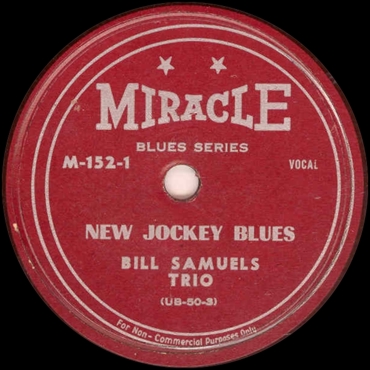
On March 25, 1950, a story in Billboard (p. 45) showed that Egalnick was getting serious about dumping catalog; it announced that he had sold 22 masters. Twelve of these were Sonny Thompson sides that went to Signature (we doubt these stayed with Bob Thiele; we don't know of any being released on his label). Meanwhile 10 Memphis Slim sides were acquired by Old Swing-Master, a company that wasn't in the best of shape itself. Egmont Sonderling ended up putting some of the Memphis Slims on his Master label instead (see the MS series above for those that Master put out in 1950). Still trying, Miracle announced two new signings, of Lynn Hope (misrendered in the article as "the Len Hope combo, of Cincinnati") and Johnny Temple. But the company was on its last legs.
The last release on Miracle was by Johnny Temple, a veteran bluesman who was born in Canton, Mississippi on October 18, 1906. Temple first recorded in 1935, when he cut 6 sides in Chicago for Vocalion. From 1936 through 1941, he recorded prolifically for Decca. His Miracle sides were not recorded at United Broadcasting Studios; they are in a matrix series not otherwise known. They appear to have been brought to Miracle by J. Mayo Williams, who knew Temple from the days when Williams ran Decca's race division. Williams had already recorded a bunch of Johnny Temple sides in 1946 (intended for his own Harlem/Chicago/Southern/Ebony operation, they ended up being dealt to Queen/King Records, which released two of them). After his previous outing for Williams, Temple had cut one side for Ora Nelle: the proto-rock-and-roll "Olds 98 Blues," but it would not see release until after his death. When he recorded Johnny Temple again and dealt the sides to Miracle, Mayo Williams was on hiatus; he had wound down his post-war record companies in 1949, and would not resume releases on his Ebony label until 1952. Williams' only other recording activity during this period was a session by R&B singer Charles Gonzales (later known as Bobby Prince), which he sold to Ivan Ballen's Gotham label.
Lynn Hope, a tenor saxophonist who would enjoy a fair amount of popularity in the 1950s, never recorded for Miracle. But in a little while, he was a Premium artist.
The same went for Ray Grant's post-Vagabond vocal group. "Miracle Records has added the Swanee Larks, new group formed by Ray Grant, formerly with the Vagabonds" (Billboard, January 28, 1950, p. 16). Miracle didn't get around to recording the Larks, but a group called the Vagabonds, assembled for the session by Ray Grant, backed Memphis Slim on his "Mother Earth" outing for Premium.
The only other Miracle artists recorded in 1950 were the Bill Samuels Trio (which was about to break up), Robert Anderson, and Eddie Chamblee.
The Bill Samuels session, in early January, produced two loungey renditions of standards featuring the leader's rather overripe baritone vocals. On "Old Black Magic," redone at this session after the previous outing failed to arrive at a satisfactory result, the group's vocal harmonies and the rhumba beat lend some interest. A ballad titled "The Things You Mean to Me" went through many takes but never lost its schmaltz. It was the two relaxed Charles Brown-style blues vocals that Miracle saw fit to release at the time, and that hold the most interest for listeners today. "I've Got the Blues" needed 3 complete takes (and take 3 was just too slow); its diskmate was done in one. In the time remaining on the session, Samuels and company ran through two other numbers. "Because" unfortunately combines corny Dixieland playing (including simulated banjo by Adam Lambert) with Country-influenced singing. "Dinah" is a better song, and Samuels' second piano solo swings instead of ricking and ticking, but corniness hasn't been banished.
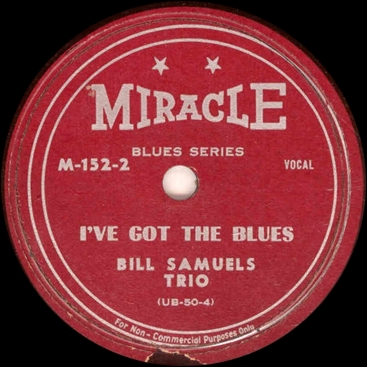
Robert Anderson cut four songs, accompanied by piano, organ, and his Gospel Caravan. "He Lives in Me" is a strong ballad-tempo performance. The rather more sentimental "Last Mile" required several tries; after all the effort, it was left in the can. Selected for immediate release were an eloquent rendition of "God Answers Prayers" and a rousing "Do You Know Him," which works off the call and response between Anderson and the Caravan.
The last session Miracle did at United Broadcasting took place on January 25, 1950. Eddie Chamblee was the leader, now far enough into R&B to be singing as well as playing tenor sax; the rest of the band consisted of Charles Stewart (baritone sax), Prentice McCarey (piano), Lefty Bates (electric guitar and steel guitar), Ernest Shepard (bass), and Osie Johnson (drums). "Easy Baby Easy," which the company left in the vault, is a rocker that features the leader's amiable solo vocal and some exciting duet work between his tenor sax and Stewart's baritone. "Jump for Joy" is pretty self-explanatory; on this upbeat blues Chamblee's vocals can be heard, along with some ensemble singing, and his and Stewart's sax work get the spotlight. Lefty Bates switches to steel guitar for this one. "Joy" and "Blue Steel" (again featuring the steel guitar) saw fleeting release on Miracle 155. "All Out" would go to Miracle and thence to Esquire, for its only release on Esquire 10-329 (not 10-330, as we long had it). Mike Rowe, who corrected our release number on the Esquire, points out that Bruyninckx also had "All Out" as one side of Miracle "159." To our knowledge there never was such a thing.
By now Miracle was having serious cash flow problems. Chamblee was paid a few weeks later by Lew Simpkins, as was Charles Stewart; Ernie Shepard received half payment. In August 1950 Chamblee brought a complaint to the Musicians Union. On September 7, 1950, the Board of Local 208 heard Chamblee's case against Lee Egalnick and Lew Simpkins; the Board ruled that Simpkins and Egalnick would have to pay Johnson, McCarey, Bates, and Shepard what was owed them (a total of $145) within 10 days or Local 208 would get their recording license cancelled by the national office of the Union. (In August 1950, that recording license was for Premium, not Miracle—see below.)
After January 25, Miracle was unable to use United Broadcasting's facilities. Not only had Egalnick and Simpkins failed to pay the musicians; the company must have owed Sonderling way too much money. (Another indication that the company owed money is that in February Cash Box dropped the two-letter abbreviation, MI for Miracle, that it used in its song charts. Such a move against a company that had earned the abbreviation and was still in business was quite unusual.) All those unissued sides from the last quarter of 1947 represented costs that the company would never recover. Miracle's total output for 1950 would be just 16 tracks.
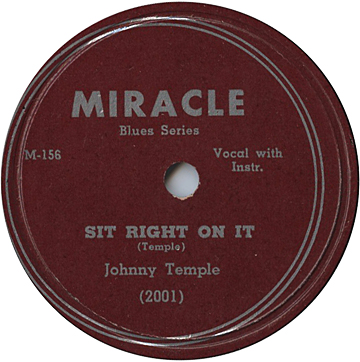
The last session to see release on Miracle was Johnny Temple's. Where it took place has not come down to posterity. Miracle 156 sounds like the product of a fairly inexpensive studio. Temple and his electric guitar were accompanied by piano, bass, and drums, players unknown. Both sides are powerful performances. Picking up the sides from Mayo Williams, Egalnick and Simpkins showed that their good taste had not deserted them, and it is a shame that this would be the bluesman's last released session. He supposedly recorded two sides for Chess in 1950, but if these were not a misreport of his Miracle sides, they have vanished without a trace. Johnny Temple died in Jackson, Mississippi, on November 22, 1968.
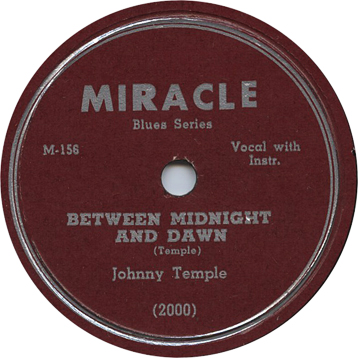
From the launch of its 100 series in December 1946, Miracle had used the same basic label design: red background and gold print (sometimes silver was used instead). The word MIRACLE was in a bowtie configuration, with the letters shorter in the middle of the word than at the ends, and stars above the bowtie. (There are some minor variations from the first few months of the 100 series; the oldest labels are plainer, like their blue-label predecessors, and some dispense with the bowtie arrangement. It appears that the older labels were used through Miracle 107; later pressings of Miracle 102, 103, and 104 used the style that is now familar.) From the mid-140s through 154, Miracle saved some money by replacing the gold print with white (and we labels with white print may have been substituted during later pressings of some items). However, in 1950 the label was significantly altered: the letters in MIRACLE were all the same size, the stars were removed, and white or silver print was employed exclusively. These 1950 labels, which can be seen on some copies of Miracle 150, and on Miracle 155 through 157, look noticeably cheaper than those they replaced.
| Matrix | Artist | Title | Release # | Recording date | Release date |
| UB 50-1 [tk. 1 - fs] | Bill Samuels Trio | Old Black Magic | unissued | early 1/50 | |
| UB 50-1 [tk. 2] | Bill Samuels Trio | Old Black Magic | unissued | early 1/50 | |
| UB 50-1 [tk. 3 - inc] | Bill Samuels Trio | Old Black Magic | unissued | early 1/50 | |
| UB 50-1 [tk. 4] | Bill Samuels Trio | Old Black Magic | unissued | early 1/50 | |
| UB 50-1 [tk. 5] | Bill Samuels Trio | Old Black Magic | unissued | early 1/50 | |
| UB 50-2 [tk. 1 - inc] | Bill Samuels Trio | The Things You Mean to Me | unissued | early 1/50 | |
| UB 50-2 [tk. 2] | Bill Samuels Trio | The Things You Mean to Me | unissued | early 1/50 | |
| UB 50-2 [tk. 3 - inc] | Bill Samuels Trio | The Things You Mean to Me | unissued | early 1/50 | |
| UB 50-2 [tk. 4] | Bill Samuels Trio | The Things You Mean to Me | unissued | early 1/50 | |
| UB 50-2 [tk. 5] | Bill Samuels Trio | The Things You Mean to Me | unissued | early 1/50 | |
| UB 50-2 [tk. 6 - inc] | Bill Samuels Trio | The Things You Mean to Me | unissued | early 1/50 | |
| UB 50-3 [tk. 1 - fs] | Bill Samuels Trio | New Jockey Blues | unissued | early 1/50 | |
| UB 50-3 [tk. 2] | Bill Samuels Trio | New Jockey Blues | Miracle 152-1 | early 1/50 | early 1950 |
| UB 50-4[tk. 1 - inc] | Bill Samuels Trio | I've Got the Blues | unissued | early 1/50 | |
| UB 50-4 [tk. 2] | Bill Samuels Trio | I've Got the Blues | unissued | early 1/50 | |
| UB 50-4 [tk. 3] | Bill Samuels Trio | I've Got the Blues | unissued | early 1/50 | |
| UB 50-4 [tk. 4] | Bill Samuels Trio | I've Got the Blues | Miracle 152-2 | early 1/50 | early 1950 |
| UB 50-5 | Bill Samuels Trio | Because | unissued | early 1/50 | |
| UB 50-6 | Bill Samuels Trio | Dinah | unissued | early 1/50 | |
| UB50-37 [tk. 1 - fs] | Robert Anderson | He Lives in Me | unissued | 1/50 | |
| UB50-37 [tk. 2] | Robert Anderson | He Lives in Me | unissued | 1/50 | |
| UB50-37 [tk. 3] | Robert Anderson | He Lives in Me | unissued | 1/50 | |
| UB50-37 [PR70] [tk. 4] |
Robert Anderson | He Lives in Me | Miracle 154 [Premium 859] |
1/50 | early 1950 |
| UB50-38 [tk. 1 - inc] |
Robert Anderson | God Answers Prayers | unissued | 1/50 | |
| UB50-38 [UB50-1065] [tk. 2] |
Robert Anderson | God Answers Prayers | [Premium 868] | 1/50 | (late 1950) |
| UB50-39 [tk. 1 - inc, damaged] | Robert Anderson | The Last Mile | unissued | 1/50 | |
| UB50-39 [tk. 2 - inc] | Robert Anderson | The Last Mile | unissued | 1/50 | |
| UB50-39 [tk. 3] | Robert Anderson | The Last Mile | unissued | 1/50 | |
| UB50-39 [tk. 4] | Robert Anderson | The Last Mile | unissued | 1/50 | |
| UB50-39 [tk. 5] | Robert Anderson | The Last Mile | unissued | 1/50 | |
| UB50-40 [cut 12, tk. 1] | Robert Anderson | Do You Know Him | unissued | 1/50 | early 1950 |
| UB50-40 [cut 13, tk. 2 - inc] | Robert Anderson | Do You Know Him | unissued | 1/50 | |
| UB50-40 [cut 14, tk. 3 - fs] | Robert Anderson | Do You Know Him | unissued | 1/50 | |
| UB50-40 [cut 15, tk. 4] | Robert Anderson | Do You Know Him | unissued | 1/50 | |
| UB50-40 [cut 16, tk. 5 - inc] | Robert Anderson | Do You Know Him | unissued | 1/50 | |
| UB50-40 [cut 17, tk. 6] [PR71] |
Robert Anderson | Do You Know Him | Miracle 154 [Premium 859] |
1/50 | early 1950 |
| UB 50-62 [tk. 1 - fs] | Eddie Chamblee and Orch. | Jump for Joy | unissued | 1/25/50 | |
| UB 50-62 [tk. 2 - inc] | Eddie Chamblee and Orch. | Jump for Joy | unissued | 1/25/50 | |
| UB 50-62 [tk. 3 - inc] | Eddie Chamblee and Orch. | Jump for Joy | unissued | 1/25/50 | |
| UB 50-62 [tk. 4] | Eddie Chamblee and Orch. | Jump for Joy | unissued | 1/25/50 | |
| UB 50-62 [tk. 5 - fs] | Eddie Chamblee and Orch. | Jump for Joy | unissued | 1/25/50 | |
| UB 50-62[tk. 6 - inc.] | Eddie Chamblee and Orch. | Jump for Joy | unissued | 1/25/50 | |
| UB 50-62 [tk. 7?] | Eddie Chamblee and Orch. | Jump for Joy | Miracle 155 | 1/25/50 | 1950 |
| UB 50-63 [tk. 1 - damaged] | Eddie Chamblee and Orch. | Easy Baby Easy | unissued | 1/25/50 | |
| UB 50-63 [tk. 2 - fs] | Eddie Chamblee | Easy Baby Easy | unissued | 1/25/50 | |
| UB 50-63 [tk. 3 - inc] | Eddie Chamblee | Easy Baby Easy | unissued | 1/25/50 | |
| UB 50-63 [tk. 4 - fs] | Eddie Chamblee | Easy Baby Easy | unissued | 1/25/50 | |
| UB 50-63 [tk. 5] | Eddie Chamblee and Orch. | Easy Baby Easy | unissued | 1/25/50 | |
| UB 50-64 (M-519-1) |
Eddie Chamblee | All Out | (Esquire 10-329) | 1/25/50 | (early 1950s) |
| UB 50-65 [F-1027] |
Eddie Chamblee and Orch. | Blue Steel | Miracle 155 [Federal 12014] |
1/25/50 | 1950 |
| 2000 | Johnny Temple | Between Midnight and Dawn | Miracle 156 | c. 3/50 | 1950 |
| 2001 | Johnny Temple | Sit Right on It | Miracle 156 | c. 3/50 | 1950 |
Miracle is known to have released 2 early singles (1057 and 1058), then 47 in the 100 series: 100 through 157, with 105, 112-118 and 120-122 missing. Since issue numbers were applied with some regularity (though records might be held for months after the initially planned issue date), the gaps seem to indicate some larger disruption to the label's plans. Four more Miracle-derived disks appeared on Master or Old Swing-Master (1000, 1010, 1020, and 1030). We will leave the Sunrise/Miracle 500 series to our Sunrise section.
A label related in complicated ways to Miracle was Sunrise, founded in April of 1947 by Leonard Evans. Headquarters were located at 307 Lenox Avenue, New York City, which was also the home of Ebony Distributors. Sunrise featured vocal, jazz, and gospel material released in a 2000 series. The label was mostly oriented to jazz, recording numerous sides by Al Hibbler (who had been Duke Ellington's vocalist for some time), as well as sides by Mercer Ellington, Earl Hines, and Johnny Hodges. Mercer Ellington produced the company's early sessions, which accounts for the heavy representation of the Duke's men. According to Art Zimmerman, there was more to the Ducal connection: Dr. Arthur Logan, Duke Ellington's personal physician, owned a share of the operation.
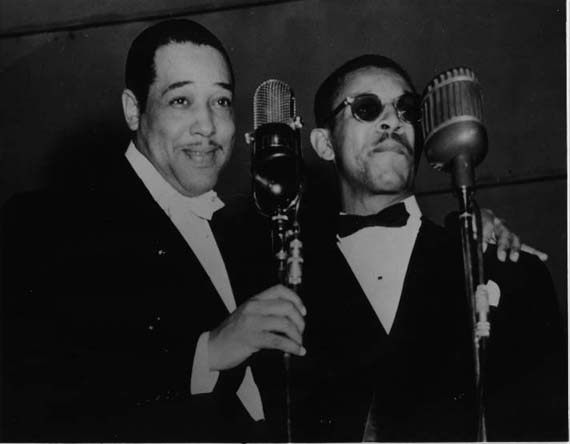
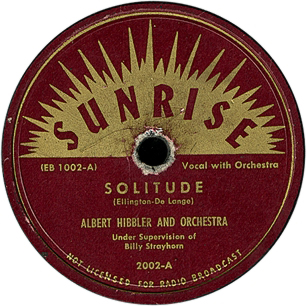
The first session for the new company took place in New York City early in 1947. Al Hibbler sang on three sides with accompaniment led by Duke Ellington's right hand man, Billy Strayhorn. Besides Strayhorn playing piano and arranging, the band consisted of Ray Nance (trumpet); Jimmy Hamilton (clarinet); Al Sears (tenor sax); Harry Carney (baritone sax); Alvin "Junior" Raglin (bass); and Fletcher Jackson (drums). With the exception of Jackson, all were members of the Duke Ellington band at the time. The fourth sides, "Feather Roll Blues," was an instrumental.
There is some confusion about couplings on Sunrise 2001. "Fat and Forty" b/w "My Little Brown Book" was advertised in Billboard on September 20, 1947, and is attested on some copies. Tom Kelly reports that the coupling described in advertisements and discographies as Sunrise 2002 is really "Solitude" (Sunrise 2002-A) b/w "Feather Roll Blues" (Sunrise 2001-B); another copy is in Robert Campbell's collection. However, Han Enderman reports a later pressing of 2002 on which "Feather Roll Blues" is correctly numbered 2002-B.
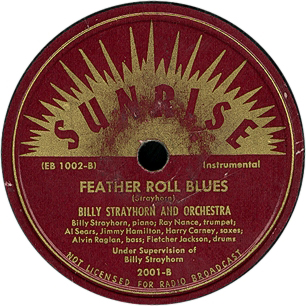
A veteran of nearly two decades with Duke Ellington, Johnny Hodges had also been recording his own combo and jump band sides since 1937. The great alto saxophonist cut four sides for Sunrise with Taft Jordan (trumpet), Lawrence Brown (trombone), Al Sears (tenor sax), Billy Strayhorn (piano), Oscar Pettiford (bass), and Wilbur De Paris (drums). All were promptly released.
A little later, Evans brought in a big band led by Mercer Ellington. The trumpet section consisted of Abdul Salaam, Dave Burns, Kenny Dorham, and Bennie Roy; the trombones were Candy Ross and Charlie Johnson; the sax section consisted of Jackie Fields (alto), Morris Lane and Alva McCain (tenors), and Henry Richards (baritone); and Luther Henderson (piano), Joe Benjamin (bass), and Heyward Jackson (drums) formed the rhythm section. One of the sides was an instrumental; another featured vocalist Billy Daniels; these saw release on Sunrise 2003. Two more sides were vehicles for Al Hibbler. Sunrise 2007, the only Hibbler relase on the label to feature such a large ensemble, failed to interest Leonard Chess, who would end up mining the other four Hibbler sessions for reissues.
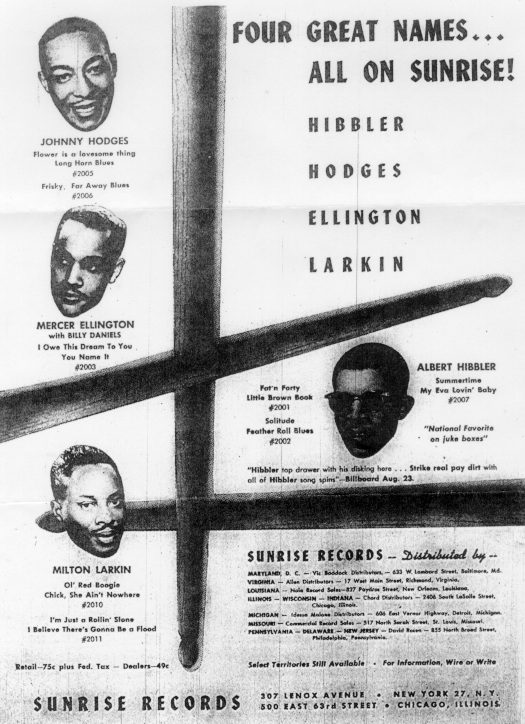
A full-page ad in Billboard on September 20, 1947, listed 8 Sunrise releases and gave two addresses for the company: 307 Lenox Avenue, New York 27, New York, and 500 East 63rd Street, Chicago. Since Miracle had been housed for some time at that Chicago address, and Ebony was distributing Miracle in New York, there was already some affiliation between the labels.
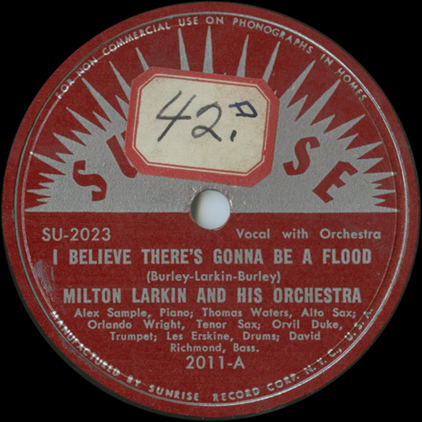
In the summer of 1947, Sunrise had branched out beyond Ellingtonia for an R&B session featuring Milt Larkin. As the leader of a big band that formed in Houston, Texas, in 1936, Larkin was responsible for bringing Tom Archia to Chicago, but his band went unrecorded, breaking up when its leader was drafted in 1943. After getting out of the military, Larkin returned to the music scene with a rhythm and blues combo, which first recorded for Sonora. By the summer of 1947, Sonora had quit making new recordings. Sunrise 2010 was advertised on September 20, 1947; has anyone seen the record? Its companion on 2011 was advertised on the same occasion; copies of this one do occasionally turn up on the collectors' market. The label to Sunrise 2011 lists the members of Milton Larkin and His Orchestra as Orvil Duke, trumpet; Thomas Waters, alto sax; Orlando Wright, tenor sax; Alex Sample, piano; David Richmond, bass; and Les Erskine, drums. Although he had played trumpet during his big band years, Larkin appears on this record strictly as a vocalist. Both sides of 2011 are conventional up-tempo R&B numbers with pleasantly rueful lyrics about relationships gone wrong.
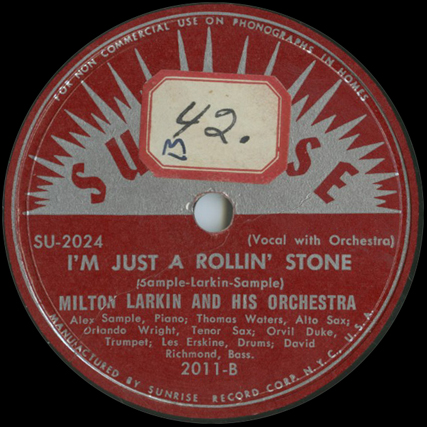
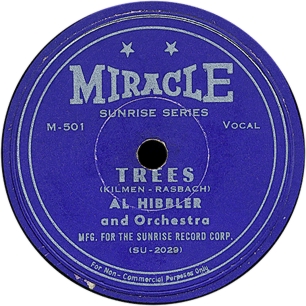
Al Hibbler returned for his third session in November 1947. It is said to have taken place in Detroit. Billy Strayhorn, who had led Hibbler's first session, returned with an ensemble consisting of Taft Jordan (trumpet), Johnny Hodges (alto sax), Al Sears (tenor sax), Harry Carney (baritone sax), Oscar Pettiford (bass), and Sonny Greer (drums). Of the three known sides from this outing, "Trees" became another when Miracle took it over and released it on Miracle 501.
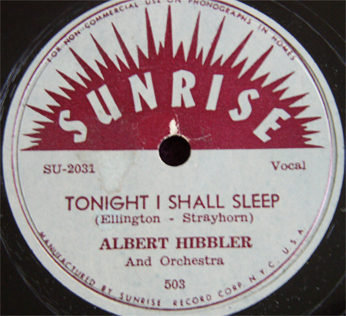

During the frantic final quarter of 1947, Sunrise extensively recorded a big band and a combo led by Earl Hines. The final Hines session featured mostly musicians borrowed from the Lionel Hampton band; Hamp's drummer Curley Hamner was listed as the leader on some of the items. A small group led by Tiny Grimes also got a little attention. Much of this material went unissued for years; it probably still isn't fully documented.
About the Tiny Grimes session we know the least. The outing is not listed in Tom Lord's Jazz Discography, either under Grimes' name, or the name of his tenor saxophonist, John Hardee (both were fairly active in the studios during the late 1940s), Just one side, "Jackie's Dance," was released; it ended up sharing Sunrise 2116 with a piece featuring Earl Hines' small group. Perhaps the shared spotlight on the guitar and the the tenor sax (Tiny Grimes and John Hardee on one side, Ernest Ashley and Thomas Crump on the other) was what prompted the coupling.

The Earl Hines items were recorded at three different sessions, all of which took place in Chicago during December 1947. The first session was intended to feature baritone vocalist Johnny Hartman and "sepia torch" Melrose Colbert. Hartman had made his first records in February 1947, for Marl Young's Sunbeam label. Melrose Colbert had been featured on Jump Jackson's session for Aristocrat in June of the same year. It was Hartman who seems to have caught the attention of Leonard Evans; he was featured on Sunrise 2014, released within a month of the session.
Accompaniment was provided by an enormous Earl Hines Orchestra: Willie Cook, Vernon "Geechie" Smith, Fats Palmer, and Charlie Anderson (trumpets); Bennie Green, Walter Harris, and Gordon Alston (trombones); Clifton Small (trombone, piano); Scoops Carey and Thomas Crump (alto saxes); Ernie Wilkins and Budd Johnson (tenor saxes); Wallace Brodie (baritone sax); Bob Wyatt (org); Skeeter Best or Billy Mackel (guitar); Calvin Ponder (bass); Gus Johnson (drums). A string section was added to some of the numbers, and violinist Eddie South made a guest appearance on "Ain't Misbehavin'."
Next, Earl Hines recorded with what was loosely referred to as a quartet. Besides Thomas Crump (tenor sax) and Ernest Ashley (guitar), the shifting personnel included Eddie South (violin) along with Bob Wyatt (organ) and a bass player and a drummer.

Finally, as the recording ban was about to hit, Hines presided over an ensemble that consisted mostly of members of the Lionel Hampton band of the period: Duke Garrette (trumpet); Bobby Plater (alto sax and clarinet); Morris Lane (tenor sax); Charlie Fowlkes (baritone sax); Billy Mackel (guitar); Charles Mingus (bass); and Curley Hamner (drums). One "Bill Dougherty" was on hand to play violin; Anthony Barnett has made a pretty good case that this was in fact Eddie South. Singers Wini Brown and Roland Burton were also on hand. Although this session has been placed in Hollywood (probably on account of Charles Mingus's involvement), Chicago seems to be the correct location.
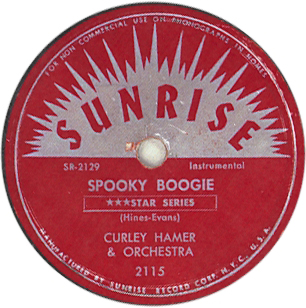
Again, much of the session was left in the can. However, Sunrise 2115 was released fairly promptly with Curley "Hamer" credited as the leader. The other single from the session, the extremely obscure Sunrise 525, was released after the company folded; it was credited to Wini Brown.
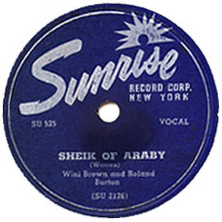

Sunrise also ventured into gospel during the last quarter of 1947. One of the great jubilee groups, the Dixieaires, recorded prolifically from 1947 into 1950. One of the group's biggest blocks of masters was laid down in two sessions for Sunrise. As in their recordings for other labels, the Dixieaires mixed in a few R and B and novelty numbers. The Dixieaires were founded in early 1947, after J. C. Ginyard, already a veteran of the gospel scene, left the Jubilaires to form his own group. Caleb Nathaniel Ginyard Jr. was born in South Carolina in 1910.

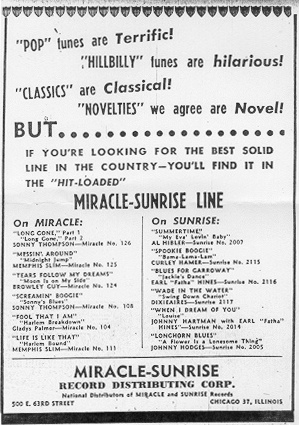
On February 21, 1948, Billboard mentioned that "Miracle platters" were "mulling a deal link with another race label." Sure enough, a month later Miracle took over the distribution and marketing of Sunrise in a joint venture with Evans (see the announcement in Billboard, "Miracle Sets Deal to Peddle Race Wax," March 27, 1948, p. 34). One wonders whether Mayo Williams, whose New York office shared its address with Sunrise, helped to bring the parties together. Evans' company had run its costs up recording a large number of masters (at least 50 are known, out of the 120 reported) during the rush to beat the recording ban. He badly needed a better distribution network for his records. But Evans was never happy with the arrangement. While the deal was in force Sunrise would be responsible for just one new recording session, featuring Al Hibbler.
Miracle announced that it would be "completely eliminating the hot jazz masters, and will emphasize the race platters in the catalog only." The first releases announced in the new set-up were disks by the Dixieaires and the Curley Hamner Combo, which appeared with Sunrise labels on them. In December 1948, Miracle scored a national hit with the Sunrise recording of Al Hibbler singing "Trees." In Cash Box for December 22 (p. 9), Miracle 501 was already being described as a "clickeroo number." On March 5, 1949, Cash Box noted, "Lee Egalnick still on road and his 'Trees' growing bigger and bigger wherever Lee stops to visit with distribs." All of the items mentioned in these articles had been recorded in the last quarter of 1947.
The only new recordings to come out of Sunrise during its semi-merger with Miracle were again by Al Hibbler. The session took place in Chicago, probably during the latter part of 1948 after the recording ban was no longer being rigidly enforced, but before the release of "Trees." The three known sides featured another Strayhorn-led group with Ray Nance (trumpet), Tyree Glenn (trombone, vibes), Ben Webster (tenor sax), Alvin "Junior" Raglin (bass), and Fletcher Jackson (drums). Webster, whose presence was duly signaled on the label to Sunrise 515, was with Duke Ellington for most of 1948.
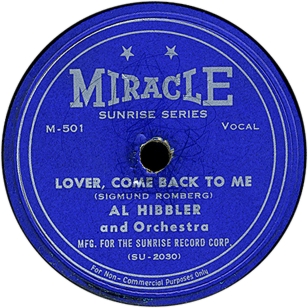
Miracle 501 kept selling. Sunrise wasn't making new records. Leonard Evans' discontentment grew.
On April 30, 1949, Billboard reported that "Miracle has split with the Sunrise label, with future Sunrise sides to be released on a new Sunrise label. Lee Egalnick will continue to head Sunrise distribution and Lou [sic] Simpkins will be a. and r. chief, but Leonard Evans, who turned Sunrise over to Miracle, will return as prexy of the label" (p. 42). An item one paragraph down, in the very same issue of Billboard, reported that Evans was cutting Al Hibbler sides, backing provided by a Chicago band led by alto saxophonist Willie Randall. (The old Sunrise masters in Miracle's possession were returned to Evans.)
Although there were other releases on the post-Miracle Sunrise label, Al Hibbler's fifth recording session, during the last week of April 1949, was the label's last. Some attention to the personnel might yield dividends. Willie Randall had been a member of Al Benson's All Stars, whose recording session done a few months earlier was released in 1949 on Old Swing-Master.
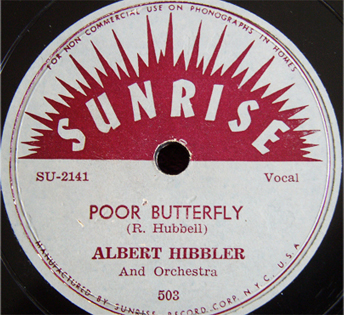
In May 1949, Evans allegedly recorded a session with Eddie Chamblee and six other musicians. Evans stiffed Chamblee and his sidemen on payment, with the result that Sunrise lost its recording license in September. Or so we are told. (Musicians Union Local 208 finally caught up with Evans in Chicago in 1956 and Chamblee and his sidemen got their checks—a full 7 years later.) This is an odd story in more than one way: Chamblee was under contract to Miracle, not to Sunrise, and no releases are known from any session of his carried out in May 1949. We wonder whether this was really Chamblee's Miracle session with 7 pieces from the summer of 1948, postdated to keep the Union off the company's case. But in that case we wonder why Evans would be willing to take the fall for Lee Egalnick, unless he had been covering for Egalnick at a time of low cash flow, or had already decided to get out of the business himself. (Egalnick was completely out of the music business and living in Texas when Evans finally paid up.) The Chamblee debacle suggests that Miracle and Sunrise were not fully disentangled after the announcement on April 30, 1949.
September 1949 marked an end to new recording for Sunrise, but not quite to singles with "Sunrise" on the label. Cash Box still thought it newsworthy on October 15 (p. 9) that Monroe Passis of Chord Distributors had recently acquired the Sunrise line. However, on September 17, Harry Fox, the powerful rights agent for music publishers, had filed suit against three record companies because they hadn't paid royalties (Billboard, September 24, 1949, p. 16). One of the three was Sunrise, said to be "of Chicago." Getting sued by Harry Fox was a reliable indicator that a record company was failing. The other two companies named in the suit, Tower and Manor, would be gone by the beginning of 1952 and the end of 1950, respectively.
Blues Research asserts that the 500 series was begun after the Miracle-Sunrise split: "four releases are known in this series, but two other issues are known on the Miracle 500 series, labeled 'Sunrise Series: manufactured for the Sunrise Record Co.'" The publication says that 501 and 507 were Miracle releases. They were, but we've incorporated them into the Sunrise listing below. Miracle M-501, Al Hibbler's "Trees," came out in December 1948, before the Miracle-Sunrise split; it used a Miracle "bowtie" label, except the background was blue and the print was silver. (In our table, an entry in italics indicates that the original session has already appeared higher up in the list, but the title is being repeated for readability.) Miracle M-507 was announced as a new release in Billboard on May 7, 1949 (p. 106); it had been in the works before the split. Sunrise 503, 515 and 520 are definitely post-split. Sunrise 525 isn't just post-split. It has different labels from any other Sunrise we have seen, and it postdates the shutdown of the company.
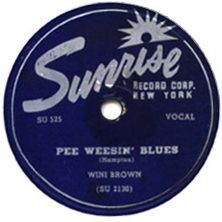
There are many gaps in the Sunrise issue series. Supposedly there were 120 masters at the time of the pact with Miracle, which would imply that the big holes in our table of the EB1000 / SU2000 matrix series were occupied by up to 70 other sides. It would make sense if there were a Sunrise 2004 with matrix numbers EB 1007 and 1008, but we haven't heard of such an issue. Nor do we know of any Sunrise 2008 or 2009.
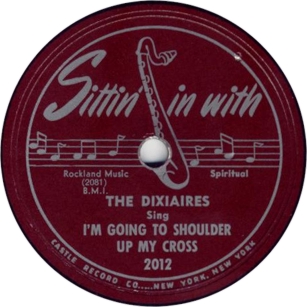
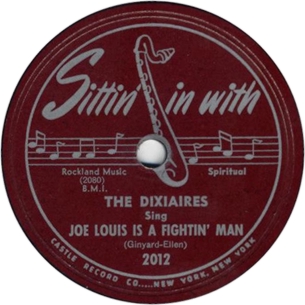
There is no 2012 or 2013. It looks as though these were supposed to be singles by the Dixieaires; these numbers were apparently inherited by the Sittin' in with... label. To further complicate things, there was confusion about the matrix numbers on 2082 through 2084; there were (correspondingly) two versions of Sittin' in with... 2013. Both carried "When That Great Ship Went Down" on one side, but the flips were different. These SIWs were followed by a known Sunrise release on Sunrise 2014.
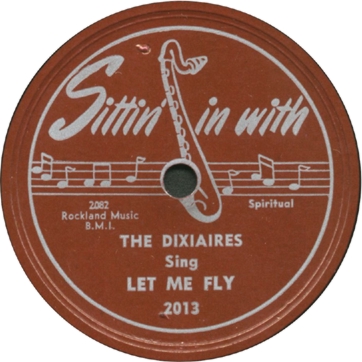
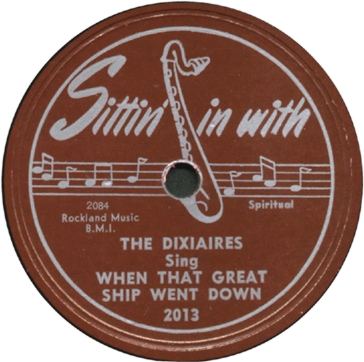
After 2014, the Sunrise serial numbers skipped a hundred to 2115 and continued in this fashion to 2118. The very last Sunrise release in the original series is S-319 (the S prefix indicates the involvement of Bob Shad's Sittin' in with operation). The release date for S-319 is said to be 1950—after the original Sunrise operation had shut down.


| Matrix | Artist | Title | Release # | Recording date | Release date |
| EB-1001-A (in wax, EB1001) |
Albert Hibbler and Orchestra | Under Supervision of Billy Strayhorn | Fat and 40 | Sunrise 2001-A [Chess 1569] |
early 1947 [May 1954] |
4/1947 |
| EB1002 (EB 1002-A on label) |
Albert Hibbler and Orchestra | Under Supervision of Billy Strayhorn | Solitude | Sunrise 2002-A [Chess 1457] |
early 1947 | 4/1947 [April 1951] |
| EB-1001-B (in wax, EB1003A) |
Albert Hibbler and Orchestra | Under Supervision of Billy Strayhorn | My Little Brown Book | Sunrise 2001-B [Chess 1481] |
early 1947 | 4/1947 [November 1951] |
| EB1004 (EB 1002-B on label) |
Billy Strayhorn and Orchestra | Under Supervision of Billy Strayhorn | Feather Roll Blues | Sunrise 2001-B Sunrise 2002-B [Chess 1457]< |
early 1947 | 4/1947 [April 1951] |
| EB1005 | Mercer Ellington & Orchestra | You Name It | Sunrise 2003B | Spring 1947 | 9/1947 |
| EB1006 | Billy Daniels with Mercer Ellington & Orchestra | I Owe This Dream to You | Sunrise 2003A | Spring 1947 | 9/1947 |
| SR 1009 | Johnny Hodges and Orchestra | A Flower Is a Lovesome Thing | Sunrise 2005 A | prob. Spring 1947 | 9/1947 |
| SR 1010 | Johnny Hodges and Orchestra | Frisky | Sunrise 2006-B | prob. Spring 1947 | 9/1947 |
| SR 1011 | Johnny Hodges and Orchestra | Longhorn Blues | Sunrise 2005-B | prob. Spring 1947 | 9/1947 |
| SR 1012 | Johnny Hodges and Orchestra | Far Away Blues | Sunrise 2006-A | prob. Spring 1947 | 9/1947 |
| SU1018 | Albert Hibbler with Mercer Ellington & Orchestra | My Ev'a Lovin' Baby | Sunrise 2007-B | prob. Spring 1947 | 9/1947 |
| SU1019 | Albert Hibbler with Mercer Ellington & Orchestra | Summertime | Sunrise 2007A | prob. Spring 1947 | 9/1947 |
| SU? | Milton Larkin and His Orchestra | Ol' Red Boogie | Sunrise 2010A | 1947 | 9/1947 |
| SU? | Milton Larkin and His Orchestra | Chick, She Ain't Nowhere | Sunrise 2010B | 1947 | 9/1947 |
| SU-2023 | Milton Larkin and His Orchestra | I Believe There's Gonna Be a Flood | Sunrise 2011-A | 1947 | 9/1947 |
| SU-2024 | Milton Larkin and His Orchestra | I'm Just a Rollin' Stone | Sunrise 2011-B | 1947 | 9/1947 |
| SU 2027 | Tiny Grimes & Orchestra (John Hardee Tenor Solo) | Jackie's Dance | Sunrise 2116 | 11/47? | early 1948 |
| SU-2029 | Al Hibbler and Orchestra | Trees | Miracle M-501 [Chess 1456] |
11/47 | 11/48 [March 1951] |
| SU-2030 | Al Hibbler and Orchestra | Lover Come Back to Me | Miracle M-501 [Chess 1456] |
11/47 | 11/48 [March 1951] |
| SU 2031 | Albert Hibbler and Orchestra | Tonight I Shall Sleep | Sunrise 503 | 11/47 | 1949 |
| SU 2038 | Earl "Fatha" Hines and Orchestra (Vocal: Johnny Hartman) | When I Dream of You | Sunrise 2014 | early 12/47 | 1/1948 |
| SU2039? | Earl Hines Orchestra, Johnny Hartman vocal | Ain't Misbehavin' | [Bravo K134] | early 12/47 | [?] |
| SU2040? | Earl Hines Orchestra, Melrose Colbert vocal | Black and Blue | [Bravo K134] | early 12/47 | [?] |
| SU2041? | Earl Hines Orchestra, Johnny Hartman vocal | I Need a Shoulder to Cry On | [Bravo K134] | early 12/47 | [?] |
| SU2042? | Earl Hines Orchestra | unidentified title | unissued | early 12/47 | |
| SU2043? | Earl Hines Orchestra | unidentified title | unissued | early 12/47 | |
| SU 2044 | Earl "Fatha" Hines and Orchestra | Louise | Sunrise 2014 | early 12/47 | 1/1948 |
| C2069 | The Dixieaires | Don't Let That Worry You | (Sittin' in with ... 553) | 12/47 | (1950) |
| C2070 | The Dixieaires | Pray | (Sittin' in with ... 553) | 12/47 | (1950) |
| SU-2077 | The Dixieaires | Swing Down Chariot | Sunrise 2117 | 12/47 | 3/1948 |
| SU-2078 | The Dixieaires | Wade in the Water | Sunrise 2117 | 12/47 | 3/1948 |
| SU2079 | The Dixieaires | Run on for a Long Time | Sunrise 2118 | 12/47 | 3/1948 |
| 2080 | The Dixiaires [sic] | Joe Louis Is a Fightin' Man | (Sittin' in with ... 2012) | 12/47 | |
| 2081 | The Dixiaires | I'm Going to Shoulder Up My Cross | (Sittin' in with ... 2012) | 12/47 | |
| 2082 | The Dixiaires [sic] | Just Getting Ready | (Sittin' in with ... 2013, DJ copy) | 12/47 | |
| 2082 [sic] | The Dixiaires | Let Me Fly | (Sittin' in with ... 2013) | 12/47 | |
| 2084 2083 on label of DJ copy] |
The Dixiaires | When That Great Ship Went Down | (Sittin' in with ... 2013) | 12/47 | |
| SU-2085 | The Dixieaires | My God Call Me This Morning | Sunrise S-319 | 12/47 | 3/1948 |
| SU-2086 | The Dixieaires | You Better Run | Sunrise S-319 | 12/47 | 3/1948 |
| The Dixieaires | Little Wooden Church | Sunrise 2118 | 12/47 | 3/1948 | |
| SU 2120 C | The Earl Hines Combo | Solos: E. Ashley—guitar T. Crump—tenor | Blues for Garroway | Sunrise 2116 | between 12/19 and 12/23/47 | [?] |
| SU2122? | Earl Hines & His Orchestra | Honeysuckle Rose | [Bravo K134] | between 12/19 and 12/23/47 | [?] |
| SU2123? | Earl Hines & His Orchestra | Dark Eyes | [Bravo K134] | between 12/19 and 12/23/47 | [?] |
| SU2124? | Earl Hines & His Orchestra | No Good Woman Blues | [Bravo K134] | 12/31/47 | [?] |
| SU2125? | Earl Hines & His Orchestra | Bowlegged Mama | [Bravo K134] | 12/31/47 | [?] |
| SU 2126 | Wini Brown and Roland Burton | Sheik of Araby | Sunrise SU 525 | 12/31/47 | [?] |
| SU2127? | Earl Hines & His Orchestra | My Name Is on the Doorbell | [Bravo K135] | 12/31/47 | [?] |
| SU 2128-A(misprinted SR- on label) | Wini Brown with Curley Hamer [sic] & Orchestra | Bama Lama-Lam | Sunrise 2115 | 12/31/47 | 3/1948 |
| SU 2129-A (misprinted SR- on label) | Curley Hamer [sic] & Orchestra | Spooky Boogie | Sunrise 2115 | 12/31/47 | 3/1948 |
| SU 2130 | Wini Brown | Pee Weesin' Blues | Sunrise SU 525 | 12/31/47 | [?] |
| SU2131 | |||||
| SU2132 | |||||
| SU2133 | Al Hibbler & His Orchestra | Ghost of Love | Sunrise M-520 | 1948 | 1949 |
| SU2134 | Al Hibbler | Vocal with Orchestra | Tenor Solo—Ben Webster | Hey Baby | Sunrise SU515 | 1948 | 1949 |
| SU-2135 | Al Hibbler and Orchestra | It Don't Mean a Thing | [Chess 1455] | 1948 | [March 1951] |
| SU2136 | |||||
| SU2137 | |||||
| SU2138 | |||||
| SU2139 | |||||
| SU-2140 | Al Hibbler and Orchestra | What Will I Tell My Heart? | [Chess 1455] | 4/49 | [March 1951] |
| SU 2141 on label [SU 2041 in wax on some copies, S-2040 on others] |
Albert Hibbler and Orchestra | Poor Butterfly | Sunrise 503 [Chess 1569] |
4/49 | 1949 [May 1954] |
| SU2142-2 | Al Hibbler | Vocal with Orchestra | I Love You | Sunrise SU515 [Chess 1481] |
4/49 | 1949 [November 1951] |
| SU2143 | Al Hibbler & His Orchestra | By The River Ste. Marie | Sunrise M-520 | 4/49 | 1949 |
| UB21886 | Gladys Palmer | Song Man | Miracle M-507 | c. 10/26/47 | 5/1949 |
| UB21981 | Gladys Palmer | Later On | Miracle M-507 | c. 11/5/47 | 5/1949 |

In all, Sunrise put out 14 known singles in the label's original series with the mutating prefixes: 2001, 2002, 2003, 2005, 2006, 2007, 2010, 2011, 2014, 2115, 2116, 2117, 2118,and finally (via Sittin' in with...)S-319. There were 6 releases that we know of in the hybrid Miracle/Sunrise 500 series: 501, 503, 507, 515, 520,and 525. 501 and 507 were issued with Miracle labels. Essentially, Miracle had to throw in 507, which was a Miracle recording all the way, after displeasing Sunrise by issuing 501, a Sunrise recording, with Miracle labels. 503, 507, 515, 520, and 525 all carried Sunrise labels of some kind.
The closure of Sunrise preceded the bankruptcy of Miracle by just a few months. If Miracle had controlled the Sunrise masters when it filed for bankruptcy, the IRS would have impounded them and they would have ended up at King. They weren't still with Miracle, because Sid Nathan didn't get them. All were aparently in the hands of Leonard Evans.
The Johnny Hodges and Mercer Ellington sides were taken over first by Mercer Ellington's Mercer label and sold later on to Bob Weinstock's Prestige label.
It was Leonard and Phil Chess who got the Sunrise material with the most commercial potential. Cash Box announced on February 24, 1951 (p. 9) that the Chess brothers had bought the Al Hibbler masters. Chess sold a lot of Hibbler 78s and 45s in 1951 and was still issuing Al Hibbler on singles in 1953. As late as 1955, the brothers reserved their first long-playing release, Marterry/Argo LP 601, for 10 of Hibbler's Sunrise recordings.

A big block of sides by the Dixieaires ended up in the hands of producer Bob Shad of Castle and Sittin' in with. The very last Sunrise release, S-319, looks like the work of Shad's operation; thereafter, previously unissed sides by the group appeared on Shad's SIW label. We suspect that Shad also got his mitts on the Earl Hines material, and was involved in the belated release of Sunrise 525.

When Lee Egalnick left Miracle in May 1950, and Lew Simpkins closed the company in June, neither had any intention of quitting the record business. Egalnick promptly opened a new label called Premium, where Simpkins joined him the next month. Premium, which was able to keep going for a little over a year, would record some of the former Miracle artists and recruit some new ones.
On November 4, 1950 Billboard reported that King Records had purchased 165 Miracle masters and roughly 50,000 Miracle platters from the Internal Revenue Service, which was obviously owed a lot in taxes. King paid $4,700 for everything ("Buys Miracle Masters," p. 24; the story was datelined Chicago, October 28). There were masters by Memphis Slim, Eddie Chamblee, Tommy Dean, Gladys Palmer, and Sonny Thompson. In fact, King acquired everything that Miracle still had when it closed. Items that had been turned over to Egmont Sonderling and released on Master or Old Swing-Master were not included; neither was anything from Sunrise. It would be interesting to know whether King, with all of those platters in inventory, pasted its own labels on Miracle pressings—we haven't spotted anything like this.
King didn't expect to use its flagship label for this material. Because Sonny Thompson was under contract to King, "Long Gone" was reissued on King 4438 in 1951. King was starting to issue 45s in 1951, so it was also available in the new format. In 1953 or so, part 2 of "Long Gone" was included on Thompson's King EP-209; the other tracks had been recorded after he changed labels.
Other reissues (occasionally, issues) of Miracle material were allocated to the company's Federal subsidiary, which was being launched as the acquisition took place. Miracle-derived sides appeared in the 12000 R&B series on Federal (there was a parallel 10000 series for Country). They all appeared in the first few batches of releases, in 1951, and we wonder how well any of them sold. None of them are easy to find today, and we also don't know how many were issued on 45, which King started using in 1951, as well as 78. According to Michel Ruppli, The King Labels: A Discography, Volume 2, tracks from Miracle appeared on Federal 12004, 12005, 12006, 12007, 12013, 12014, 12015, 12018, 12019, 12021, 12026, 12027, 12031, 12032, and 12033.
We have listed King and Federal releases in brackets where we know of them. A few may have eluded us.
When the Miracle acquisition was announced, Syd Nathan also controlled the DeLuxe label, which he had taken over in August 1949. Miracle masters didn't show up on this edition of DeLuxe, which became inactive in May 1952, or on the revived DeLuxe that opened in September 1953.
However, two previously unissued Sonny Thompson sides showed up on Rockin', a shadowy label that was a King subsidiary without being opernly acknowledged as such. Produced Henry Stone started Glory (for gospel) and Rockin' (for blues or R&B) in Miami, Florida in 1952. King's Miami office distributed the labels, which sometimes used material that had been recorded for King or tunes copyrighted by Lois Music (King's original house publisher). At some point in 1953, Rockin' 521 was released, featuring two titles credited to someone called Royal Brent. Each side carrried a matrix number in the GR 15000 series for Glory and Rockin'. But Ruppli's discography of King and associated labels supplies the original matrix numbers, which are from two Sonny Thompson sessions for Miracle. Neither "Sugar Bun" (originally titled "Dreams") nor "Danny Boy" had appeared on Miracle, or Old Swing-Master, or King, or Federal. But "Royal Brent" was credited as the vocalist on one side of King 4470, a Thompson single from 1951. Sonny Thompson didn't like to call attention to his occasional work as a vocalist when he was a Miracle artist, and he obviously continued the policy on King. He hadn't used a pseudonym on Miracle, but now Sonny Thompson the singer became "Royal Brent." It would be nice to find a copy of Rockin' 521, if anyone has seen it; it must be an extreme rarity. A good chunk of Rockin's output was reissued in the new DeLuxe's 6000 series; Stone reportedly owned 50% of the new DeLuxe and the GR 15000 series continued on new recordings made for it. But, according to Ruppli, not Rockin' 521. In the meantime we have no way of knowing which take of either piece appeared on this single.
Through its own deal with King, the British Esquire label put out some material of Miracle origin in the early 1950s; we have indicated these releases when we have information on them. These are of interest in their own right, but are more poorly documented than than any of the other King-derived releases.
It doesn't appear that King pulled in a lot of revenue from the acquisition. But most of the Miracle masters have passed undamaged from Syd Nathan's King to various successor entities, and for that we have reasons to be grateful.
Our thanks to Anthony Barnett, Armin Büttner, Nadine Cohodas, Bill Daniels, Otto Flückiger, Ferdie Gonzalez, Daniel Gugolz, Robert Javors, Billy Vera, Eric LeBlanc, Dave Penny, J. C. Marion, and Dr. Mary Unger. Matrix numbers that have been verified from the actual 78s or masters are indicated in bold; we are especially indebted to Robert Javors and Tom Kelly for checking the records in their collections. Art Zimmerman and Dan Kochakian provided additional information about Miracle and Sunrise 78s in their collections.
Tom Lord's Jazz Discography has been helpful with the personnel for some sessions, and in tracing material that ended up on King, Federal, or Esquire. Tom Kelly has confirmed or corrected many entries from his extensive holdings of Miracle, Sunrise, Master, and Old Swing-Master 78s; Mike Kredinac provided dubs and label copy for additional rare sides. Dieter Hartmann corrected our information on the Tommy Dean releases.
Bill Daniels gave us a great many more release dates. Marty Rothenberg turned up a variant pressing of Miracle 503 with the wrong matrix number in the wax. Bernd Kratochwil's article, "Die Geschichte des Entrepreneur Al Benson aus Chicago: Teil 2 Old Swingmaster Discography," Rockin' Fifties, 1997, pp. 45-49, was a valuable source of information about the Old Swing-Master label. Gospel discographer Bob Laughton identified further masters by the Dixieaires that remained unissued by Sunrise but were picked up by Bob Shad and put out on his label Sittin' in with. Mike Callahan's Chess Story at http://www.bsnpubs.com/chesscheck.html provides well-researched discographies for LPs on Chess and its associated labels, which helped us track the fate of masters purchased by that company.
Dani Gugolz provided additional M-500 matrix numbers for Sonny Thompson tracks that were later sold by Miracle, and established that "Sonny's Return," "House Full of Blues," and "Blues" (depending on whose issue you consult) are all in fact the same recording. Check out Sonny Thompson 1946-1948 (Blue Moon BMCD 6024), which also includes the second Dick Davis session. We were able to improve our Memphis Slim coverage by consulting Memphis Slim: The Complete Recordings Vol. 2: 1946-1948 (Blues Collection [Fr] CD 159862) and The Complete Recordings Vol. 3: 1948-1950 (Blues Collection [Fr] CD 160142), which both include helpful liner notes by Jean Buzelin. (One picky: Buzelin mixes up Alex Atkins, a Memphis native who played alto sax in Memphis Slim's combo, with Boyd Atkins, who enjoyed the distinction of playing soprano sax behind Louis Armstrong on a 1927 recording and tenor sax behind Elmore James on recordings from 1953 and later.)
A crucial guide to unreleased Miracle sides (as well as some that were issued on other labels without their original matrix numbers) is a list provided to us by Peter Gibbon of Ace Records (March 7, 2005, revised January 19, 2006). It contains Miracle masters that were acquired by King Records in October 1950; in November 2004 these were made available to Ace for its ongoing reissue series.
Finally, we thank Paul Ressler for three superb Miracle publicity photos from 1948 and Scott Arnold for a period photo of the Memphis Slim group.